

BY
JULIA McNAIR WRIGHT
D. C. HEATH & CO., PUBLISHERS
BOSTON NEW YORK CHICAGO
[Pg iii]
SEASIDE AND WAYSIDE NATURE READERS.
By JULIA McNAIR WRIGHT.
Seaside and Wayside Nature Reader, No. 1.
Describes Crabs, Wasps, Spiders, Bees, and some Univalve Mollusks.
Seaside and Wayside Nature Reader, No. 2.
Describes Ants, Flies, Earthworms, Beetles, Barnacles, and Star-fish.
Seaside and Wayside Nature Reader, No. 3.
Has chapters on Plant-life, Grasshoppers, Butterflies, and Birds.
Seaside and Wayside Nature Reader, No. 4.
Has chapters on Geology, Astronomy, World-life, etc.
D. C. HEATH & CO., PUBLISHERS.
Copyright, 1888 and 1901,
By JULIA McNAIR WRIGHT.
[Pg iv]
To the Boys and Girls:—
In this book we shall wander together a little farther, by the seaside and by the wayside. Sometimes we shall walk on the breezy hills; sometimes in the low, marshy places, where ferns and rushes grow.
Sometimes we shall stroll along the wayside path, where the wild-flowers and grasses are woven into a wreath.
Sometimes we shall go to the hard, white sand, where the ocean waves roll to our feet, and bring us shells and curious treasure from the sea. Again, we shall go down to the still ponds, where lilies float on the water and dragon-flies swim in the air.
Wherever we go, let us keep our eyes open and our minds awake to the lessons of Nature. Then we shall be able to learn what beauty and wisdom lie hid, even in such humble things as flies and worms. We shall find much to delight us in beetles; and be as happy as kings while we search out the secrets of airy hunters and marvellous little fishes.
[Pg v]
[Pg vi]
| LESSON | PAGE | |
| I. | A Look at an Ant | 1 |
| II. | The Life of an Ant | 4 |
| III. | The Ant’s Home | 9 |
| IV. | The Ants at Home | 13 |
| V. | The Ants on a Trip | 16 |
| VI. | The Farmer Ants | 20 |
| VII. | Ants and Their Trades | 24 |
| VIII. | The Slave Ants | 28 |
| IX. | Wonder Ants | 31 |
| X. | The Ways of Ants | 34 |
| XI. | Mr. Worm and his Family | 39 |
| XII. | Mr. Earth-worm at Home | 42 |
| XIII. | Mr. Worm at Work | 46 |
| XIV. | Mr. Worm’s Cottage by the Sea | 49 |
| XV. | Mr. Worm at Home | 52 |
| XVI. | A Look at a House-fly | 56 |
| XVII. | How to Look at a Fly | 59 |
| XVIII. | Mrs. Fly and her Foes | 63 |
| XIX. | Of what Use are Flies | 66 |
| XX. | A Swarm of Flies | 68 |
| XXI. | Some Queer Flies | 71 |
| XXII. | In Armor Clad | 73[Pg vii] |
| XXIII. | When Mr. Beetle was Young | 78 |
| XXIV. | How to Learn about Beetles | 81 |
| XXV. | The Rose Beetle | 84 |
| XXVI. | Princes and Giants | 88 |
| XXVII. | The Little Sexton | 92 |
| XXVIII. | The Story of the Stag Beetle | 97 |
| XXIX. | Mr. Beetle Seeks for a Home | 101 |
| XXX. | The Little Water-men | 105 |
| XXXI. | Whirligig Beetles | 110 |
| XXXII. | What a Fisherman Told | 113 |
| XXXIII. | Mr. Barnacle and his Son | 116 |
| XXXIV. | A Fishing Party | 121 |
| XXXV. | A Last Look at Mr. Barnacle | 125 |
| XXXVI. | Flowers of the Sea | 127 |
| XXXVII. | The Life of a Jelly-fish | 131 |
| XXXVIII. | Sea-stars | 137 |
| XXXIX. | A Sea-change | 141 |
| XL. | The Star-fish with an Overcoat | 145 |
| XLI. | The Flying Flowers | 151 |
| XLII. | Under the Water | 155 |
| XLIII. | A Happy Change | 160 |
| XLIV. | The Dragon-fly and his Cousins | 164 |
| XLV. | The Wings of the Dragon-fly | 167 |
| Review Lessons | 173 |
[Pg 1]
A LOOK AT AN ANT.
You have been told[1] that an insect is a living creature with a body made in rings, and divided into three parts. Most insects have six legs, four wings, and two feelers.
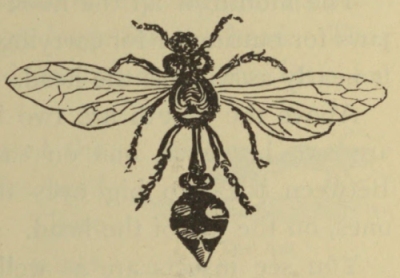
There is a great Order of insects which we shall call the hook-wing family.
The wasp, the bee, the saw-fly, and ant belong to this family. They are the chief of all the insects. They can do many strange and curious things.
You will know insects of this great family by their wings. The front wings are larger than the[Pg 2] back ones. They fold back over them when at rest.
In flight the upper wings hook fast to the lower.[2]
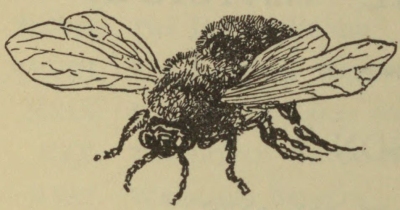
If you look carefully at some kinds of insects, you will soon think I have told you what is not quite true. Why will you think that? You will say to me, “The fly has two wings, and not four.” “The ant has no wings at all.”
Ah, but wait until you study about ants and flies, and see what you will think then.
The mouth of all the hook-wing insects has two jaws for cutting or for carrying things. The mouth is nearly as wide as the head.

Above the mouth are two knobs. These knobs are two big eyes, one on each side of the head. Between the two big eyes they have some little ones, on the top of the head.
You see insects are as well supplied with eyes as crabs are with legs.
The back part of the body of many insects is made fast to the middle part by a small joint, or thread. That is because these insects need to bend, or even double up, in some of their work.
[Pg 3]
The Hook-wing Order is divided into two great kinds.

The insects of one kind carry a little saw. The others carry a sword. The sword is a sting. The saw is to cut up leaves and wood to make nice soft nests or houses for the eggs. The sword is to fight with, or to kill things for food. Among the saw-carriers is the fine, long fly, called a saw-fly. Bees, ants, wasps, and others carry the sting.
Get one of these insects, and you will see all the parts of which I have told you. Let us first take an ant to look at.
The head of an ant seems very large for its body, and the eyes seem very large for the head. They look as if they would be heavy for the little ant to carry.
On the under part of the body which is next the head are set the six legs. These legs and the feet have joints.
On the upper side of this same second part of the body are set the wings. There are four wings, two large and two small ones. The upper pair are larger than the lower ones.
The third or back part of an ant’s body is made of six rings. On the tip or pointed end of this hind part is the sting.
[Pg 4]
Now I hear you cry out, “O, my ant has no wings!” Well, let me tell you a secret. The wings of your ant have been cut off, or unhooked, as you shall hear by and by.
There are many families of ants. Each has its own name and its own ways. All ants are very wise in their actions. I shall tell you many strange things about them. Ants have always been called “the wise insects.” Would you not like to learn about their homes, their children, and their way of life?
Before you study the ants in any book, I wish you would go out into your garden or into the fields. Find an ant-hill, and sit or lie by it for an hour or so. Take some sugar or bits of cake to feed the ants. Find out for yourselves all that you can about them. Facts that you learn in this way will be worth very much to you. Be careful and do not disturb the hill or alarm the ants.
THE LIFE OF AN ANT.
In ant-hills we find drone ants, queen ants, and worker ants. The drone ants have no sting and do no work. Their bodies are longer and more slim[Pg 5] than those of queens. The drone ants have wings.
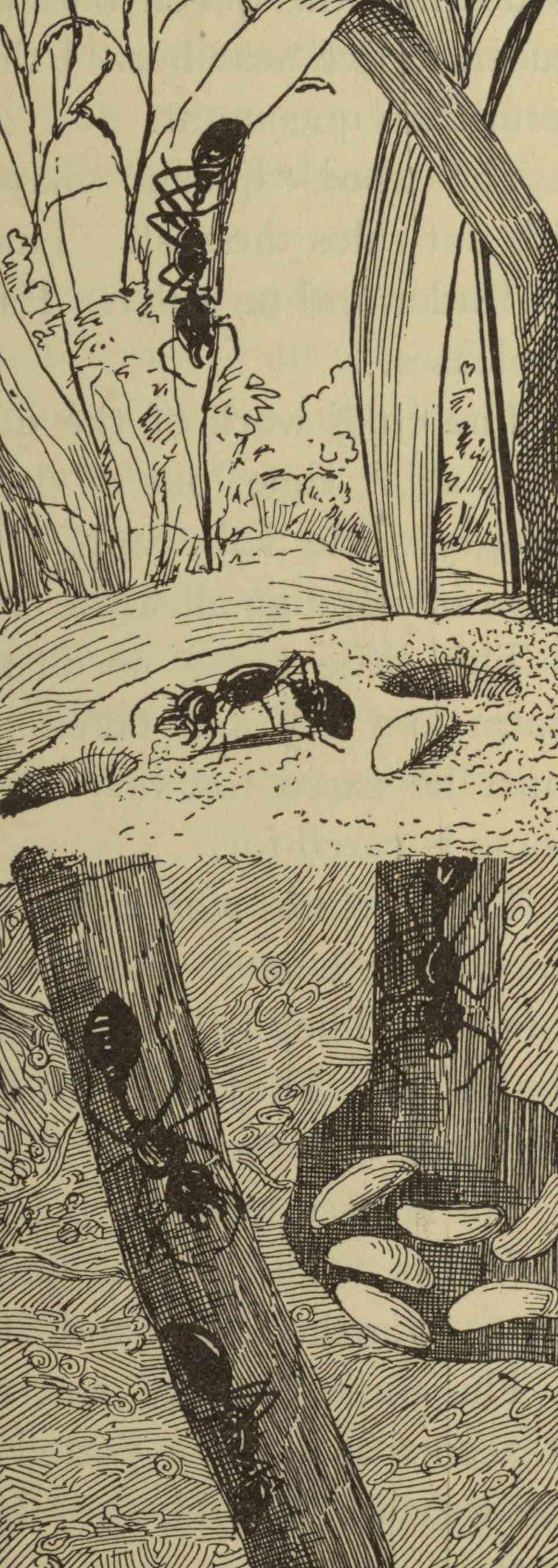
The queen ants also have wings. They have stings, and their bodies are round and dark.
The workers are smaller than queens and drones. They are also darker, and have no wings and no stings. Workers are of two sizes, large and small. They are the builders, nurses, soldiers, and servants of the others.
In an ant-hill there may be many queens at one time. Often the ant-queens work. They are both mothers and queens. They will also act as soldiers. The queen ant[Pg 6] is not like the queen bee, who will allow no other queen to live near her. I think mother ant a better term than queen ant.
The word “queen” may make you think that this ant rules the rest. That is not so. Ants have no leader and no ruler. Each ant seems to act as it pleases.
The chief work of the queen ant is to lay eggs. In a short time, out of each egg comes a lively, hungry, little baby ant. It is called a larva. A larva is like a small white worm.
This little being needs to be washed, fed, kept warm and dry, and taken into the air and sun. It must be cared for, very much as the baby in your home is cared for.
The workers, who act as nurses, are very kind to the young larvæ.[3] How do they wash these little things? They lick them all over, as the cat licks the kitten. They use such care that they keep them nearly as white as snow.
The nurses feed the baby ants four or five times each day. The nurses prepare the food in their crops, to make it soft and fit for the little ants.
The nurses stroke and smooth the larva baby. It seems as if they patted and petted it. When the weather is cold, they keep the larvæ in-doors.[Pg 7] When it is warm and dry, they hurry to carry them up to the top of the hill. They place them there to bask in the sun. If any rain comes, or the hill is broken, the nurses run to carry the babies to a safe place.
When the larva is full grown, it spins around itself a little fine net, which wraps it all up. When people see these white bundles in the ant-hills, they call them “ant-eggs.” They are not eggs. They are pupa-cases. In them the baby ants are getting ready to come out, with legs and wings, as full-grown ants.
The pupa-cases are of several sizes. The largest ones are for queens and drones. The next size holds large workers; the smallest cases hold the smallest workers.
There are often in the hills very wee ants called dwarf ants. When you study more about ants in other books, you can learn about the dwarfs.
After the ants have been in the little cases some time, they are ready to come out. The nurse ants help them to get free.
Many hundreds come out of the cases. They crowd the old home so full that they can scarcely find room to move about.
Then they see the light shine in at the little gates on the top of the hill. They feel the warmth of the sun. They crawl out.
[Pg 8]
They push upon each other. The hill is not wide and high enough for so many uncles and cousins and sisters and brothers. They act like great crowds in the streets at a big parade, each one struggles for his own place.
Young ants, like young people, wish to set up for themselves in new homes. They spread their fine wings. Off they fly! Since there is not room in the old hill they will build a new one.
They swarm as the bees do. As they rise high from the earth, they drift off on the wind. Very many of them tire out and die, or are blown into the water, and are drowned. A few live and settle on places fit for a new ant-hill.
It is the mother or queen ant who chooses the new home. When she has found the right place, what do you think she does? She takes off her wings, as she does not care to fly any more.
The ant does not tear off her wings. She unhooks them, and lets them fall away, and does not seem to miss them.
[3] When we mean only one we say larva; when we mean more than one we say larvæ.
[Pg 9]
THE ANT’S HOME.
Ants live in nests, made in the earth. We call them ant-hills, from the shape of the part that is above ground. It is the queen ant who begins to build the ant-hill.
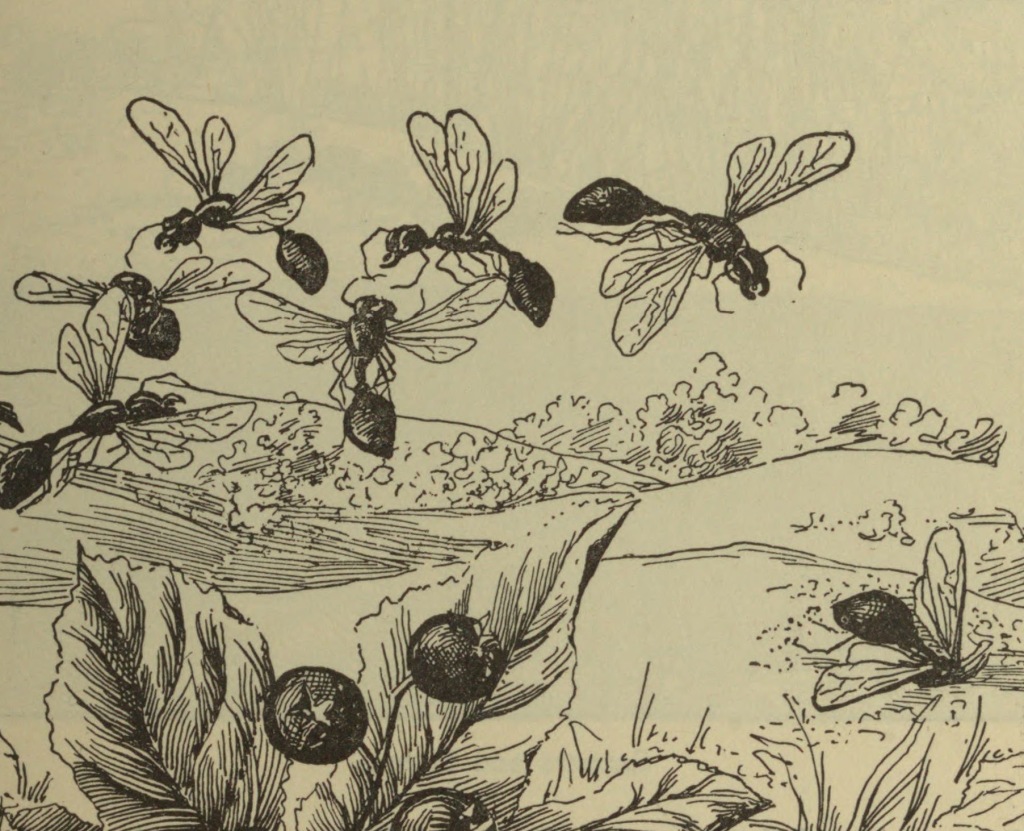
Like the mother wasp, the ant works on her nest until enough ants grow up to do all the work. After[Pg 10] that, like the queen bee, she does no work. The work ants will not allow her to go from home.[4]
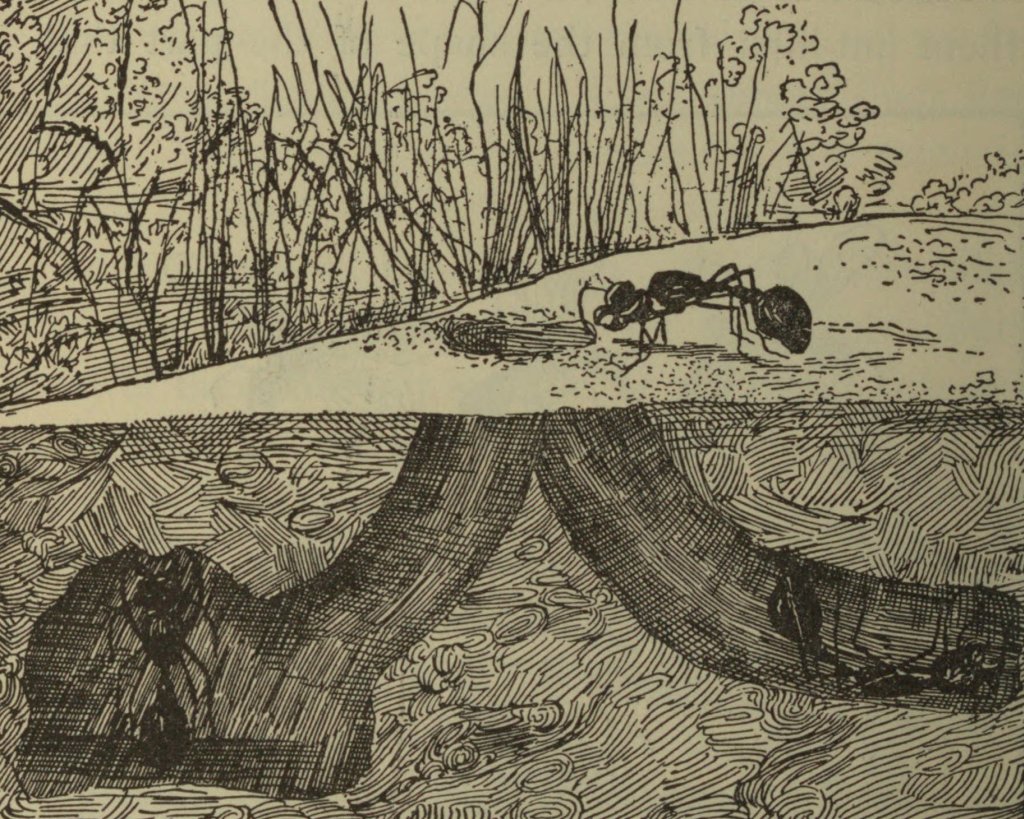
When the ant finds a place for her home, how does she take off her wings? They would be in her way while she worked. She presses the edge of a wing upon the ground and so pushes it up and loosens the hook, just as you unhook a dress. Then she begins to dig. She acts at first much as your dog does when he digs after a chipmunk or a rabbit.
[Pg 11]
The ant lays her big head close to the ground. With her fore-feet she digs up the soil, and tosses it back between her hind legs. She digs as her cousin, Mrs. Wasp, digs.
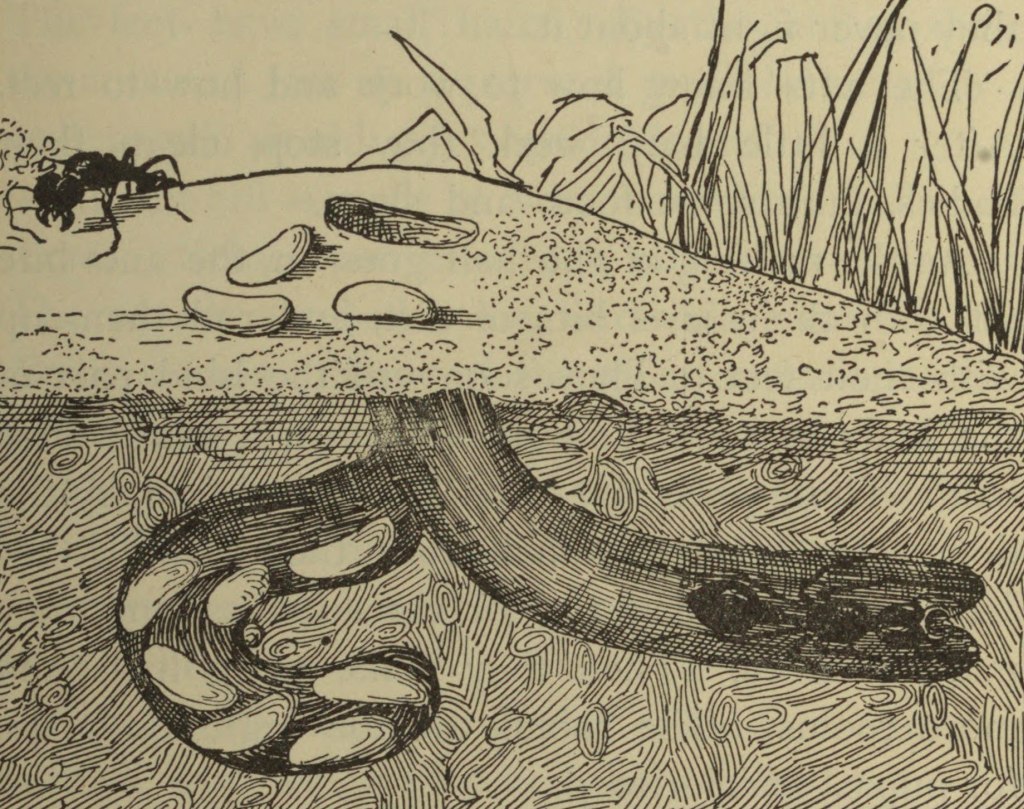
She keeps waving her little feelers, as if to find out the kind of soil. Soon she has a hole deep enough to cover her body. It is too deep for her to throw out the dirt with her feet. Now she uses her feet, and her jaws, also, to dig with.
Where the soil is sandy, she takes it out, grain[Pg 12] by grain. At first, she must back out of her hole. Soon her hall-way is so wide that she can turn about after she has backed a few steps.
Ants are very kind to each other in their work. If they push or tread on each other in their haste, they never fight about it.
The ants know how to work and how to rest. After a little hard work they stop, clean their bodies, take some food, and sleep.
As the making of the hall goes on, the ants bite off with their jaws bits of dirt, and roll them up with their feet. They soon use the hind part of the body to press and push the earth into a firm ball. These balls are carried out and laid by the door. By degrees the balls form the “ant-hill.”
When the hall is two or three inches long, they make a room. Then they make more halls and more rooms. The rooms are for eggs, for larvæ, for pupæ,[5] and for food.
People who have studied much about ants have had them build nests in glass jars. Thus they have been able to see how they work.
To make a room, the ants often have to stand on their hind legs, and bite the earth off, as they reach up their heads. Sometimes the ant lies on its side, to clean off or smooth the side wall. They have[Pg 13] been seen at work, lying on their backs, as men do in mines.
The jaws of the ant have tiny teeth. In old work ants the teeth are often quite worn off. The feet and jaws of the ant are well made for digging. The feet have small hairs. By the aid of these the ants can run up a piece of glass, or hang on a wall, as you would say, “upside down.”
An ant-hill is made of very many little halls and rooms. Some open into each other; some do not. The rooms are bedrooms, nurseries, pantries, and dining rooms. Many of the rooms are shaped like a horseshoe. Some are round.
The ants press and knead the floors and walls to make them hard and smooth. Sometimes they line them with a sticky soil, like paste, to keep the earth from falling in.
Some ants seem to make a kind of glue, or varnish, with which they line their walls.
[4] For Lessons on Bees and Wasps, see First Book.
[5] Pupa is used when we speak of one, pupæ when we mean more than one.
THE ANTS AT HOME.
We have taken a look at the ants and have seen how the hill is made. Let us now see how the ants live in their hill-home.
When we go to visit them, we shall find ants[Pg 14] running all about the hill and in the halls. These are the work ants. Some seem to stand on the hill to watch lest any danger may come near.
When the drone ants and the queens are young, the work ants let them go out and fly. When they go out, the drones do not often come back. They get lost or die.
The young queens come back, except those who go off to make new hills. But when the young queen settles down in life, to her work of laying eggs, the workers do not let her leave the hill any more.
How do they keep her in? If she has not taken off her pretty wings, they take them off and throw them away! If she tries to walk off, a worker picks her up in its jaws and carries her back.
The ants are kind to their queen. They feed her and pet her, and she becomes very lazy. She does not even care to lay her eggs in a nice clean place.
The idle queen drops her eggs anywhere. The kind worker ants pick them up, and take them to a soft bedroom.
When there are too many young queens in one hill, they do not have a war, as the bees do. The workers settle the trouble, by taking off the wings of some of the young queens, and turning them into[Pg 15] work ants. This is done before the queens begin to lay eggs.
New-born ants and queens, who do not go out into the sunshine, are of a light color. The other ants are dark.
In cold, wet weather the ants stay at home. If a rain comes up when they are out, they hurry back. Early in the day, and late in the afternoon, they all seem to be very busy. In the hot hours of the day they stay in the hill and rest.
In very hot lands the ants stir about all winter. Such ants lay up stores of food. You shall hear of them by and by. In cooler lands, during winter, the ants are asleep, or, as we say, are torpid.
The young swarms usually go out in autumn. I have seen very large swarms in the spring.
Ants like sugar and honey best of all food. They get honey from flowers, and in other ways of which I will soon tell you. Some like seeds which have a sweet taste. For this reason they eat some kinds of grass-seeds, oats, apple-seeds, and such things.
Ants take their food by licking it. Their little rough tongues wear away bits of the seed; they also suck up the oil and juice. They seem to press the food with their jaws.
It has been found out that they know how to moisten their food and make it soft. If you give[Pg 16] them dry sugar or cake, they turn it into a kind of paste or honey. Then it is easier to suck or drink it up.
If you put a nest of ants with plenty of earth into a large glass jar, and put some food near by for the ants to eat, they may settle down in the jar, to make a home. If you cover the outside of the jar with thick, dark paper, the ants may build close to the glass. Then, when you take off the paper, you will be able to see the halls and storerooms.
You might put such a jar in a safe place out of doors. Then you would be able to study the ants, as they roam around near by, or do their work inside the jar.
THE ANTS ON A TRIP.
The round hole in the ant-hill is called the gate. The ants can close it with a bit of stone. Often there are two, three, or even more, gates for one ant-hill. Once I saw a hill with six large gates.
Now I will tell you of a very queer ant-hill. It was made by big black ants, in a little valley between two hills of sand.
Into this valley had blown a very large sheet of thick paper. It had been around a ham and was[Pg 17] very greasy. It had lain on the ground, crumpled up, in sun, and snow, and rain, for a year.
By that time it was hard and stiff, and weeds had grown up about it. One day, as I was going by, I saw ants running in and out of the folds of the paper. I took a stick and turned the top fold open like a lid.
It was full of ants and of white pupa-cases. The ants, I think, liked the folds of the paper for halls, and the larger wrinkles for rooms. They had found out how to have a house without much work in making it.
When I opened this paper-hill, they ran in swarms to pick up the white bundles. Poor things! They did not know where to go for safety. So I laid the lid of their house back in its place, and soon they were quiet again.
Now I will tell you how ants move from one house to another. One day I saw by my garden path a line of ants moving all one way. They were black ants.
They went two by two, or one and two, close to each other. Every one had in its jaws a white bundle. I found that they all came from an ant-hill. They came up out of the gate very fast, one by one, each with its bundle.
About two or three inches from this line of ants[Pg 18] I saw another line. This line went to the hill, not from it. They went in good order.
They had no bundles when they went into the hill; when they came out, each had a bundle, and joined the other line of ants.

I went along with the stream of ants that had the white bundles. I found that they went to a new hill, about thirty feet from the old hill.
There they laid down their bundles, and went back to the old hill to bring more. The bundles lay heaped in a ring all about the gate of the new city.
[Pg 19]
Out of this gate ran other ants in haste. They caught up the bundles, one by one, and carried them in. In about half an hour they were nearly all taken in, and the ants brought no more. The moving was over.
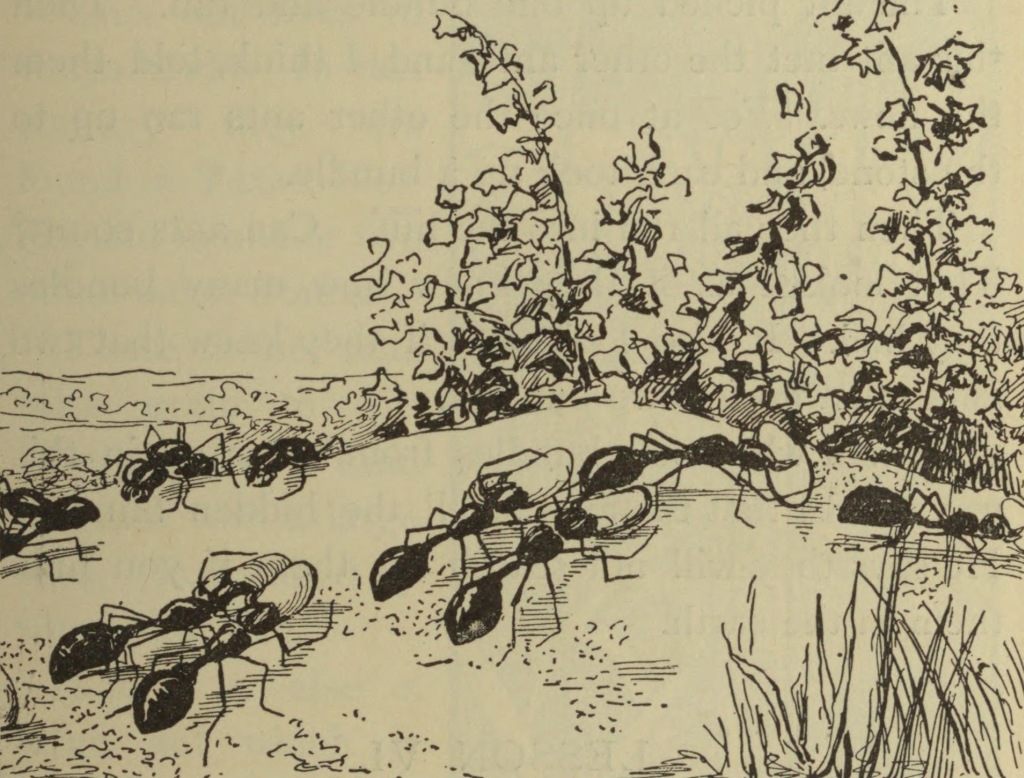
With a long blade of grass, I gently took up a little bundle, I hid it behind a stone, some six inches off. I took three bundles and hid them, lifting them with the tip of the grass-blade.
When all the bundles left at the hill were carried[Pg 20] in, the ants went down the gates. But in a minute out came three or four ants. They ran about wildly and searched the ground.
They went in circles and looked over the ground with much care. The circles grew wider. At last one came up behind the stone and found the bundles.
The ant picked up one bundle and ran. Then this ant met the other ants, and, I think, told them the news. For at once the other ants ran up to the stone, and each took up a bundle.
Then they all ran into the hill. Can ants count? That looked as if they knew how many bundles they had. It also looked as if they knew that two ants must go for two bundles.
A man who took bundles from a march in this way thinks that the ants smell the hidden bundles. He says they will not search for them if you hide them in the earth.
THE FARMER ANTS.
You have heard of the spider which makes a den in the ground. You know that it puts a trap-door on its den, and plants ferns on the door to hide it.[6]
[Pg 21]
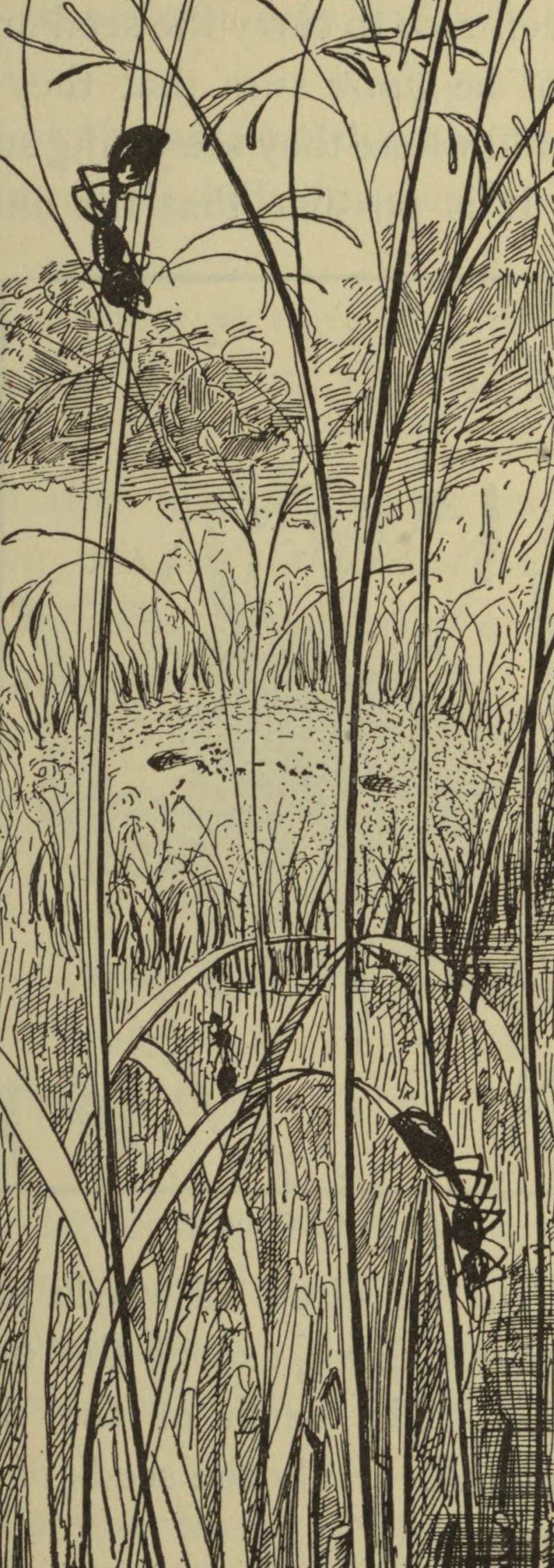
The spider turns gardener in this way, and all his plants grow well. There is an ant that has a farm, or garden.
This ant lives in warm lands. In this country they are found in Texas, Florida, and in one or two other warm States.
These farmer ants raise grain to eat. The grain is a kind of grass with a large seed. It is called by some “ant-rice.”
There is also a large ant which is fond of the seeds of the sunflower. It is said that the ants plant the sunflowers in a ring around their hill.
The ants have not[Pg 22] been seen to carry the seed and plant it. So we may not be quite sure that they do so. Perhaps they build where they see young sunflower plants growing.
It is possible that the ant plants seeds of some kinds. You see there are yet in the world many things left for you to find out. It will be well for you to keep your eyes open.
The farmer ants do not live in a small hill that you could cover with your hand. Their hill, or disk, is sometimes flat, and sometimes high. It is often as large as a large room. It is in the shape of a circle.
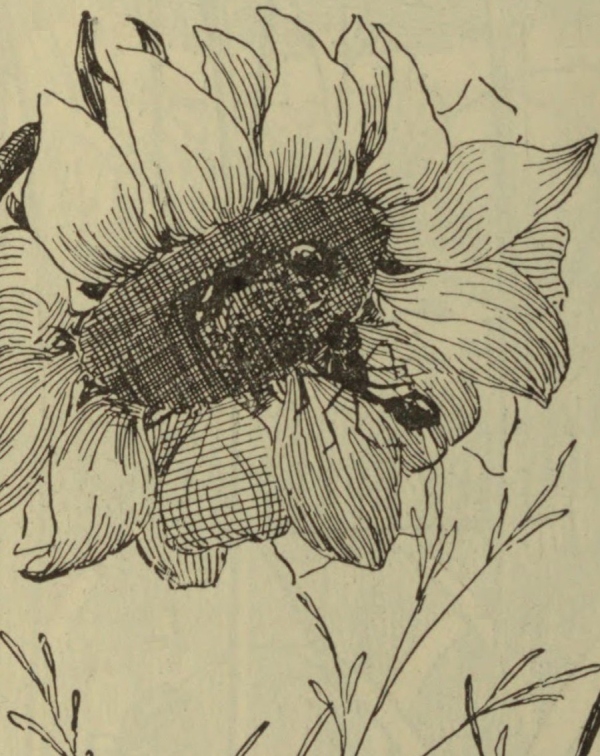
In this circle all weeds and all kinds of grasses are cut down, except the one kind which the ants like. The earth of the disk is kept clean and smooth. Only the seeds of the ant-rice are left to grow.
When the ant-rice is ripe, the ants pick up the[Pg 23] seeds as they fall, and take them into the hill to their storerooms.
It is most likely that as the ants let this ant-rice, and nothing else, grow on their hills, it sows itself by its fallen seed.
Still the ants are real farmers, as they keep their land clean, tend and gather the crop, store it up, and eat it.
When the ant-rice is ripe, and the seeds have fallen, the ants cut down the old stems, and take them away. The disk is then clean for the next crop.
The ants will go a long way from their hill to find seeds to bring home. They like to go where horses have fed, for there they find scattered oats. In some lands they carry off much grain from the fields.
An ant in Florida climbs the stalk of the millet and cuts off the seeds. When ants take seeds to their hill, they husk and clean them. They throw bad seeds away.
The ants watch the seeds, and after rains carry them out to dry in the sun. This is because if left wet, they would sprout and grow.
Some ants also cut the seed, so that it will not sprout.
The ants eat the seeds that they gather. They also feed their young with them.
[Pg 24]
One ant in Florida rolls up into little balls the dust, or pollen,[7] of pine cones, and stores that up to eat.
An ant in New Jersey cuts in pieces the little new pine trees, just as they get above the ground, and carries them to its nest.
Did you ever see the ant which likes sunflower seeds to eat? It is a large ant, and when it has climbed to the disk of the sunflower, it pulls out one of the ripe seeds and carries it away.
When people keep a nest of ants in order to watch their ways, they feed them with sugar, oats, apple-seeds, and wheat.
How does the ant eat the hard grain? Its tongue is like a file, or something like that of the little shell-fish of which I told you.[8] The ant can rasp, file, and press the grain, so it can get at and lick up the oil and juice.
ANTS AND THEIR TRADES.
Since you know that bees, ants, and wasps[9] all belong to the same great family of living creatures, you will not wonder that many of their ways are alike.
[Pg 25]
You know there are wasps and bees that live alone. You have read how, in the spring, Mrs. Social Wasp builds her home and raises a brood of babies.
These, as soon as full-grown, begin to build more rooms and nurse the next babies. Mrs. Ant does as Mrs. Wasp does.
Mrs. Ant begins a new hill, and as her children grow they help her. But Mrs. Ant does not often begin her hill in the spring. She chooses the early fall to begin work.
As the eggs change into working ants, Mrs. Ant gets plenty of help in her work.
You have seen bees swarm, and hang in a bunch, or curtain. Ants also cling together and form balls. But this is for warmth or safety. It is called “snugging.” In some lands, in times of flood, ants form balls as large as your play ball. Thus they can float on the water, and do not drown.
As Mrs. Wasp makes paper, so Mrs. Ant can make a thin paper, for her nest. But it is poor paper, not so good as Mrs. Wasp makes. Mrs. Wasp is the chief of the paper-makers.
I told you how one Mrs. Bee cuts leaves to line her nest. So one Mrs. Ant does. With cut leaves she lines a neat little nest. As the spider makes a fine spun ball to put her babies in, there is an ant that makes a woolly nest.
[Pg 26]
You have read of the Tower Spider, that builds a neat tower of sticks, straw, and grass over her nest. There is an ant that thatches its hill in much the same way.
There is a brown ant that is a mason. She makes her nest of little balls of mud, laid up like bricks in a wall.
Then there is a carpenter ant, as there is a carpenter bee. These carpenters cut their way into trees and logs. These ants hollow out the inside of a tree, or beam, until it is ready to fall to pieces. In this way they do much harm.
Besides their other trades, the ants know the trade of war. There are soldier ants. Ants are mild and kind to each other while at work. But they are brave, and have armies for war.
It is odd to see how much ant ways and ant soldiers are like human ways and human soldiers.
The ants make war to get slaves, or servants. I will tell you more of that in the next lesson. They also make war to get cows, as you will hear by and by. They seem to have some other reasons for war.
When the ant army marches, it keeps in line and order. It seems to have captains to rule and lead it. Scouts go before to seek out the way.
The ant-hill has some soldiers for sentries, to see[Pg 27] that no danger comes near. When a work ant gets into trouble, it will run to a soldier for help.
The soldier ants do not appear to be cross. They have very large heads, as if they wore big hats. Some of them have smooth heads, and some hairy heads. They eat much and love to sleep.
The soldier ants do not do much work. They rouse up only for a battle. In an ant-hill, the soldiers are larger, and often more in number, than the other ants.
The workers are the smallest ants in a hill. There are fewer queens than any other kind, except after most of the drone ants go off and die. At that time there are very few drones.
In a battle, two ants will often cling to each other by their jaws, until both die. The usual way in which an ant soldier kills a foe is by cutting off the head.
Sometimes the battle ends without any killing. At other times the ants are very fierce, and large numbers are cut to pieces.
When strange ants get into a hill, sometimes they are driven out; sometimes they are killed; sometimes they are treated kindly.
I put a black ant into the gate of a city of brown ants. You should have seen how they drove him out! He ran as if he were wild with fear. Three or four brown ants came after him to the edge of their hill.
[Pg 28]
But though some strange ants are cast out so fiercely, there are two or three kinds of beetles which go into ant-hills and live with the ants. The ants do not harm them in any way. You shall hear about that when we have some lessons about beetles.
[9] For Lessons on Wasps, Bees, and Spiders, see First Book.
THE SLAVE ANTS.
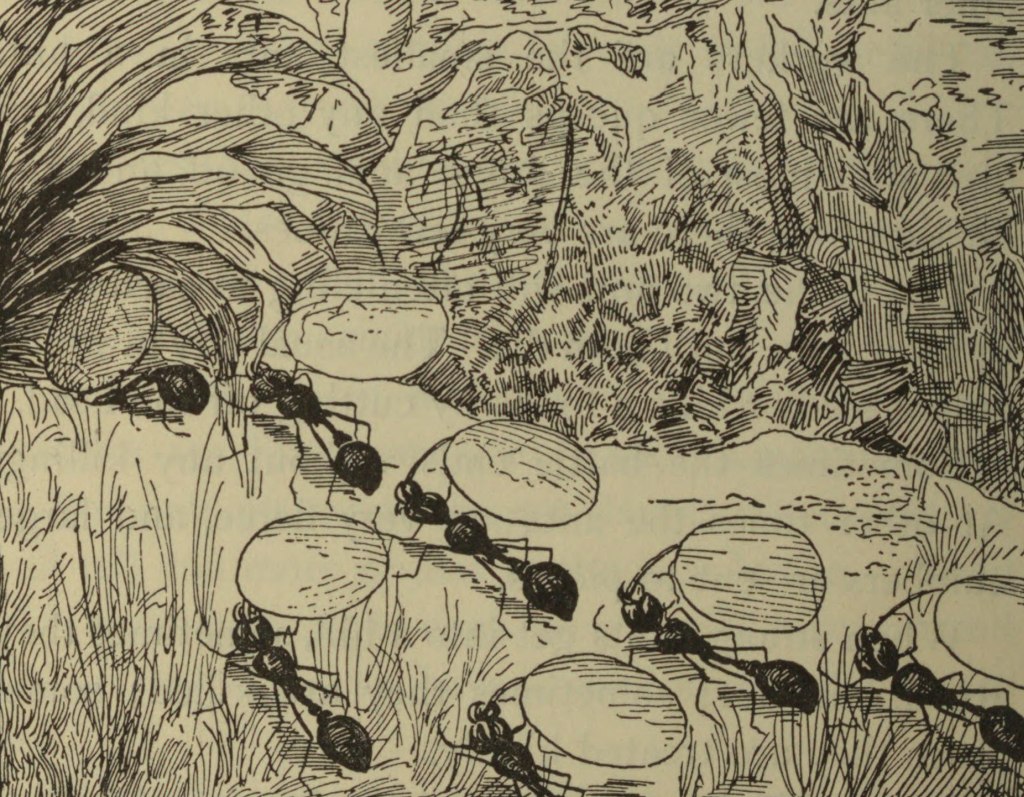
Now I must tell you about the slave ants and their owners. The chief family of the slave-making[Pg 29] ants is called “The Shining,” for its body shines with a gloss like varnish.
The slave-making ants and their slaves are found in many parts of the world. The masters are of a light or red color, with a bright gloss. The slave ants are dark or black.
In nests where slaves are held the masters never do any work. They make war and steal slaves, or slave babies. The slave ants do all the work. If a war rises, they also fight for the hill and their owners.
The army of the slave makers will march to the hill of a tribe of ants which they wish to seize for slaves. They carry off the pupa-cases, where the little new ants are getting legs and wings.
These baby ants are taken to the hill of the owners and brought up with their own young. No slave-ant eggs are laid in a hill, for the queens lay all the eggs, and the queens are not slaves. The slaves are stolen when they are eggs, or larvæ.
The owners seem to be very kind to their little slaves, and as the slaves grow up and fill the hill they seem to do very much as they please.
The slaves build new hills and take their owners to live in the new home. If a mistress ant wishes to wander off her hill, her slaves drag her back. If she does not wish to move to her new home, her slaves carry her off, all the same.
[Pg 30]
The slave-owning ants walk about their hill in an idle way. If war comes, then they fight bravely.
The owners do not build the house, nor nurse their babies, nor feed themselves. Often they do not even clean their own bodies. They leave all these duties to the slaves. The slaves feed their owners, and brush and clean them, as a servant cleans his master’s coat. When the ants are to make a move, the slaves pick up their masters, and carry them away.
How can they do that? The ants carry all burdens in their jaws. The slave and the master lock their jaws, the owner curls up the back of her body, and the slave carries her off.
The grip of an ant’s jaw is very strong. She can carry things much larger than her own body.
There is an ant which uses the pine needles for food. She carries the bits of pine laid over her back much as a man carries a gun. There is a little groove in this ant’s head, where the bits of pine rest. I have seen very large hills covered with carefully cut bits of pine needles. I think they have been sucked dry and then cast out.
There is an ant called the “parasol ant,” because it cuts off tiny bits of leaf, and carries them along. Each ant holds a piece of leaf over its head, like a parasol.
[Pg 31]
An army of this kind on the march looks very funny. These ants line their nests with bits of leaf, to keep the dirt from falling in.
These parasol ants are very large. Their nests cover a large space. The bits of leaf are cut about the size of a dime. The ants carry them in their jaws, each piece by a little end left for a stem.
We have some parasol ants in this country, in Florida and Texas, and there are many of them in South America.
WONDER ANTS.
You may perhaps read of what are called “Termites,” or White Ants. You must not think that these are true ants, for they are not. They belong to another Order of insects. They have four wings all of the same size. But true ants have one pair of wings smaller than the other.
The white ants live in the ground and also in trees. They do much harm by gnawing wood and trees. They swarm into houses, and eat the tables and chairs and such things. They eat all kinds of food. They are much like real ants in their ways. There are many of them in our country.
Now you must hear about the ants that keep[Pg 32] cows. I have told you that ants like honey. They take all their food by lapping and sucking it. They suck honey from flowers.
If you look at the plants in the garden or house, you may see on the leaves some very small green things, that seem to eat the leaves. Your mother will tell you these are “plant lice,” and that they spoil her plants.
The name of this little insect is Aphis. That is a very pretty name. The aphis is very small, and is often of the color of the leaf it feeds on.
This wee thing can make honey in its body much as bees do. But the aphis does not store up the honey; it drops it on the leaf as it feeds. This is called “honey dew.”
The ants eat the honey dew from the leaves, and they know that it comes from the aphis. They stroke and tap the aphis with their feelers, so that more dew will be let fall.
Have you seen the milkmaid go from cow to cow, and fill her pail with milk? So the ants go from one aphis to another, until they get all the honey they want.
The ants can carry home this honey, and give it to other ants. The nurse ants will carry it to the baby ants. The workers take it to the queens, owners, and soldiers.
[Pg 33]
The aphis is called the “ant’s cow.” A hill of ants will seem to own a herd of these wee green cows. They go to them on their leaf, and get the honey. They know and claim their own cows. It is just like having a drove of cows in pasture, as the farmer does.
You know that people often keep cows in stables and feed them there. The ant has this way also. There is a kind of aphis that loves the dark and feeds on roots. Some ants keep a herd of these, hidden in the ground. They pet, stroke, and clean them to get their honey dew.
Ants have been seen to fight for days over a herd of aphis-cows. One hill of ants had no cows, and they tried to steal the cows that belonged to another hill. After four days the lady that watched them got twenty cows, and gave them to the hill that had none. Then the war ended.
The ants which got the new cows seemed very glad. They licked and petted the cows, and put them in a safe place. They took honey from them and fed the soldiers.
This seems just like a fairy tale. But it is quite true. All these things can be seen if you look out for them. But you must be patient and anxious to learn.
In warm summer days, when your mother tells[Pg 34] you that it is too hot to run about much, what will you do? Why not make a tent of an umbrella, placed near an ant-hill, and watch these pretty and curious little creatures?
THE WAYS OF ANTS.
I have told you that ants like honey and sweets. They will also suck the juices and soft parts of many other kinds of food. Some ants eat nearly everything that can be eaten.
Almost all ants will eat other insects, and suck the eggs or pupæ of other insects. This habit makes ants very useful. Certain worms and bugs that destroy orange trees and cotton plants are killed by ants.
Ants also eat other insects that injure men. If a coat that has these on it is laid near an ant-hill, in an hour or two the ants will have made it quite clean.
You have seen a fly sit and clean her body and wings. She does this by drawing her feet over her head and body. So you have seen the cat clean her fur coat with her paws and tongue. The ant washes or brushes herself in just such a way.
The ant is very neat and clean in her habits. She[Pg 35] takes many naps in a day, and after each nap she brushes herself. She brushes herself tidy after work and after taking food.
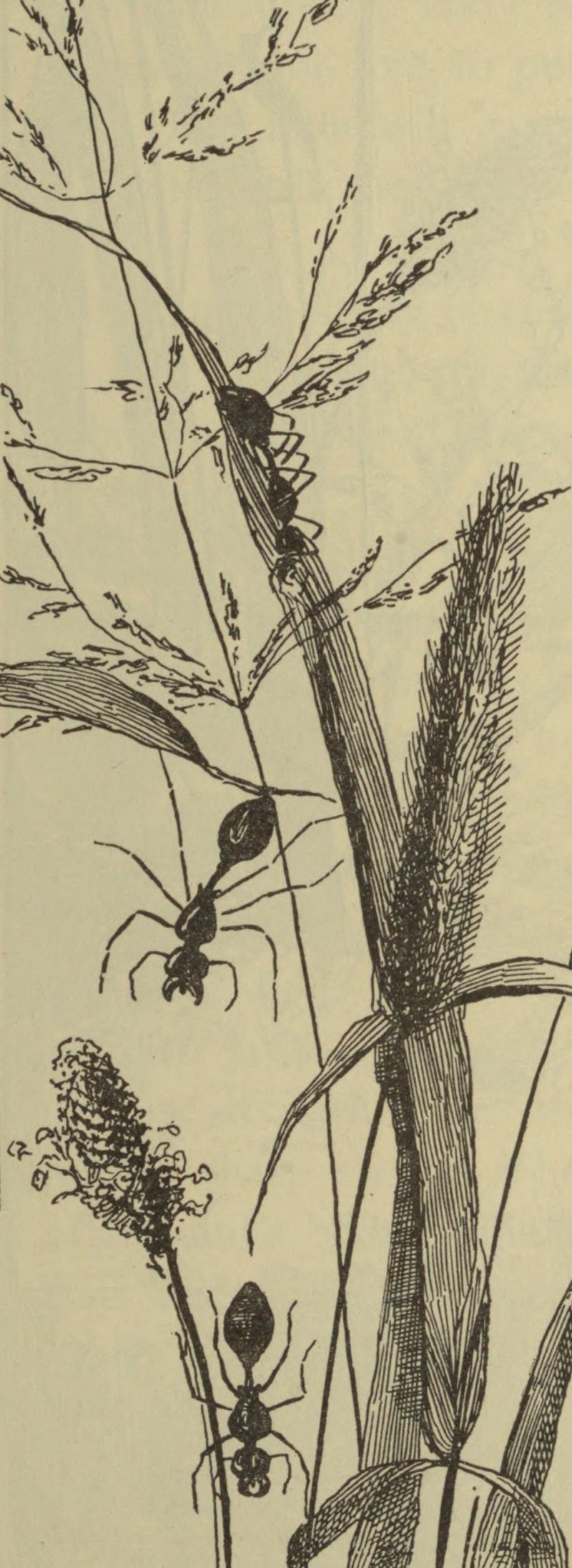
The action of the ant in cleansing herself is much like that of the cat. The ant has on her fore-leg a little comb, shaped like your thumb. With this she strokes and combs all dust and dirt from her body.
If you watch an ant as she dresses herself, you will see that she draws her fore-foot through her mouth. This is to clean the comb and to make it moist, so that it will do its work well.
The ant has also[Pg 36] little brushes on her other feet; so you see there is no reason why she should not keep herself very trim and tidy.
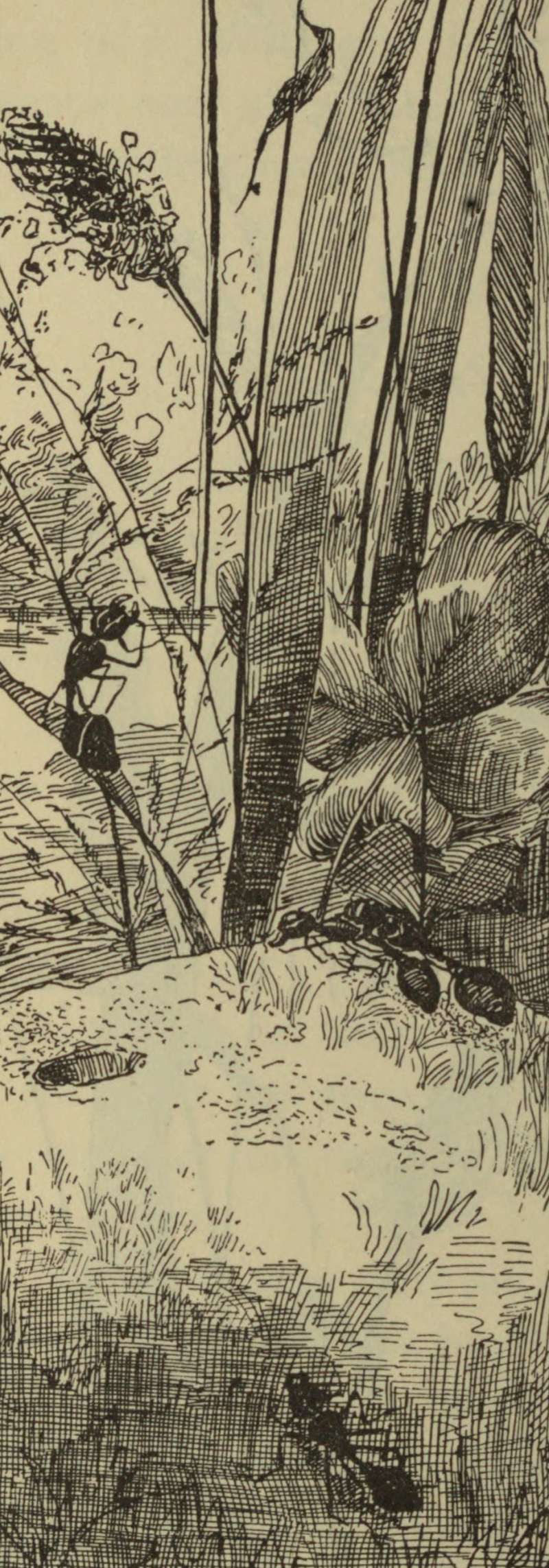
Ants are very neat about their nests. They carry out all husks of grain and seeds and all dead bodies. They carry these quite off their hill.
I knew of an ant’s nest that had been set on a post in water. It was kept clean by the ants. They soon learned to drop all refuse over into the water. That is as the sailor does, when he tidies his ship.
Ants bury their dead. When an ant[Pg 37] dies, some of the other ants pick up the body to carry it off and bury it. They do not like to put dead bodies near their hill. The ants will carry the dead ones round and round, till they find a good place for them.
A lady who spent much time in the study of ants said that the slave-owning ants do not bury the slaves with the masters. They put the dead slaves in one place and the owners in another.
Ants will now and then change their home. They leave an old hill and make a new one. When they do this, if some of the ants do not seem ready to leave the old hill, the others drag them off by force.
Most ants have very good eyes, and can see above ground and under ground. But there is one kind of ant that is blind.
Ants can bite with their sharp jaws. They also have a sting. They seldom use it if they are let alone. Some ants have quite a sharp sting. The sting is on the hind part of the ant’s body. Their sting is made in three parts. There is the sack for poison, the needle which gives the prick, and the case to keep the needle or prickle in. This needle, of a light color, is like a little thorn.
The ant seizes with its jaws the part which it wishes to sting. Then it lifts its body up on the[Pg 38] hind legs, and swings its sting part under, so that it can drive the sting into the place held by the jaws. The sting does not do much harm to people, but will no doubt kill ants and other insects.
Ants make also a kind of juice called “ant acid.” They can throw this about when the hill is disturbed. This acid must be pretty strong. It will make a dog sneeze and rub his nose. The ant uses it to keep dogs, mice, beetles, and such things, away from the ant-hill.
I have told you that some ants harm trees and plants by gnawing or cutting them. It is only fair now to tell you that ants help plants to grow. As they creep into flowers for honey, they carry about from flower to flower the dust or pollen which makes new seeds grow. This dust sticks to the ant’s body, and what is taken from one flower is carried to another. Bees also carry pollen.
Thus, you see that the ants help the flowers, which in their turn give food to the ants. But, of course, the ants do not know what they are doing for the flowers.[10] Nor do the bees know that they help the flowers. The bees and ants do not know that pollen sticks to them, to be carried about.
These lessons about the ant contain only a few of the many things that can be said of this insect.[Pg 39] I hope you will like the ants well enough to get other books about them, and study and watch the ants for yourselves.
MR. WORM AND HIS FAMILY.
One day I saw a boy making a hole in the ground, and he dug out a worm.
I said to the boy, “What can you tell me about worms?”
The boy said, “Worms are long, soft things, alike at both ends. If you cut one in two, each end goes off, and makes a whole new worm. They have no heads and no feet and no feelings, and are no good but for fish-bait.”
The boy thought he knew all about worms. But really he knew very little about them. All that he had told me was wrong.
Worms belong to the great class of ringed, or jointed, animals. These creatures have bodies made in rings or joints.
Let us take a careful look at our humble friend, the earth-worm.
He is a long, round, soft, dark, slimy thing, and you say, “He is alike at both ends.”
Is he? Let us see. His body is made of from[Pg 40] one hundred to two hundred rings. These rings are smaller toward the two ends of the body, which are the head and tail.

Each ring has on it tiny hooks, too small for you to see. These hooks take the place of the jointed feet that his cousins have. The feet on a caterpillar will show you about how these hooks would look, if you could see them.
By these hooks the worm moves along, and digs his way in the ground. Mr. Worm can hold so fast[Pg 41] to his den or hole, that you have hard work to pull him out.
Have you seen Mr. Robin brace his feet and tug with all his might, when he pulls out a worm? The worm is holding fast by his hooks.
You see the hooks are Mr. Worm’s feet. Let us now look for his head. You have five senses. You can hear, see, feel, smell, taste. The worm can feel and taste. Some think he can smell some things. Some say that he cannot see or hear. I think that he hears, but maybe what makes him come up to look about is not hearing, but feeling a jar on the ground.
Why do we say he has a head, if he has no eyes nor ears nor nose? We say he has a head because he has a mouth and a brain.
His mouth has two lips. The upper lip is larger than the under. He has no teeth. In the back of his head, not far from his mouth, is his brain, or nerve-centre.
The worm is the only jointed animal that has red blood. Mr. Worm is dark-colored because his body is full of the earth which he swallows.
If you keep him out of the earth for a while, his skin will get pale and clear. Then you can see his red blood run in two long veins. He needs fresh air to keep this red blood pure. He dies very soon if he is shut up in a close box or case.
[Pg 42]
MR. EARTH-WORM AT HOME.
I told you the earth-worm has two veins. One runs down his back, the other runs along the under side of his body.
There are tiny holes, like pin pricks, in his body. These are for the air to reach his blood, to keep it red and pure.
In his body poor Mr. Worm has something that no other creature has. He has two bags or sacks for lime. This is in some way to help him with his food.
Mr. Worm has no teeth with which to grind his food. He has inside his body small bits of stone. These are as small as grains of sand. They are instead of teeth to grind his food.
When you study birds you will find that, like Mr. Worm, they have no teeth. They, too, carry little millstones inside their bodies.
The little bags of lime help to grind or change the worm’s food in some way, not yet well known.
The soft body of the worm will stretch like India-rubber. It will hold a great deal of food.
Now you see that Mr. Worm is not alike at both ends. One end has the head, the stomach, the parts that serve for a brain, and a heart.
[Pg 43]
The hooks begin at the fourth ring behind the head. Look at the worm when he lifts his head, and you will see his mouth.
The tail end has very strong hooks with which to hold fast to his cell. This tail end is also his trowel, or mould, a tool with which this poor, ugly worm helps to build the world.
Ah! now I have told you a great thing, a strange thing. Is it true that the feeble, useless worm helps to build the world? Where is that boy who knew so much about worms?
But before you hear how the worm helps to build the world, let us go back to what the boy said. He said, “If you cut the worm in two, each end will go off and be a whole worm.”
That is not true of the worm. When the worm is cut in two, the parts do not die at once. As there are hooks and rings on each part, they each can move off.
It is thought that if the fore part is left safe, the cut can close up, and the worm can still live. A new tail may grow upon the front part, as Mr. Crab’s new claw or eye-peg grows.
The hind part cannot live and grow. It cannot get a new mouth or heart, so it can take no food, and have no blood. It soon dries up and dies.
The boy told me that the worm “had no feelings.”[Pg 44] A worm can feel. The sense of touch is the best sense it has. Put your finger on its body, and see it move and shrink.
If the worm can hear, the organs that serve for ears have not yet been found. It crawls up as you come near, and pokes its head out of its hole and wags it to and fro. It has felt the jar of your steps.
The worm cannot see. Creatures that live under ground have but little use for eyes. Fishes that live in dark cave-rivers have no eyes. If the worm moves from the light and hides from it, it is because it feels the action of light on its skin. It does not see the light.
What does Mr. Worm eat? Some tell you that he eats dirt. It is true that he fills his body full of earth. That is to carry it to the top of the ground. Mr. Crab has claws and legs to bend into the shape of a basket. Poor Mr. Worm has no arms, legs, or claws, so he must make a basket of himself.
Suppose you should be sent for fruit, and turn yourself into a basket in that way! Your mamma might find fault. She would not wish you to act like a worm.
It is true that the worm may find a little food in the earth which he swallows. But the chief food of the worm is dead leaves and stems of plants. It does not care for fresh, live leaves and stems and roots.
[Pg 45]
The worm also likes meat,—fat, raw, or cooked. Worms will gnaw or suck the bodies of dead worms. We say worms gnaw. As they have no teeth, they do not really gnaw. They pinch off what they eat.
Worms like onions and cabbage best of all food. They need plenty of water, and must live in damp places. They soon die if they are put into water. They choke as a fish chokes if kept out in the air.
When the worm gets food into its mouth, the rings of its body begin to move out and in. They look as if they were opening and shutting. By this motion they press the food down into the body.
When the worm wants to move, it stretches out its body to its full length. Then it takes hold of the earth with its hooks. Next it draws up its body, and so moves on. This is a wave-like motion, you see. Watch it, and you will see that it travels with a motion like waves.
If you wish to find worms to study, you must seek for them in early morning or late in the evening. You will be likely to find them when all the earth is moist with dew, or when it is raining. They avoid heat and sun.
Worms hurry to the surface of the soil to enjoy the falling rain. When there is a long, dry time, the worms go down deeper and deeper into the[Pg 46] earth. You cannot find them when you dig for them. They need to keep down where the earth is moist, soft, and cool.
MR. WORM AT WORK.
Worms are found in all parts of the world. I have told you that they help to build the world, and make it fit for the home of man.
Man cannot live without food. He gets his food from the earth. The worms help to prepare the earth to bring forth the food of man.
Oh, this is very strange, that humble and dirty worms can be a help to man! Man is the highest of all animals. Worms are nearly the lowest. And can worms help man?
Now let us see how this is done. The worms live under ground. They make long, winding halls, like streets, some inches below the top soil. These halls, or little tunnels, help to keep the earth loose, so that the fine roots of the plants can grow well in it.
These tunnels also serve to help the air move more easily through the soil. By their constant motion below the surface the worms till the earth, as rakes, spades, or ploughs till it above.
All this is of great use, and people say, “Many[Pg 47] worms, rich land.” Now and then you will hear, on the other hand, that the worms have eaten up the seed sown. Or, people say the worms have bitten off the roots of the plants. Some say that the worms cut the vines below the soil.
You need not think the earth-worms did that. Not at all! The earth-worms never behave so ill. The “worms” that people mean, when they speak of this harm done, are the grubs or larvæ of some insects, as of the daddy-long-legs and others.
These grubs and cut-worms will eat living plants, but Mr. Worm likes dead leaves and stems best. He wants his food made soft by decay.
Now we come to the chief work of the true earth-worms. When they make their halls and houses, they fill their long bodies with the earth. Some say it is their food.
Mr. Darwin says, “Oh, no! they fill their bodies with earth just to get it out of their way.” If they get any food from the dirt it is not much. They turn themselves into baskets to carry the dirt out from their houses.
The worms work, work, work all the time, taking out earth, and carrying it to the top of the ground.
There they pile it in heaps, called worm-casts. Each piece is the shape of a small worm.
The earth takes this shape as the worm presses it[Pg 48] out of its long, soft body. Early in the day you can find these worm-casts over all the garden paths. So you can after a rain. Go and look for them.
There are so many worms busy all the time that each year they bring up tons of earth. This shows you the power that is in small, weak things. In India there are worm-casts in heaps six inches high.
The worms make the earth fine and loose, by pinching it off with their mouths. Then they bring this rich soil from below, and lay it on top, and so on and on.
It is only some twenty years since this work of worms was known. At first people said, “Oh, no, no! It cannot be that little, soft worms could cover a great field, some inches deep, with new earth.” But it was shown to be quite true.
Fields once stony and hard have become rich and fine. Things grow now where once scarcely anything would grow. Ashes and gravel, once on top, go two or three inches below.
All this is done by the busy worms. That is why I said that you could call the tail end of the worm the tool with which he helps to build the world.
Worms at work under ground have caused great walls and pavements to sink, as the earth sinks over mines. Also, they have helped to bury ruins and old cities, and to keep them safe hidden, until[Pg 49] we found them. We are glad when we learn of the old world days, from ruins which the worms helped to hide.
Then, too, the worms help make the soil rich, by the dead leaves and stems which they drag into their holes to decay. When the worms die, their bodies also help to make the earth more fertile.
MR. WORM’S COTTAGE BY THE SEA.
On the seashore you will find two or three kinds of worms. These are called “Tube Worms,” from the shape of the houses which they build. Some of them are called “Swimming Worms.”
The swimming worm is cousin to another family of creatures which look like worms, but have many feet. They have a name which means “many feet.”
You know that on most of the rings, in the body of the worm, are hairs or hooks. You can see how easy it would be for these to become feet.
Each animal seems to have parts that are like some other animals, and some new forms of its own. Thus, next the worm, with his rings and hooks, comes another animal with rings and feet. Of all the ring animals, Mr. Worm is the pattern, and after him comes his cousin, Mr. Many-Feet.
[Pg 50]
While Mr. Many-Feet is like Mr. Worm, he is also like Mrs. Fly, and seems to come between the two, a little related to both.
Now let us look at the seaside worms. Here we find some worms that have eyes. We also find some that have little hard teeth, set in a ring inside their mouths. There are some that have fine plumes, as gay as any bird. These poor worms gleam like a rainbow.
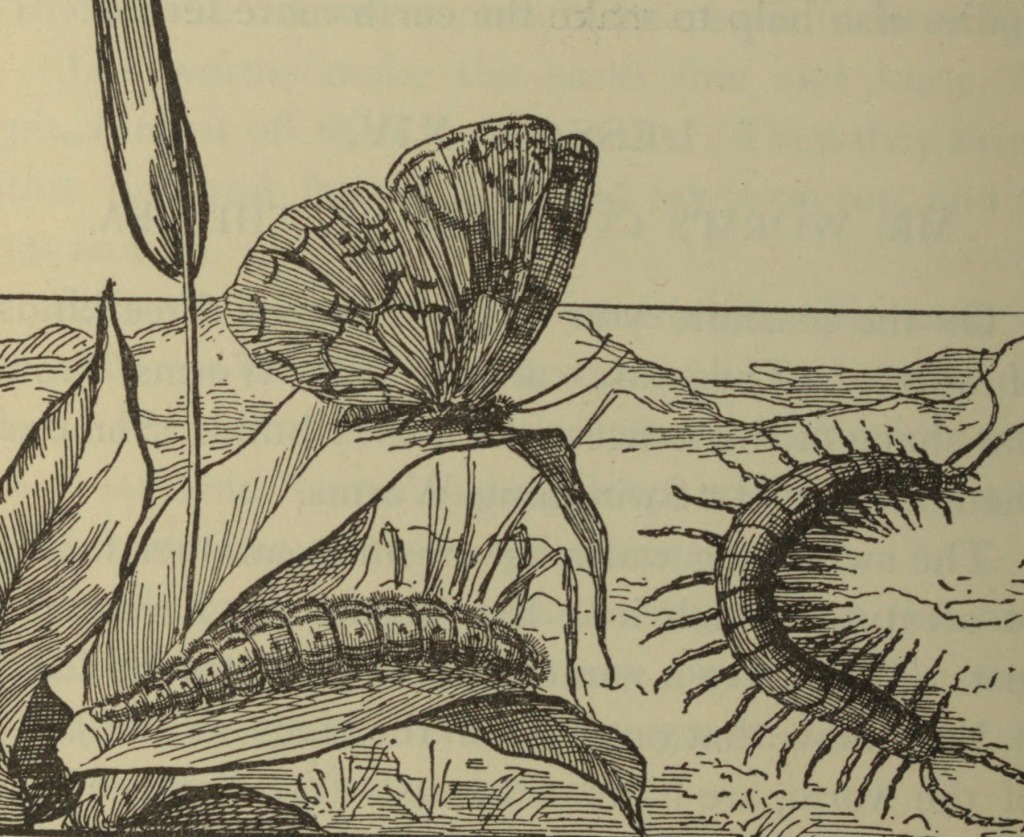
New parts can grow on these worms as well as[Pg 51] on the earth-worm, or even better. Some say that they can even get a new head if the old one is lost.
Some of these worms can bore into very hard things, as wood or stone. Some of them shine like a fire. Ask some one to tell you of this kind of light; it is like what we call Jack o’ Lantern.
Dig in the sea sand anywhere, and you will find worms, black, brown, green, red, orange. They dig through sand and mud, and move very fast.
It is not yet known how these worms bore into stone and wood. Perhaps it is by means of some acid stuff in their mouths. Perhaps it is by a file, such as Mr. Drill has.[11]
If you look along the sea sand of some shores, you will find the tube-homes of these sea worms. In their way of making a shell-home, and making it larger as they grow, they are like the little shell-fish you have read of.[12]
Most of these tube-homes are small, but some are very large. A gentleman told me he had one with the bore or hole as large as his arm.
These worms by the sea serve as food for many fish and other creatures. You know that nearly all fish like to eat worms, and that they are used for bait. The boy who knew nothing else about worms knew they made good bait.
[Pg 52]
He would have been full of wonder if I had told him that large worms are used for food by men in some parts of the world. In this country we do not make use of such food.
MR. WORM AT HOME.
Baby worms are just like the parent worms, only smaller, and with not so many rings. As they grow, they get more rings by the dividing of the last one.
In some kinds of soil the wee worms are born in a little hard skin bag. This keeps them from harm, until they get strong enough to take care of themselves.
Mr. Worm’s home is like a row of long halls. These halls are lined with a kind of glue from the worm’s body. This glue makes the walls firm.
The halls are not deep under ground. If the weather is very cold, or very dry, the worms dig down deeper. Worms dislike cold or drought. They enjoy warmth. They also like water, and wet soil.
When winter comes the worms plug up the doors of their houses. This is done by dragging into the doorway a plant stem that will fit and fill it.
[Pg 53]
The worms carry into their homes leaves and stalks to eat. They bring out, and throw away, things which they do not like. Worms show much sense in the way in which they carry things in and out of their holes. If a stem will not go in, they turn it over, and try it in some other way.
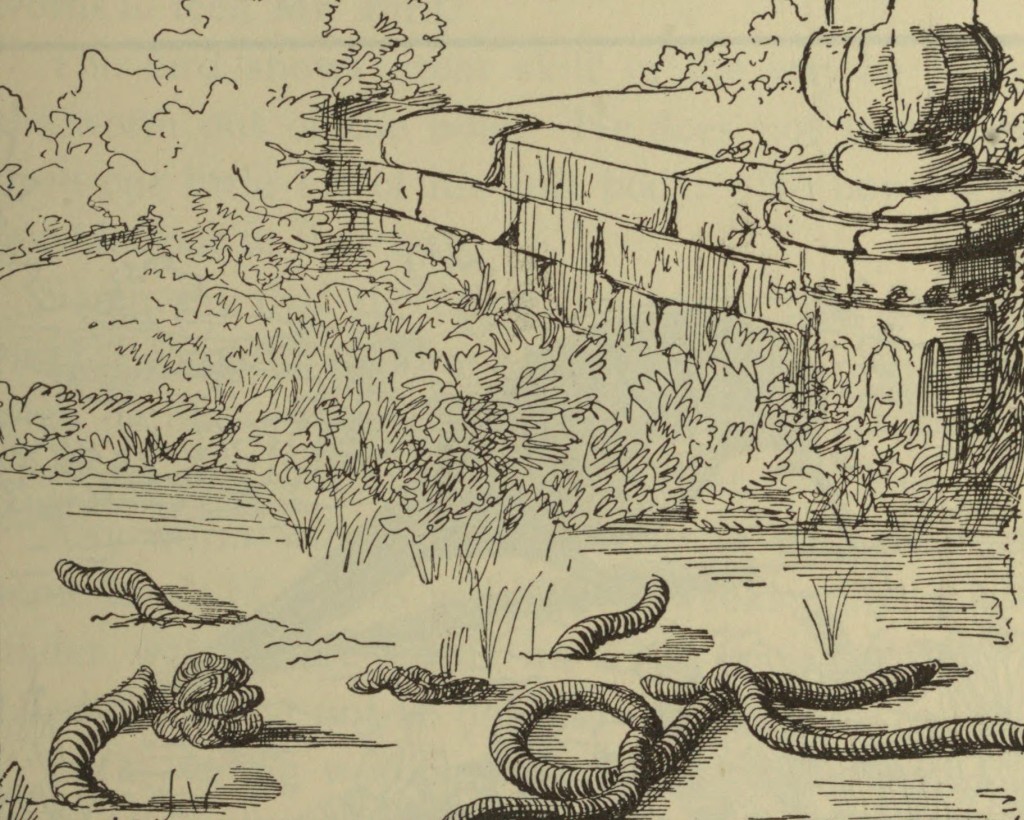
Worms usually come out of their holes at night or in wet weather. If they go far from their house, they cannot find their way back. Then they make a new hole. Each worm lives alone.
[Pg 54]
Often in the evening or early morning, or during rain, you will see worms near their houses. You may find them with their heads just put out of their doors. You will see the worm casts in early day or after rain. It is then the worms dare to come out. Sun and heat dry worms up very fast, and so kill them.
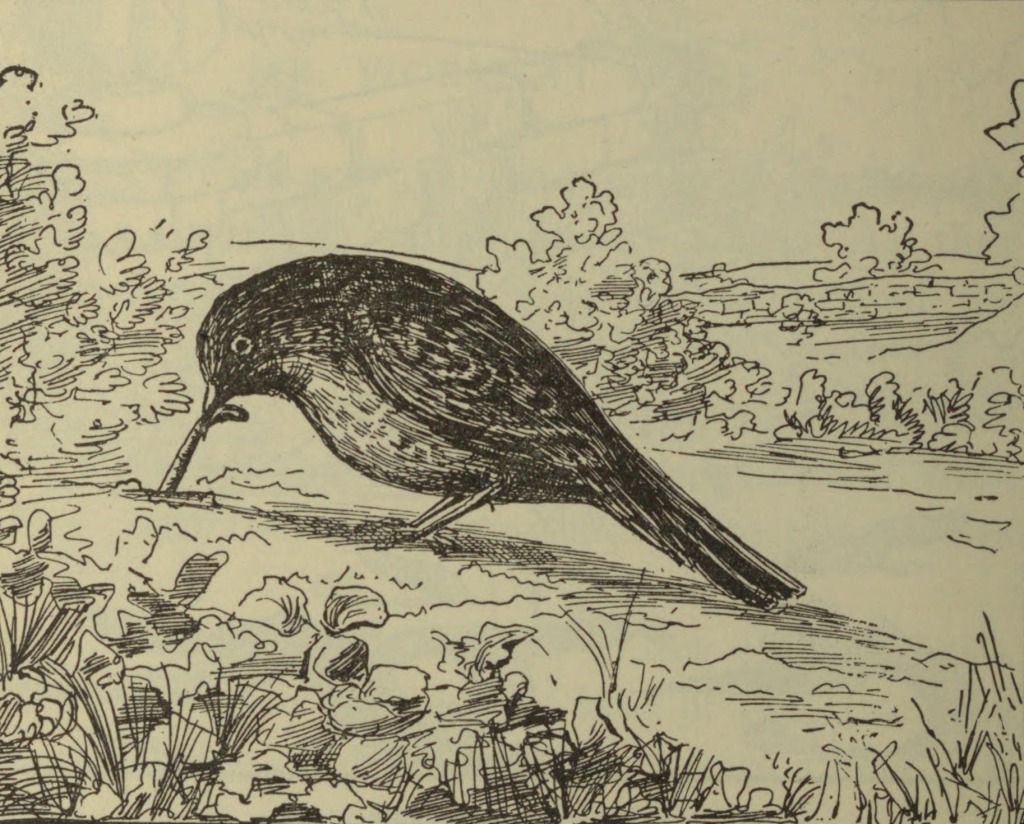
The birds know all these ways of the worms. Watch a robin or a bluebird. He searches for his food at sunrise, or after sunset, or while it rains.
[Pg 55]
Now his keen eyes see the worm at his door! In goes his sharp bill! He pulls like a good fellow! He is hungry. He wants his breakfast. The worm holds fast by his hooks. The bird braces his feet and his tail, and tugs hard. Out comes the worm to feed Mr. Bird.[13]
The bird shows great skill in the way he pulls the worm out of the hole. He does not break off even one little bit of his soft body. No boy could get him out in that way.
Some say that the worm lies by his door at sunrise for warmth. I do not think that is so. I think what he likes is the fresh dew. He loves dampness. He fears cold, but he also dies of heat.
Any worm will die in one day in dry air, but some kinds of worms will live for weeks quite down under water. He needs an even, moist warmth. His home must not be hot, nor cold, nor dry.
Little young worms know how to dig houses, make worm-casts, carry out the soil, find food, and plug up the door of their houses. They know at once all that old worms do. But then worm houses do not require as much skill as bee or wasp houses.
The seaside worms make the prettiest houses. On shells, stone, wood, or wound alone in a lump, you will find their tubes. They are white and as hard as shell. Inside they are pink or blue.
[Pg 56]
These tubes curve and twist about, as the worm went that built them. Some are very pretty. There is a soft kind of tube made of sand and bits of shell, stone, and weed. The sand and weed are held together by a kind of glue. The worm makes this glue in its mouth.
I have some tubes very clear and white. You can see the lines where the worm went when he built them, ring by ring. Some of these tubes are so small you can just run a fine needle into them. Some are as large as a straw, and some as large as a fine fat earth-worm.
Now you see how much is to be learned, even of such a small humble thing as a worm. Think how much even such a weak creature can do!
There is much more to be found out about worms, which I hope you will be glad to learn for yourselves.
[13] See Third Book.
A LOOK AT A HOUSE-FLY.
Look at a worm crawling about on the earth. Then look at a fly with blue or green body and thin wings. See how it whirls in the air! You will say, “These two are not at all alike.”
[Pg 57]
Yet there is one time in a fly’s life when it is very like a worm.
For this reason many wise people set flies and worms next to each other when they study them.
You know, as soon as you look at a fly, that it is an insect.
You have learned that an insect has wings, six legs, a body in three parts, and a pair of feelers like horns.
Insects breathe through all the body, and not by lungs as you do. They have a row of holes in each side to breathe through.
The life of an insect passes through three states. These are the egg, the grub or worm, and the pupa. When it is in the pupa it gets legs and wings. The word “pupa” means baby or doll.
There are some kinds of insects that vary in some of these points. The fly is one that varies from this rule.
If you look at a fly, you will see that it has two wings, not four. It is not one of the hook-wings.
Many insects can fold their wings. The fly cannot fold its wings; it lays them back over its body.
Let us first look at a fly when it is most like an earth-worm. The fly comes, in the first place, from a tiny egg laid by the mother fly.
When the egg opens, the baby fly is not like a fly, but like a little earth-worm, both in its looks[Pg 58] and in the way in which it is made. It is a small white worm with rings, and on the rings are hooks.
If you wish to watch this change, lay a bit of meat in the sun on a hot day. Soon flies will lay eggs on it.
The next day these eggs will be turned to grubs, which grow very fast. The fly’s eggs are small and white, and are put upon the meat as if they had been planted on one end.
The worm of the fly has a pair of jaws like hooks. It has two little dots which will become eyes when it has grown to a fly. In the hooked jaws and these eye-points it is not like an earth-worm.
The fly grub eats and grows. Then its skin gets tough and hard, and forms a little case like a barrel. This shuts the worm in it, as in a coffin. Now the baby fly seems to be dead.
But it is not dead. It is turning into a creature that has wings and legs, and can fly and walk.
As the fly lies in its case, first the legs and then the wings grow. It gets a head with mouth, eyes, and a trunk or tube, and from a poor worm it turns to a wonder, as you will see.
But in its little coffin it is shut close, and its legs and wings are all bent up. In a few days the change is made. Now it is ready to come out.
It moves, and pulls, and gets free from the hard case. Then it strikes the end of the case with its[Pg 59] head time after time. At last it breaks the case open, and out comes the fly!
Then it stands in the air, and in the sun if it can, and shakes itself. It is cold and weak; but the air dries its wings and blows out the wrinkles.
In a very few minutes the fly is strong and gay.
Then it spreads its wings and sails off to enjoy its life, and to look for something good to eat.
HOW TO LOOK AT A FLY.
Do you think a fly is a very small and common thing? Is it not worth looking at? Let us see about that.
First, here is its head with two great eyes. We will soon look at the eyes. Then you will see how curious they are.
There are, besides the big eyes, three little eyes. These are set on the top of the head. Then, too, on the front of the head we find a trunk or tube. And here is a pair of feelers. Inside the head is the brain, very much like a worm’s brain. It is only a tiny white dot.
Next behind the head is the chest. The head[Pg 60] has the shape of half of an egg laid sidewise. The chest is nearly square. It is made of three rings.
On the first ring is a pair of legs. On the next ring is a pair of legs and a pair of wings. The fly has only one pair of wings.
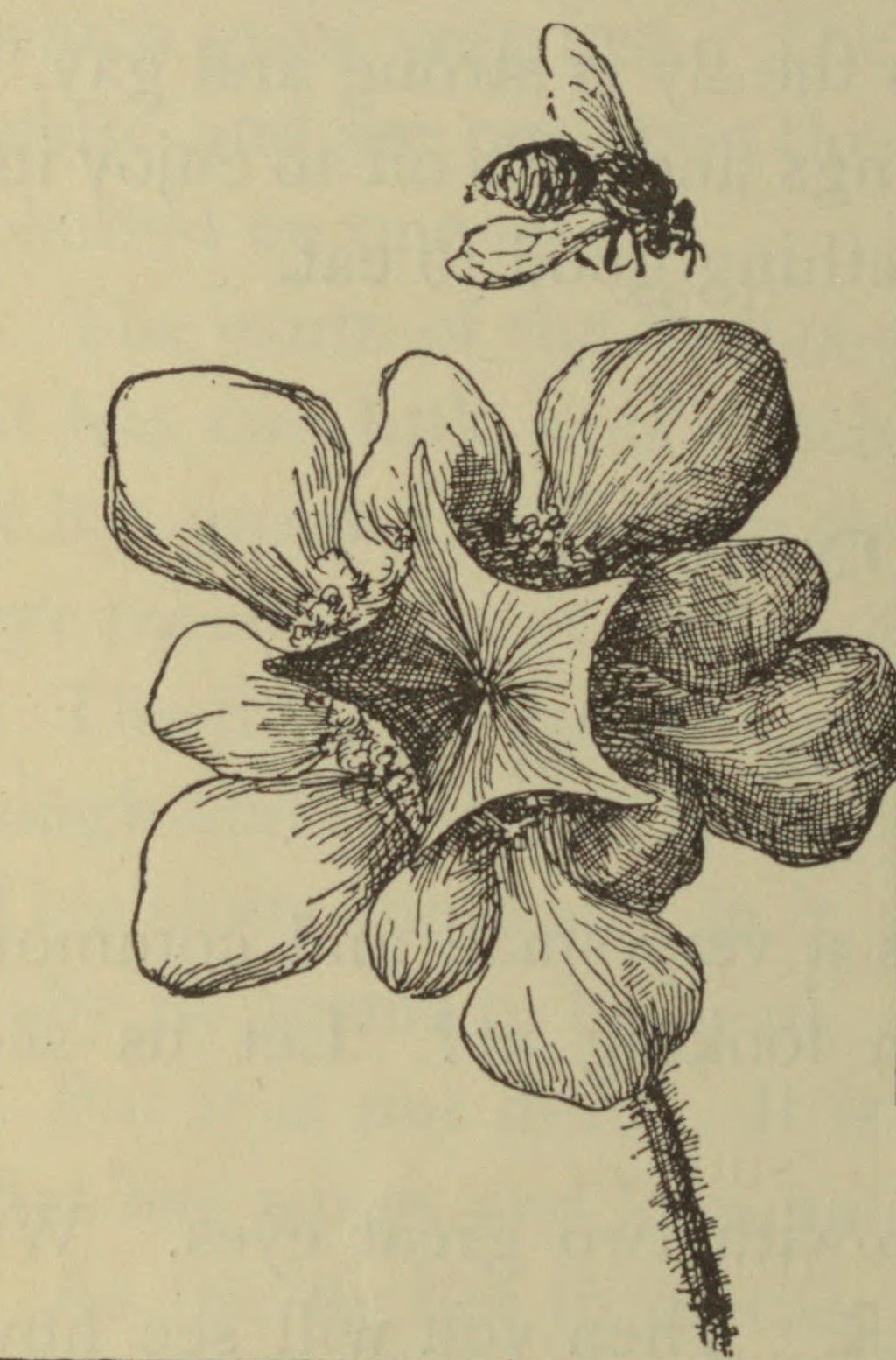
On the last ring is a pair of legs. And near these legs are two little clubs covered with fine hair. It is by means of these clubs that the fly can halt or balance on the wing. They help the fly as the second pair of wings helps other insects.
The third part of a fly’s body is the largest. It is egg-shaped, and joins the chest by the thick end. This part also is made of rings.
Now let us look at the head of a fly. The feelers are like two long, fine plumes made in joints. Most people think these feelers are made to touch with. Their full, true use is not yet known.
[Pg 61]
You see, even in a fly there is much left for some of you to find out.
Some people think that flies smell and hear with these “feelers.” But then they are so fine that a breath can jar them, and the fly might seem to hear when it only feels.
I know of something else like that. It is this. In some schools for the deaf and dumb, the pupils are called to class or table by rapping on the floor. The deaf do not hear the noise, but they feel the jar, and come as if they could hear.
Let us look at the mouth of the fly. The lip of a fly runs out into a long, slim tube or pipe. With this it sucks up its food.
At the end of this tube is a little flat plate. Close by it are two sharp hairs. These are to prick the food, so that the tube can suck it more easily.
When the fly is not eating, it can shut up this tube like a telescope, to keep it safe. Did you ever see an elephant? Did you see his trunk? The fly’s tube is his trunk. The elephant’s trunk is his long upper lip. So is the fly’s trunk a long lip.
The chief parts to notice in a fly’s head are its eyes. These are so large that they make up nearly all the head.
These big bright eyes look as if they had varnish on them. Now each of these eyes is made up of a[Pg 62] very great many small eyes. There are four thousand of these small eyes.
Between these two big eyes are three little single eyes, set in this way—

Wise men have studied the eyes of flies for many years, and do not yet know all about them.
The wings of a fly have a fine, thin, clear covering. This is held out on a tiny frame, like a net-work. The fly moves these wings very quickly. The motion of the wings helps to make the sound or buzz of the fly.
Now we come to the legs and feet of our fly. The leg is made in five joints. The foot also has five joints. The last joint of the foot has two claws and a little pad. These are covered with fine hairs.
The hairs catch on little points or rough edges. Thus the fly can walk, as you would say, “upside down,” and does not fall. Besides, the pad and hairs act like a sucker. They suck air from under the foot. So they hold the fly from falling as he runs up a pane of glass. All boys know what a “sucker” is and how to make one.
[Pg 63]
MRS. FLY AND HER FOES.
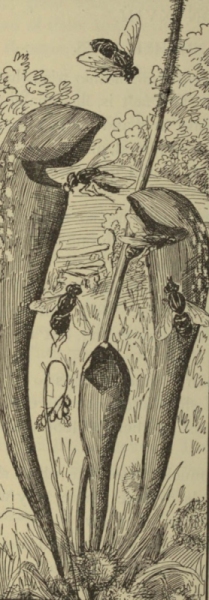
I suppose you have heard your mother wish there were not so many flies. The fact is, flies make us much trouble. Their noise tires and vexes people. They lay eggs in and on the food, and so spoil it. They cover our clean walls and glass with small black spots.
Will you wonder that there are so many flies when I tell you that one fly can in one season be the mother of two million others!
Many insects die soon after laying eggs. Bees and wasps do not, nor do flies. Bees and wasps take care of their eggs and their young, but the fly mother does not.
Mrs. Fly has more than a hundred eggs to lay at once. It is quite plain she could not take care of so many babies. She must let them all look out for themselves.
Still Mrs. Fly shows much sense as to where she puts her eggs. She finds a place where they will be likely to live and get food and grow.
If the place is too wet the baby flies would drown when they leave the egg. If the place is too dry, they would wither up and die. Then, too, they must have soft food.
[Pg 64]
The fly does not lay her eggs on a stone or a piece of wood. She lays them in some kind of food.
The fly can live all summer if it has a fair chance. Cold kills flies. A frosty day will kill them. Some few flies, like a few of the wasps, hide, and live over winter in a torpid state, and in the spring they come out to rear new swarms.
Birds, spiders, wasps, cats, dogs, and some other animals eat flies. These creatures kill flies by millions. People kill flies with poison and fly-traps. If so many were not killed, we should be overrun with them.
[Pg 65]
In the South is a plant with a leaf like a jug. On the seam of this leaf hang drops of honey. Its juice can make the flies drunk.[14]
Flies like this juice. But as soon as they get it they turn dizzy and act just like drunken men. They fall into the jug-like space of the leaf and soon die. One of these plants will kill many flies in one day.
Many of our best birds live on flies, and if our birds were all dead we should have much greater trouble with the flies.
In the autumn you will see flies sitting about as if they feel dull and ill. If you look carefully you will see that the back part of the body is white. It seems to be covered with meal or mould.
Soon the fly dies. This white dust is a disease of the fly. It does not curl up its legs when it dies from this cause. They are stiff and spread out. The fly looks like a live fly. If you touch it, it crumbles to dust.
All around such a dead fly you will see a ring of white mould. This is perhaps a real mould, or tiny plant, that seizes on the body of the fly. It uses up all the soft parts, and so kills it, leaving only the dry shell.
There is another strange thing about this. The[Pg 66] body of a fly that dies in this way is rent or burst open. The fly looks as if this dust or mould had grown large in the body and so torn it open.
[14] See Reader, Seaside and Wayside No. III., Lesson XIII.
OF WHAT USE ARE FLIES?
How often people cry out, “Oh, I wish there were no flies! What is the use of a fly?”
But all things that God has made have their uses. And all God’s works are worthy of study.
You have learned that worms are of great use. Let us see if Mrs. Fly does any good in the world.
Mrs. Fly is of great use to man. She helps keep him in health. Do you think that very strange?
People say, “Oh, these dirty flies!” And yet these “dirty flies” help to keep the world clean!
Now you know that over all the world, great numbers of animals die each minute, and many of their bodies lie on the ground and decay.
Such bodies in decay cause disease and death to men. In winter, and in cold places, such things do not decay so fast, and so do not make these bad odors.
But in hot days, if such dead things lie about, they will poison the air. Soon we should all be ill.
[Pg 67]
The work of Mrs. Fly is to lay many eggs in these dead bodies. In a few hours these eggs turn to grubs, and these grubs to little live worms, which begin to eat as fast as they can.
Soon they leave only dry bones, which can do no harm. They change the dead stuff into their own fat, live bodies.
You know that the crabs are among the street-cleaners of the sea. So the flies are among the street-cleaners of the air and land.
Did you ever watch flies dart about, here and there, with a flight like hawks? They are eating up small, evil things, too small for us to see. But these are yet big enough to hurt us if we should get them into our lungs.
Ask your teacher to tell you a little about your lungs.
In and about our homes many bits of things drop, and might decay and mould. This would make the air foul. But the busy and greedy fly drinks up all the soft part of these things.
So we see that what we call the dirty flies help to clean away much dirt. It is true too, that flies carry poison on their feet and trunks from place to place. In this way they do great harm.
The fly serves for food for many birds, and fish and frogs, and some insects. Some of these things[Pg 68] we use for our food. Others are full of beauty, or are of use to us, each in its own way.
Thus, though the fly is often a trouble to us, we find it is not without its uses. Look at one of these little creatures through a glass that will magnify it. You will see that the poor insect has really much beauty.
From what you have read in this lesson you must not think that all foul smells kill, nor that things that have no bad smell are always safe. There are some gases that have no odor at all, which yet are very deadly.
A SWARM OF FLIES.
Have you heard people speak of swarms of flies? By a swarm of flies we mean a great number of flies rather near together. By a swarm of bees we mean a number of bees that live and work in one place. A swarm of bees divides the work of its hive. It has one queen bee. She is the mother and ruler of the rest.
But flies have no home where they live in common. They have no work. They have no one mother or queen, for whom the rest work. Each mother fly drops her eggs where it seems best to[Pg 69] her. Then she goes off. She leaves her children to grow as best they can.
I have said that the fly likes best to place her eggs on a piece of fresh meat.
These eggs soon turn to worms or grubs, and so spoil the meat. To keep the meat from the flies the cook puts a cover over it. The cover is often made of wire net.
“Now,” says the cook, “I can keep away that dirty fly.”
But Mrs. Fly says, “Oh, can you, Mrs. Cook? We will see about that.”
So Mrs. Fly sits on top of the wire cover. She puts her little egg tube through one of the fine holes in the net. She drops egg after egg from the tube. The eggs fall right on the meat, just where Mrs. Fly wishes them to be.
Then the cook cries out, “How ever did that fly get to my meat?”
Is it not strange that Mrs. Fly knows that her egg tube is the right size to go through the mesh of the wire net? How does she know that the eggs will fall on the meat?
Flies do another queer thing. If many flies are in a room, and you begin to chase them to kill them, they hide. They creep into holes and cracks.
They hide in curtains. They go behind pictures.[Pg 70] After the hunt is over, out they come, one by one!
Flies also know how to sham death, “play dead,” you would say. If you hit one and make it fall, it will lie very still, and seem to be dead. Then, after a little, it softly spreads out its legs and its wings. Then it shakes itself. A moment more, off it goes.
This fashion of making believe to be dead does not belong to flies only. Nearly all insects, and many other animals, sham death. It is worth while to watch and see how well they do it.
When a fly is killed other flies come to eat up its body. They put their trunks or mouth tubes on the dead fly and begin to suck. Soon the body is sucked dry of all its juice. It is only a dry shell.
I will tell you something that you can do with a dead fly. If it has not been dead so long that it has grown too stiff you can make the wings move. Hold it by the body. Gently tip up one wing. As you lift up one wing the other will rise too. They move together. It is as if they were set on a little spring.
It is as wrong to be cruel to flies as to larger creatures. If they are to be killed, do it quickly, and give as little pain as possible. If we do cruel acts, we make our hearts hard and bad.
[Pg 71]
SOME QUEER FLIES.
Although flies are of use, they also do evil to men in many ways. It is well to look at things on all sides.
The fly you have been reading about is the common house-fly. That fly, with its noise, dirt, and spoiling of food by laying eggs in it, is bad enough. But yet the house-fly makes the least trouble of any of its kind.
There are many kinds of flies. To the family of flies belong gnats, midges, mosquitoes, and the big daddy-long-legs with wings.
You know well how some of these things sting, you say “bite,” you. Mr. Daddy-long-legs hurts the grass lands with his grubs, which spoil grass roots and the shoots of plants.
There is a fly called a “gall-fly” because it bites trees, and lays eggs in twigs. Then upon the twigs grow over the eggs round balls called “galls,” and these injure the trees.
There is also the “bot-fly,” which lays its eggs on the hide of the horse. The egg causes the skin of the horse to itch. He licks the place, and the egg goes into his stomach.
[Pg 72]
The egg of the bot-fly is apt to make the horse sick. The grub eats holes in the stomach of the horse. That makes the horse sick. The farmer will say that his horse is sick with “bots.”
In Africa flies kill horses and oxen by biting them. The bite poisons the cattle and causes fever.
Farmers will tell you of a very bad fly that spoils wheat and other grain. It is called the “Hessian” fly.
Flies, as they flit from place to place, sometimes carry with them the poison of disease, as of sores and ulcers. Thus they spread these troubles among people.
But while I tell you of that, I must not fail to say that flies, as they go to flowers for honey, carry the dust of the flowers from one to another. This helps new flowers to grow.
There is a large and handsome bright green fly, very fine to look at, which bites horses and worries them. It is called the “horse-fly.” In some lands a small sand-fly causes sore eyes.
Flies have been on the earth about as long as men have, or a little longer, and there are some dead flies worth a great deal of money.
How is that? These are flies in amber. Amber is clear, hard, and bright yellow. It is used for jewelry. Sometimes we see a perfect fly, held in a clear, light mass of amber.
[Pg 73]
How did it come there? The amber was once a soft gum and the fly lit on it. It stuck fast, and the amber flowed over it and grew hard, and so buried the fly in a clear, golden tomb. A piece of amber with a fly in it will bring a high price.
The “Spanish fly” is a large blue-green beetle. It is very handsome, and is most useful when it is dead. It is used in medicine. It makes blisters on the skin.
Do you say, “Oh, blisters are very bad!” Yes, they cause pain. But even pain can be of use in this world. The blister, though it pains us, is of use. It cures what might be a worse pain.
This Spanish fly is not a fly at all. It is a beetle which has been given a fly’s name. It is put here at the end of the lessons on flies, because in the next lessons you are to read about beetles.
IN ARMOR CLAD.
Go to the garden or to the house plants, and after a little search you will find one of the wonders of the world.
You will find a small, horny, shining, red thing with black spots on its back. “Why!” you say[Pg 74] “that is only a lady-bug, or lady-bird. We say a little rhyme to it.”
The rhyme is—
Yes, it is one of the beetles, and every beetle is a wonder. Come, study this wonder.
The winged insects are divided into two great classes, Eaters and Drinkers. That is what their Latin names mean. Butterflies, house-flies, bees, and others, are drinkers. That is, they get their food by sucking it through a pipe or tube.
This tube is on the fore part of the head; it is really the upper lip grown long and round.
The other great class, the Eaters, eat their food with their mouths. Some suck or lick it; some use their jaws to crush and break their food.
Beetles belong to the class Eaters.
The beetles are covered with a hard, horny shell, like a case. In this they are like the old-time soldiers, who wore armor from head to foot.
Beetles belong to the great family of the ring-made creatures. Take a large, round beetle, with big jaws, feelers, and legs. Does he not look much like Mr. Crab, who is also ring-made?
[Pg 75]
In the pictures in this lesson you see Mr. Crab and Mr. Beetle. This is a large beetle that likes to live among the grasses and weeds near the seashore. When he and Mr. Crab meet on the sand they may think they are cousins.
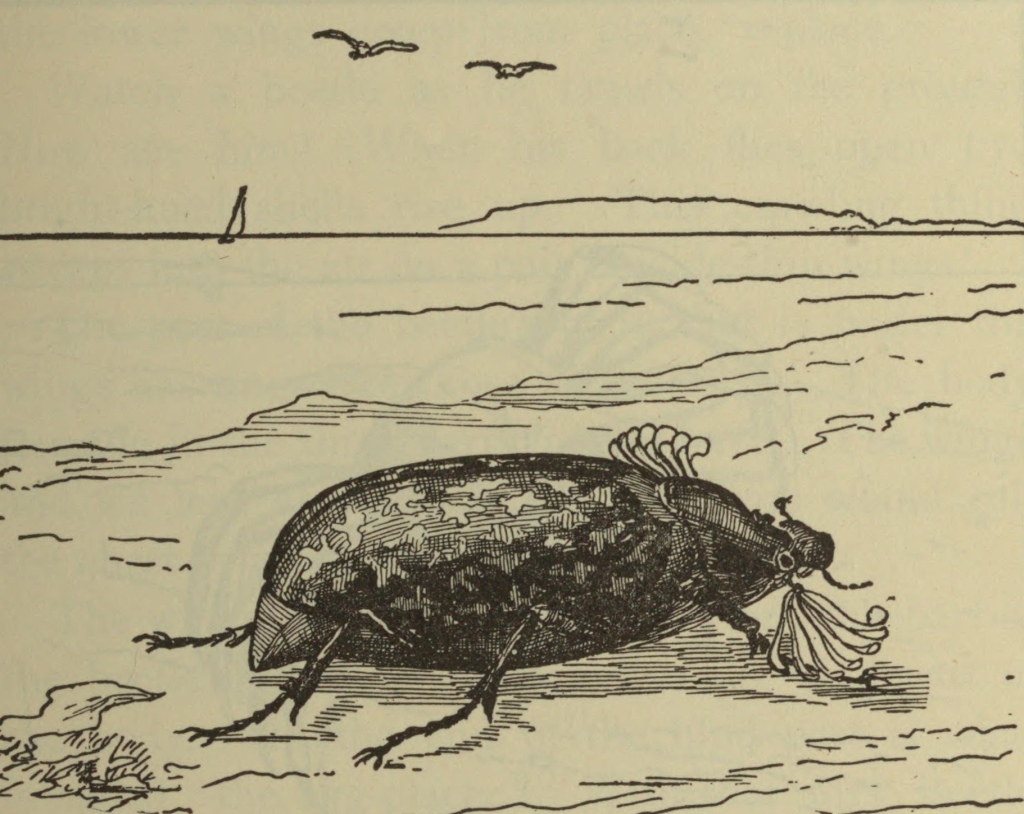
Now let us get a beetle and look at him closely. You will often find dead beetles on your path or in the grass. You can take them to pieces and compare them with what you read about them.
The first thing that you will notice in the beetle[Pg 76] is the hard case over the wing. The wing-cases look like little shells, and have a nice hinge to hold them in their place.
These two wing-covers fit close to each other over the beetle’s back. When he flies he lifts them away from the wings. When you take off these covers you will see lying under the cases a pair of neatly folded wings. These wings are made much as Mrs. Wasp’s are.
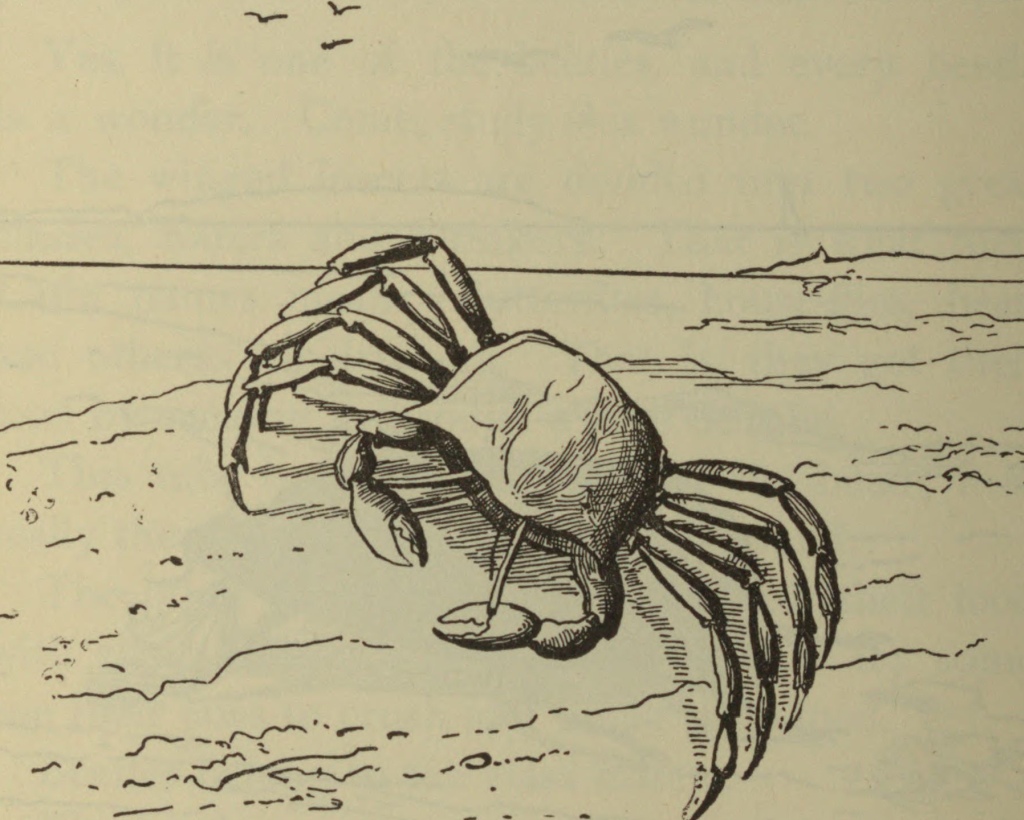
The cases are used for armor, not for flying.[Pg 77] They are really a pair of wings. The fine silken under-wings are the pair with which beetles fly.
There are some beetles that do not have this second pair, and so cannot fly. There are some that have the upper pair so short that they do not half cover the body. Beetles which do not have the lower wings creep from place to place.
Watch a beetle as he crawls on the ground. Now see him! When his back flies open two bright-hued shells rise up. This crawling thing sweeps into the air on a pair of wide thin wings!
The part of the beetle’s body that is under the wings has rings like those of the wasp. The body is made in the three parts insects have. The wings and six legs are fastened on what you would call the chest or middle part.
The wings fastened on the upper or back part of the beetle’s chest fold down over the hind part of the body. On the end of the hind part is what is called “the egg-placer.” With that Mrs. Beetle lays her eggs in safe places.
The legs and feet of the beetle are made in joints. They have hairs on them. The legs are so made and set that they cannot spread out as far as those of spiders, wasps, flies.
Now here is Mr. Beetle’s head. It has two jaws and two feelers, the mouth, and the eyes. There is[Pg 78] a little horn shield over the mouth. In fact, the whole beetle is in a snug horn coat. We may call this coat a suit of armor.
The eyes of the beetle are like those of the fly. Very many eyes are set in what seem to be two big eyes. The beetle does not have three single eyes on the top of his head. Sometimes he has two small simple eyes at the back of his head.
The splendid colors of Mr. Beetle are on his horn coat. I caught a beetle last night which had the under part of his breast covered with close hairs, so that it looked like velvet. He seemed to have on a rich brown velvet vest.
WHEN MR. BEETLE WAS YOUNG.
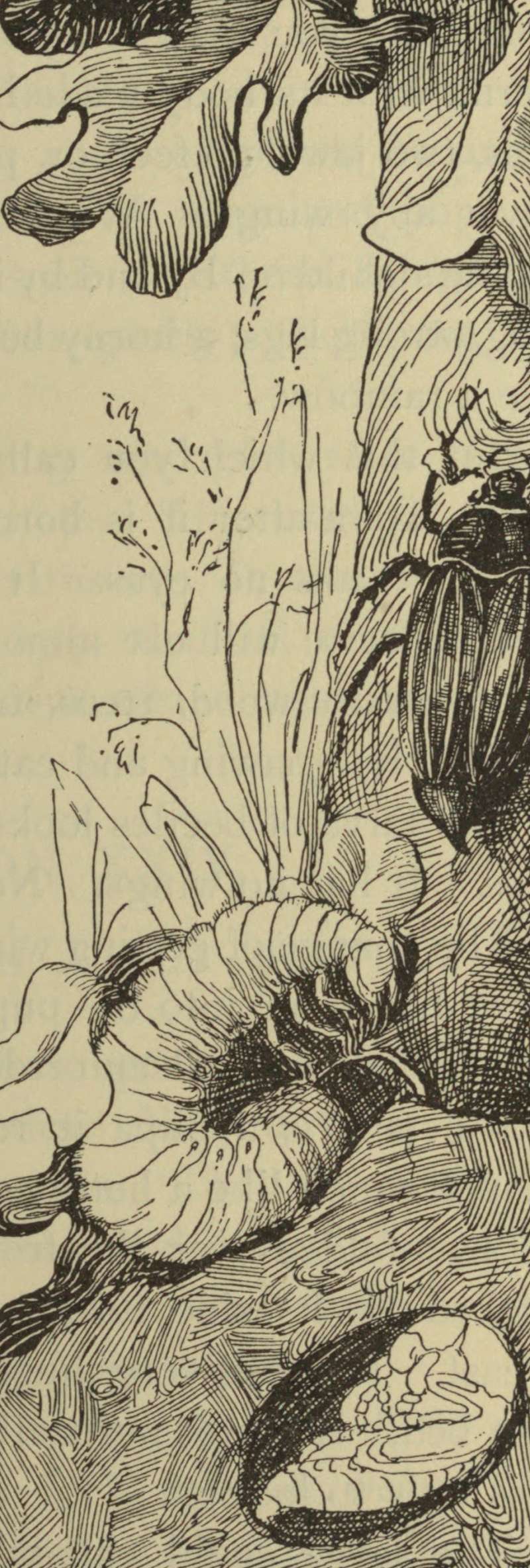
In the lessons about the Ant, Fly, Wasp, Bee, and others, you have heard that the young insect makes three changes.
First it is a small white or light-colored egg; then a fat, greedy larva; then a pupa.
The insects you have thus far heard of, pass through all these changes in a short time. So do some of the young beetles. But there are beetles which spend one, two, three, even more, years, as eggs and grubs.
[Pg 79]
The long part of the lives of these other insects comes after they get their wings. The short part of a beetle’s life generally comes after he is winged.
You will not care to hear about the beetle while he is only an egg. As an egg he lies quiet where the mother beetle hid him. These eggs are placed in earth or in water. Sometimes they are put into the bodies of dead animals, or into holes in trees, or into fruit. Some kinds of beetles choose one place, some another, for their eggs.
After a while the larva comes out.[Pg 80] Sometime you may find a long, soft, stupid white worm, with its body made in rings. It has two big eyes, two jaws, no feet, or, perhaps, very small ones, never any wings. Would you guess it was Mrs. Beetle’s child? By and by it will have strong wings, long, strong legs, a horny body, and very often colors like a rainbow.
But this which you call a “white worm” is the beetle larva after it is born from the egg. Sometimes it has no eyes. It is always very greedy. Beetle larvæ will eat almost anything but metals. They harm wood, trees, fruit, flowers, meal, furs, clothes, by gnawing and eating these things.
The larva of beetles looks like the larva of butterflies. It has no wings. No larva ever has wings.
The change of getting wings must come when the larva has gone into the pupa cradle. Often in this state it lies as if asleep or dead.
When it is a pupa it rests in a case or cradle shaped much like a hen’s egg. There the pupa lies, its legs folded over the front of its body, its wings packed by its side, its jaws and feelers laid on its breast. It looks very much like a baby laid asleep in a bed. It is not pretty like a dear baby. In fact, it is ugly to look at.
The larva could eat, walk, roll, or swim. The pupa in this little case can do nothing but wait.[Pg 81] The full-grown beetle can fly, swim, eat, walk, and is often a thing of great beauty.
If you dig about the roots of plants or under stones, you will, no doubt, find larva and pupa to look at. It is well to seek out these things for yourselves. Handle them gently; these are living things.
In some books you may read of a state of the insect called the image state. This name is given to the full-grown, perfect insect. It means that it has reached the same form that its mother had, which laid the egg. Larva means mask, and pupa means baby.
HOW TO LEARN ABOUT BEETLES.
No class of insects has been more studied and written about than beetles. Why is this? They are not as wise as the ants. They do not build homes and cities, as bees and wasps do. They make no honey and no wax. They have not the many trades of that busy Mrs. Wasp.
There are a few beetles which make little mud cells, or balls of dirt for their eggs, or weave little nests for the pupa. But their work is poor and rude and not as fine as Mrs. Wasp can do.
[Pg 82]
No doubt the reason why beetles have had so much notice is, that there are very many of them, of very many kinds. They live where we can often see them. We can easily take them to pieces, to study their parts, for their bodies are firm and strong.
The parts of their bodies are very curious. Beetles can be kept a long time after they are dead. They will not spoil as soon as soft-bodied insects.
After all, the chief reason of the notice taken of beetles is their great beauty. It is a beauty of color and shape. Often the cases are lined and dotted as if carved with great care.
Would you like to have some beetles to keep, to look at and show to your friends? Let me tell you how to get them.
Have a sheet of thick pasteboard, to fasten them on. When you walk out, carry with you a bottle with a wide mouth and a good cork. If this bottle has broken laurel leaves in it, the beetles will die as soon as you put them in.
Or, you can kill the beetles with a little ether. Or, you can take up the beetle with a little forked stick, and plunge it into very hot or boiling water.
“Oh,” you say, “that would be so cruel!” But the truth is, the beetle dies the instant he is plunged into hot water. He has no time to feel pain.
[Pg 83]
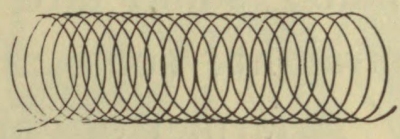
Why do these things kill beetles so quickly? Here, now, is a great fact that you must know. The insects do not breathe through the mouth or nose, as you do. They have no lungs. They breathe through pipes or tubes, wound over all the body. These tubes are very fine, and too small to be seen with the naked eye. They are held open by a little stiff, spiral thread, like this:
These tubes spread even to the legs and feet of the insect. They reach the open air by many openings, or breath holes. Now, when you plunge the beetle into hot water, ether, or laurel odor, all its tubes are filled, and it dies at once. When your beetle is dead, set it on the sheet of stiff paper.
Draw the legs, feelers, and jaws into place with a pin or toothpick. Then fasten the beetle to the paper with a tiny drop of thick glue put under the body. Or, you can put a fine needle or pin through the body. Be very sure that your beetle is quite dead before you put the pin into him.
If you take this way of saving beetles, you will soon have very many, of all colors, sizes, and shapes. They will be brown, black, red, green, golden. I can hardly tell you how pretty the beetles are!
Put some on the paper, with the wing-cases raised, and the flying-wings drawn out from beneath.[Pg 84] The under wings are larger than the upper. You will wonder that the beetle can pack them in the cases.
The feelers of beetles take many forms. Some are like plumes, some are like scales or leaves, some like clubs. Some are nearly round like balls, some are cone-shaped, some plain and straight; some are bent like a new moon.
A farmer or gardener will like your beetles better dead than alive. As he will tell you, the beetles and their larvæ are very greedy things. They often eat leaves and spoil crops and trees.
THE ROSE BEETLE.
The chief family of the beetles is a large one. It is found in all parts of the world. The beetles that belong to it are large, and often of fine color and shape.
In old times the people of Egypt called one of this family the sacred beetle. They kept it as an object of worship. They often wore a stone or metal image of it, to keep themselves from harm.
Let us now study one of this family. It is called the Rose Beetle. That is a very pretty name. The[Pg 85] beetle itself is pretty. It chooses a pretty home and dainty food.

Some call this the Golden Beetle, because of its color. It is a fine large beetle, with a thick body, round at the tail part. The feelers are short and club shaped. The body, head, legs, and wing-cases are a rich golden green, with silver spots and lines.
This beetle does not hold the wing-cases apart when it flies. It tips them only a little. The wide, thin wings come out from beneath them.
The rose beetle is seen most in May and June. You will[Pg 86] find it in the garden, about the flowers. Its chief food is honey and flower petals. Its mouth is not horny, but soft and skin-like.
The feelers have ten joints, and wave lightly as the beetle flies. It likes the sunshine. When it flashes about in the light, it looks like a piece of melted gold with green tints on it.
The rose beetle chooses for its home and food the brightest and largest flowers. It digs deep into the hearts of the roses. It sucks the honey and chews the petals.
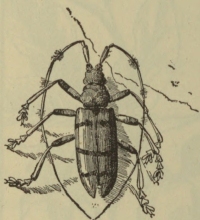
When the mother rose beetle wishes to lay her eggs, she finds a place at the foot of a tree. She goes down among the roots, where the wood is old and soft. Then she puts her eggs between the bark and the wood.
Sometimes she changes her whole plan, and puts her eggs into an ant’s nest! The ants do not seem vexed at this.
The larva of the rose beetle is a fat, round, white thing, like a thick worm. The head is round, and of a pale brown color. The thin skin has hairs on it.
These larvæ move very slowly, and always rest[Pg 87] upon one side. They have strong jaws, and their feelers have five joints. A number of them live together. They are dull and lazy, and always eating. They eat leaves and soft wood.
While the weather is warm, the larvæ keep near the top of the soil. When it is cold, they dig down, even one or two feet, and lie asleep until spring comes again.
They live in this way for three years. Then they make a round or egg-shaped ball. They make the ball of grains of earth, bits of dead leaves, and grass. Or, they use the wood or sawdust they have cut up with their jaws. They fasten all this stuff together with glue from their mouths.
When the larvæ are shut up in this ball, they change very quickly. At first the ball, or case, seems full of a milky fluid. Then the legs and wings grow. After a few weeks the white worm has changed to a fine beetle that looks like a jewel.
Some of these beetles are so fine that they are put into hoops of gold for ear-rings and brooches. In the island of Manila ladies keep rose beetles in tiny cages for pets!
There is a beetle much like the rose beetle. It is called the May or June bug. These June bugs come in great numbers. They eat the leaves of trees, and even kill trees in this way. They fly by[Pg 88] night; and they like to get into a room where a lamp is burning. They are a golden brown color.
They blunder about, making a great buzz with their horny wings. They hit their heads on walls and panes of glass. Some people are afraid of them. That is foolish, for they can do no harm to them.
These June bugs hide all day in the shade. They do not like the sun. It is no wonder there are so many of them, as each mother lays forty eggs. The larvæ do much damage by eating plant roots.
Watch June beetles to see how they lift their wing-covers when about to fly. Look well at the folding of the inner wings.
If you open a door or window on a warm night and set a light in the room, you may soon catch very many pretty beetles which fly about to feast on the sweet white flowers that open after dark.
PRINCES AND GIANTS.
Beetles vary much in size. Some are so small that you can hardly see them as they creep among the grasses.
Others are so large that a child might fear them. He might think that with their thick legs and claw-like[Pg 89] feet and strong jaws they must surely be able to hurt him. But beetles are quiet, mild things, and seldom pinch or bite anybody.
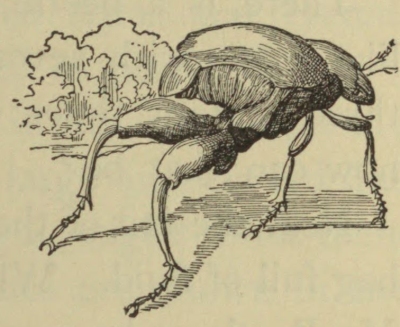
Why do these beetles have these strong coats like mail? To keep them from harm. They live under stones, and among roots, and dig about in the earth. Their horny bodies protect them.
Many more animals, than now do so, might eat the beetles if they had not the horny coats to shield them.
Fish, birds, and other animals eat them and their grubs. Enough are killed and eaten to prevent the world being too full of beetles.
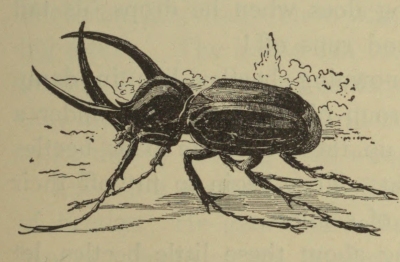
Beetles have few weapons. I will tell you of one or two of them. Stag beetles have very large, strong jaws, and can give a good pinch with them.
One family of beetles is called the “Oil family.” They have an oil in them. They drop this from their legs when they are touched. This oil has a bad smell. It can make a blister[Pg 90] on the skin. Because of this oil people let them alone, and perhaps small animals do the same.
There is a beetle that carries a gun! This is like a gun with several barrels, for it can be fired three or four times without being reloaded! Oh, how can that be?
Near the tail of the gun beetle is a little sack or bag full of fluid. When an enemy comes near him, Mr. Beetle, as he runs, throws off a drop of this fluid. The fluid flies out of the bag with a little bang. It sounds like the report of a tiny gun, and makes a kind of mist or blue smoke.
Three or four of these shots follow each other. This beetle is a small fellow. Big beetles like to chase him. When the wee gun goes off in the big beetle’s face, the big beetle backs away. Then he folds down his feelers and stands still. He acts very much as a dog does when he drops his tail between his legs and runs off!
These little gun-owning beetles live in damp places. Often a group of them will hide under a stone. If you lift up the stone, the poor beetles are in a great fright. They begin to fire off their guns like a squad of soldiers.
Now after talking about these little beetles, let us talk of great ones. I told you some beetles are very small, and some are very large. One beetle[Pg 91] is so big that it is called the Giant. Another is called Goliath, from the huge giant whom King David slew. Others are called Atlas and Hercules, from tales told, in old times, of giants.
The very large beetles live in hot lands and are scarce. Some have the jaws large and curved like a crab’s claw. At first sight you might think them crabs. Some of these odd ones are shown in the picture.
The colors of these great beetles are often very splendid. Some of them have long horns on the front of their heads. Some of them have the hind legs so large, and of such a queer shape, that they do not look like beetles.
Some of these giant beetles have large teeth or knobs upon their jaws; they need them to crush and break their food. These teeth are like the knobs on Mr. Crab’s claw, which he uses for playing a tune. The beetle can use his knobs to make music. Beetles are fond of their own tunes. Often they make, for hours, a shrill hum, or buzz. They make this by rubbing their wing-cases.
There is a great beetle in Brazil called the Prince of Beetles. He gets this name from his size and beauty. Some of the princes have been sold for two hundred dollars each.
When you walk in the field, you might carry a[Pg 92] bottle with a wide mouth. In this you can collect beetles to study. It may be very pleasant to study them when you go home. But have something in the bottle to kill them, for, shut up in a small space, and frightened, they are likely to pull each other to pieces.
THE LITTLE SEXTON.
Once, when I was a little girl, I saw a dark beetle standing on its hind pair of legs. It was holding its fore legs clasped over its head, as you can hold up your hands.
An old man who was near said, “That is a holy bug, and shows what man ought to do. It is saying its prayers. People call it the ‘praying beetle.’”
I think the old man meant what he said, but of course the beetle was neither holy nor praying. The queer way of standing was only one of the odd ways of beetles. Now I will tell you of another.
Very often on the road you will see a beetle, or a pair of beetles, rolling about a small ball like a marble. The ball is of dirt, or some soft stuff, and is often larger than the beetle. But she rolls it with ease, for she is very strong.
The beetle is not playing marbles nor base-ball.[Pg 93] She is only doing her work. She has been flying about, looking for a good place in which to lay her eggs, and now she has gone to work with all her might.
She lays her egg in a morsel of the stuff of which she will make her ball. When the larva comes from the egg, this ball will be its food until it is strong enough to crawl about and seek food for itself. The beetle moulds the soft stuff over the egg, like a pill. Then, as she rolls it about, it grows larger, as your snowball grows when you roll it about in the snow.
When the ball is large enough, Mrs. Beetle does not leave it in the road for wheels to run over or feet to tread upon. She seeks a place where the larva may be safe and feed well when it comes from the egg.
She shows much sense in the choice of a place. She drags the ball along between her hind feet, or she pushes it with her fore feet or her hind feet, or rolls it along toward the safe place which she has chosen. If the ground is so rough that she cannot drag her ball, she carries it on her head.
This Mrs. Beetle’s head is flat, and has some wee knobs upon it. These knobs hold her load firmly in place as she carries it along. Did you ever see a boy carry a box, pail, or bundle on his head?
[Pg 94]
Perhaps Mrs. Beetle finds that she cannot, without help, take her ball to a good place. Then she flies off, and soon comes back with other beetles of her own kind. They all help her until her ball is where she wishes it to be. How does she tell them what she needs? Who knows that? No one. I have seen four or five beetles at work on one ball.
When the ball is in the right spot, Mrs. Beetle digs a hole with her jaws and horny fore legs. Then she rolls the ball in. She fills up the hole with earth and presses it down flat.
This is not the only beetle that buries its eggs. There is another one, called the Sexton Beetle. When it finds a dead bird, or mouse, or frog, or other small animal, it sets to work to bury it. It digs a little grave for it. This is why it is called a sexton.
This beetle begins to dig under the dead body. As it takes out the earth, the dead thing sinks more and more. At last it is deep enough to be covered, as a coffin is covered in a grave.
In this way this beetle helps to keep the earth and air clean. Is that why it buries things? Oh, no! The reason the beetle does this is, it wants to get a good place for its eggs.
These sexton beetles are black, with yellow bands. They are rather large, and go in pairs. You might[Pg 95] think these beetles and the one who makes the ball would be dirty from their work, but they are not.

These beetles have a kind of oil over their bodies. This keeps any dirt from sticking to them. So, though they work in dirty places, they are always clean and bright.
These burying beetles have a keen scent. They can smell a dead body even if it is a long way off. Let us watch Mr. and Mrs. Sexton Beetle at work. Here is a dead mouse. Through the air come flying[Pg 96] these two beetles. Their wings hum as they come.
When they alight, Mr. Beetle goes briskly to his work, and Mrs. Beetle stands looking on. Her work in this world is not to dig, but to lay eggs. Before the work begins, they both make a good meal off the dead mouse. All sexton beetles eat flesh.
Mr. Beetle works a while. Then he drops down as if very tired, and sleeps. Then up he gets and ploughs furrow after furrow about the mouse. Mr. Beetle uses his head for a plough. Now the dead body has sunk out of sight. Mr. Beetle has put over it the earth he took out from the grave which he made. He makes all the little grave smooth and trim.
But what is this queer little fellow doing now? He has made a little side door into the grave. He and Mrs. Beetle walk in. They have gone to take another meal from the mouse.
When their dinner is over, Mrs. Beetle lays some eggs in the dead body. She knows that when the larvæ come from the eggs, they will like to eat the food which they will find all around them. After the eggs are laid, Mr. and Mrs. Beetle come out into the air.
Mr. Beetle fills up the doorway. Then off the two fly to find other things to bury.
[Pg 97]
The larva of the sexton beetle looks much like a beach flea or sand-hopper.
Does the strength of beetles surprise you? They have strong, sharp jaws. Once I found a fine grass-green beetle, with silver spots. I wanted him for my card of beetles. I tied him in the hem of my handkerchief to carry him home. The hem was double, but he ate a hole through it; then away he went.
Once I shut up ten beetles in a box. I forgot them for two days. When I opened the box, they were all dead. They had killed each other. The box had in it only heads and legs and wings. The last beetle that had been left had lost his legs and wings. He had won the battle, but died on the field. Some other great captains have done the same.
THE STORY OF THE STAG BEETLE.
Among the largest beetles that we have in this country are the Stag Beetles. They get this name from the size of their jaws.
If you look at the picture, you will see that the great jaws look like horns. If you should ever see the head of a stag or deer, you may notice that[Pg 98] this beetle’s jaws are very like the stag’s horns in shape.
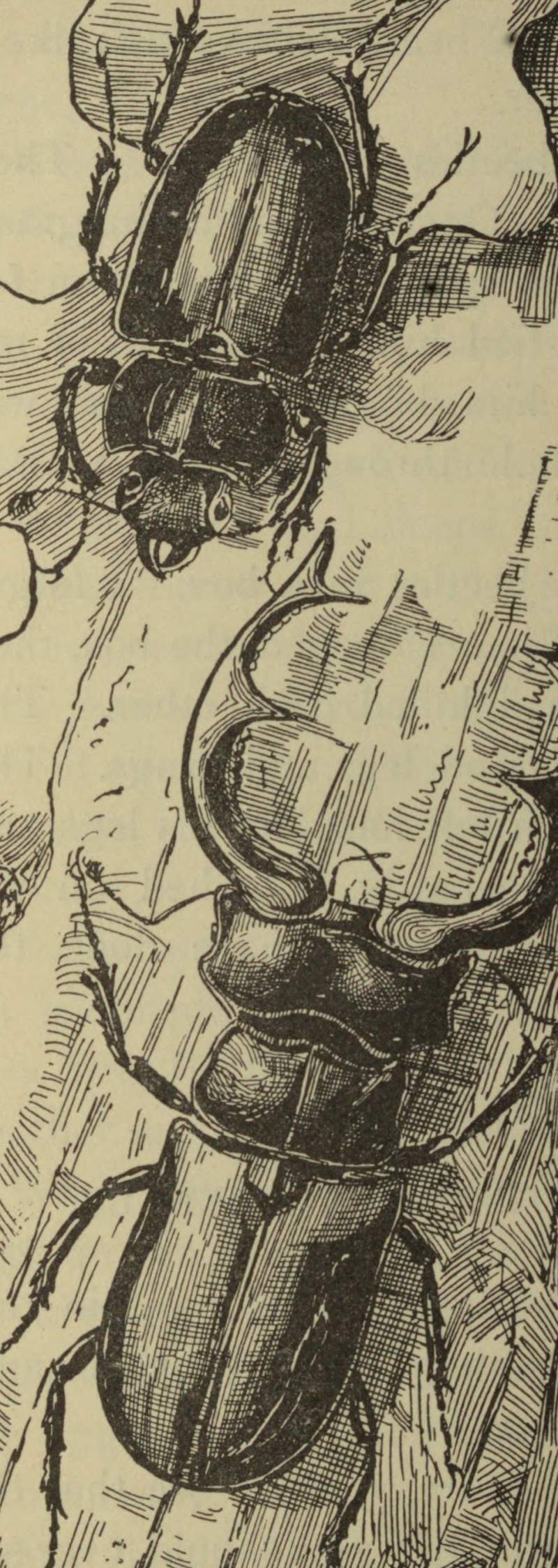
These jaws can give a very hard pinch in time of need. Still you need not be afraid of the stag beetle; he will not hurt you.
The use of these great jaws is not yet fully known. You will see that they have knobs on the inner edge.
Only Mr. Stag Beetle has these horns. Mrs. Stag Beetle has small jaws, and her head is not so wide as her shoulders. Mr. Stag Beetle has a very wide head. He needs a wide, strong head to hold up his big jaws.
[Pg 99]
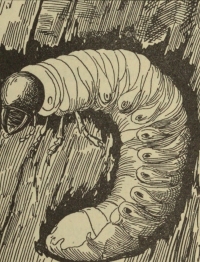
If you will look at the picture of the beetle in Lesson XXII.,[15] you will see that its feelers are like a plume of six feathers. These feathers are so set that the beetle can fold them on each other into a single club, as you can fold a fan. They are called scale-feelers.
The stag beetle has also curious feelers. They are made in scales, but he cannot close them into a club. The scales are set like the teeth of a comb. He has comb-feelers. Perhaps they are of use to him in cleaning his body and legs.
These stag beetles during the day crawl about on trees. They fly by night. Their eggs are usually laid in the trunks of old oak-trees.
The larva of the stag beetle has six strong legs and a pair of strong jaws for cutting leaves and wood. The bark, wood, leaves, and roots of the oak and willow are its chief food.
[Pg 100]
This larva is very large, and lies with its body curled in a half ring. If you look at it, you will see that it has nine round spots down its side, on the rings of its body. It looks as if it wore a coat with big buttons on the side.
Now let me tell you a new wonder. These buttons are the air-holes through which this larva breathes. Come, let us hear the whole story of the insect’s breathing.
You know you draw the air in through your nose and mouth, and this air fills your lungs. You know also that the insect breathes through long, fine tubes. They are kept open with a stiff thread, and wound over all its body.
These tubes have openings for air to pass in and out. These can open and close. In shape they are a little like the lid of a glass jar. These are the holes that we see so clearly along the side of the body of this larva. Both the larva and the pupa must breathe, or they cannot live.
The larva of a stag beetle lives and grows for four or six years; then it passes into the pupa state. When it is ready to change, it makes a case for itself of the fine chips, the juice of which it has been sucking. It binds this sort of coarse sawdust together with glue from its mouth.
When the stag beetle finally comes from this[Pg 101] pupa-case, he is a fine-looking fellow. His head and chest are black, with tiny dots like carving. His wing-cases are a deep chestnut.
There are some stag beetles that never get the large, strong horns. We do not know why this is so. Mr. Stag Beetle with the horns fights with and beats his cousins who have no horns.
Stag beetles are fond of fighting. They are like Mr. Crab in that. They have duels with each other.
Mrs. Stag Beetle does not behave in this way. She looks on at the fight, but takes no part in it. Her business is to lay eggs in safe places. She has no time to fight. And then—she has no horns!
MR. BEETLE SEEKS FOR A HOME.
I shall now tell you of a very odd beetle. If ever you find one of this family, you will say, “This poor beetle has outgrown his coat!” You will say that when you see how very short his wing-cases are.
But no! the beetle has not outgrown his coat. Insects do not grow after they leave the pupa-case. Mr. Beetle and his coat are both of the same size that they always were.
In fact, this beetle’s coat was cut short for him[Pg 102] at the first. It is the fashion in his family to wear short clothes! The flying-wings of this beetle are large, but the wing-covers are very short. They do not cover half the length of the body. Yet this beetle can fold up and tuck his flying-wings under the short wing-cases.
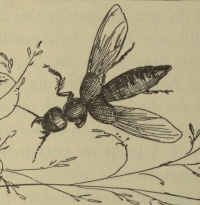
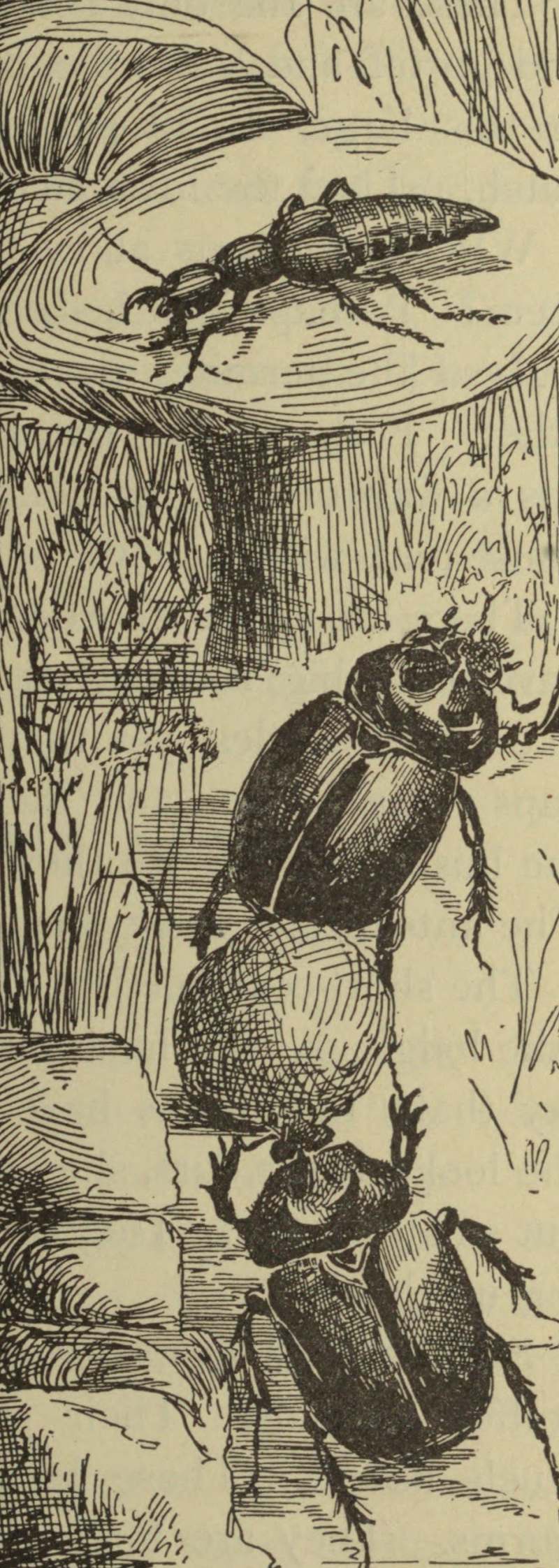
Most of the short-coated beetles are small. Some of them are an inch long. They are very lively insects. They are very greedy little creatures, too.
Some of these beetles eat only animal food. They are always busy hunting for it. Others of them are fond of mushrooms. Some of them have a bad smell. People do not care to touch them.
Since their hard shell coat is so short, it would be easy to hurt them. No doubt they have this bad smell to keep away creatures that would eat them. The smell keeps them from harm.
The “short-coats” do not all have a bad smell. Some beetles with long coats have this foul odor. There are also beetles that smell like roses, and like musk.
[Pg 103]
Some of the short-coated beetles curl the hind part of their body over. The end is held up above their backs. If they had a long, hard coat, they could not do that.
You have read about the termites, or white ants.[16] In Brazil people may find one kind of the short-coat beetle living in the nests of the termites.
These beetles that live with the termites are very strange animals. The back part of their body is too large for the front part. It looks like a great ball, and is turned up over the upper part of the back.
[Pg 104]
These are the only beetles that do not lay eggs and go off and leave them. They keep their eggs in this large, round part of the body until they hatch. Then the little larvæ come out alive.
Why do the ants allow these beetles to live with them? Perhaps it is because they make no trouble and so the termites do not care one way or the other. Perhaps, like the little Aphis,[17] this beetle has a way of making honey; if so, it pays for its house-rent with honey!
There are other short-coat beetles which do not have these big, round bodies. They lay their eggs like other beetles, yet they live in ant-hills. Perhaps these beetles and their larvæ like to feed on the husks and rubbish they may find in the ant-hill. The ants do not drive them out.
The short-coat beetles are not the only ones that take lodgings. Perhaps you may hear your mother say that “the moths have got into her furs.” If she looks at the furs, she may find, not only moths, but small beetles. They are having a fine time eating up the fur!
Such beetles destroy furs, skins, skin rugs, and stuffed animals. Their greedy larvæ can make much havoc. These larvæ are like tiny black worms. They are fond of ham, bacon, and lard.
[Pg 105]
One very large short-coat beetle is called the “coach-horse.” The larva of this coach-horse beetle looks like the full-grown insect. It carries its tail aloft, in the same way. It can run fast, and seeks its food all day long.
These larvæ often hide under stones. In the winter they go deeper under ground. They are fierce, and they eat animal food.
The baby lives only about three weeks in the pupa-case. This case is of an odd shape, like a wedge, with a rounded top. It is of a shining gold color, and has a plume or crown of hairs in front.
THE LITTLE WATER-MEN.
You know of spiders that live on land. You also know of spiders that run upon the water. There are also land-beetles and water-beetles.
The water-spiders have rafts, boats, skates, and diving-bells. They sit and float on lily leaves. Their homes are cool and bright under the clear, still waters.
There is also a happy race of beetles that have all these things. The story of these beetles is like the story of a fairy prince, but it is a true story.
[Pg 106]

All living things are fitted for the places where they are to live. The animals that live in cold lands have thick fur. Birds are made with light bodies,[18] so that they can fly easily. The fish have scaly, pointed, slippery bodies, so they can glide swiftly through the water.
So you must expect to find that the water-beetles are not quite like the land-beetles. They have bodies made fit to live in their water-home.
If you place a water-beetle beside a land-beetle, you will see that the parts of the water-beetle fit[Pg 107] more closely than the land-beetle’s. They join each other so as to form a smooth, water-tight case. When we build a boat, is it not our first care to make it tight, so that it will not leak?
Next you will see that the water-beetle’s body is longer, narrower, and more pointed in front than the land-beetle’s. It is made so as to part the water as it moves along. The water-beetle’s shape is more fish-like than that of the land-beetle. When we build a boat, we do not make it broad or square at both ends. We make the fore-part narrow and sharp, to cleave the water as the fish does.
As the water-beetles will swim much and walk very little, their first and second pairs of legs are small and feeble, but the hind legs are wide and strong, and reach far back. They are used for swimming.
Mr. Swimming Crab has broad hind legs, used for oars or paddles. Mr. Water-Beetle’s legs are made in much the same way, and have hairs or bristles upon them.
Though the water-beetles are to walk but little, they are to fly much, and so their wings are fine and large.
In fact, the water-beetle likes to fly. Very often he flies at night, and he seems to delight in a clear moonlight. Then the water of his pond spreads[Pg 108] out like a sheet of silver, and the crickets chirp in the grass. The air is moist and cool; it is sweet with the scent of flowers.
On such nights the water-beetles rise quite high into the air, and fly here and there, as if full of joy. Then they turn, close their wings, and drop into the water with a plash, like a stone.
When a number of these beetles drop with this quick plash, what do you think happens? Why, the green frogs who sit on logs or rocks, with their big eyes above the water, dive in a great fright. I wonder if the beetles think it is fun to scare the frogs? The frogs give a loud croak as they dive.
The larvæ of water-beetles live in the water, as their parents do. They are very greedy, and hunt their food as if they were angry. They have large jaws, shaped like a sickle. Their bodies are long and narrow, and they have on each side of the head six tiny eyes.
With so many eyes, they can see all about them, so they keep out of danger. They also see bugs which they wish to catch. Their straight, narrow bodies dart through the water with such quick motion as Mr. Crab has when he runs on the sand. They pounce on their prey, and their curved jaws hold it fast.
Some of these great water-beetles have a sharp[Pg 109] point, like a thorn, on the under side of the breast. This is not of use to kill what they eat, or to fight their enemies. The beetle seizes his prey with his jaws, or with his fore feet. But if you try to hold him, then he draws his body back, and drives this thorn into your hand.
Water-beetles have flat pads on their feet, as water-spiders do. The hairs on these pads hold tiny bubbles of air.
When these beetles wish to fly, they do not rise straight out of the water; they climb up the stem of some plant. Then, when they are high enough to make a good start, they spread their lovely wings, and skim away.
If you watch the ponds, you may see a water-beetle floating with his head down, and the tip of his tail stuck out of the water. What does he mean by that queer action?
He is getting air to breathe. Though he lives under the water, he breathes air, and he is filling up his diving-bell; or, rather, he is turning himself into a diving-bell. How does he do that? Let us see.
This beetle’s wing-covers are air-tight. The mouths of his breathing-tubes open under the wing-covers. When he has used all the fresh air he had, he wants some more. So he comes to the top of the water, turns his head down, and spreads out his feet[Pg 110] to balance himself. Then, with a little jerk, he drives out any air that is yet under his wing-covers.
Then he draws in fresh air, shuts his wing-covers up close, and goes down with plenty of fresh, pure air to breathe.
I have known people who will shut themselves up in a room and breathe the same air over and over again.[19] The beetle, you see, is more sensible. He knows that if he is to keep his health and spirits, he must have good, fresh, clean air to breathe. So he takes all this trouble to get pure air.
WHIRLIGIG BEETLES.
There is a Mrs. Water-Beetle who has on the under side of her body two little knobs for spinning silk. These are much like the silk-spinners of Mrs. Spider.
As soon as this Mrs. Beetle has laid some eggs, she goes to work, like a good mother, to keep her babies safe and warm. She spins a little silk ball, or bag, for the eggs. This ball is water-tight. It is woven so close that it does not leak. It is so light that it will float.
There are other beetles, and fish, and frogs in the[Pg 111] water, that are seeking food, and they might eat these eggs, but will not touch them when in this tough silk ball. The balls are of a fine bright color, like gold thread.
Another of the water-beetles makes a little silk bag, packs it full of eggs, and glues it to the under side of a leaf of some water-plant.
You know that a fly has a little pair of wings, called alulets, below its true wings. One of the beetles has such clubs or alulets. So you see in one part they are somewhat like a spider, in another part somewhat like a fly. And some things about them are like what a crab has.
Among all animals you will find points of likeness between one creature and another.
Did you ever see a whirligig beetle? He takes his name from the top, or whirligig, because he spins round, and round, and round. Go to the pond, and you will see some of these merry fellows. They act as if they felt so happy that they could not keep still.
These whirligigs are of a fine bronze color. They use their hind legs for oars, and their fore legs for rudders. They have their eyes divided, so that each one seems to have a pair of eyes on each side of its head; one half the eye looks up, and one looks down.
[Pg 112]
These are small beetles, and they whirl, whirl, whirl. Then they stand still for a second. If you make a dart at them, and try to catch them, you will find that it is not easy to do so.
These whirlers lay their eggs on leaves above water. The larvæ spin silk pupa-cases which hang on leaves, or on stems, above the top of the water.
These and other water-beetles live in ponds or very quiet streams, not in swift water.
I hope the peep you have had at beetle-life will make you wish to study it more. Study not so much in books, as out-of-doors for yourself.
Of what use are beetles? Wise people have not yet found out very much about the use of beetles. Some of them, as you have read, devour or bury spoiled things, that it would be bad to have lying about on the ground. They help to keep the world clean.
Some of them eat insects that harm plants. Some of them make good food for fish, birds, and other creatures. But very many of the beetles do much harm to plants, clothes, and other valuable things. On the whole, I fear that beetles are pretty rather than useful!
[Pg 113]
WHAT A FISHERMAN TOLD.
One day, on the sea-beach, I saw a man mending a net. He took from the net two small things like shells. They clung to the meshes of the net. They were white and hard. They looked like two or three shells put one inside the other.
The fisherman said, “There are in the world more of these things than there are leaves on the trees, I think.”
“Where do they grow, Mr. Fisherman?”
“It is easier,” said the fisherman, “to say where they do not grow, unless I just say, they grow wherever there is sea-water. The pier yonder, below high-water mark, is covered with hundreds of them. All the rocks that we see bare at low tide are white with them. Every log or stick that drifts on the sea has them on it. All the old shells on the beach, and many new shells, have dozens fastened on them.
“I have seen an old King Crab crawl up the beach,” the fisherman said. “He had his shell so coated with these things, that it seemed as if he had two shells, one on top of the other. It was so heavy that he could hardly walk.
[Pg 114]
“I have also seen them growing in the skins of whales, and sharks, and other fish. I have sailed all around the world, and I have found these things everywhere.”
“What do you call them, Mr. Fisherman?”
“Some call them Sea-Acorns, some Sea-Rose-Buds. These are pretty names; but Barnacle is the right name.”
“Do you know, Mr. Fisherman, that they are cousins of the crabs?”
“I’ll never believe that,” said the fisherman. “They do not look like crabs. When I was a boy, folks told me that out of these shells came a little bird that grew into a goose. I saw a picture once, of a tree all covered with big barnacles, and out of each one hung a little bird’s head. Is that tale true? They were not quite like these barnacles.”
“No, Mr. Fisherman, it is not at all true. No birds grow from barnacles. That is an old-time fable.”
“Well,” said the fisherman, “once in the water I saw something hanging out of the shell of a fellow like this. It opened and shut, and looked a little like a bird’s foot.”
“It was a foot, Mr. Fisherman, but not a bird’s foot. It was Mr. Barnacle’s own foot, and as he has no hands, he uses his feet to catch his dinner.”
[Pg 115]
“I know,” said the fisherman, “that horse-hairs in ponds will turn into long worms. But I never did think these shells would turn into birds.”
“And horse-hairs will never turn into worms. Long, thin, black worms in ponds look much like the hairs of a horse’s tail, so some people think they must once have been horse-tail hairs. But it is not so. Horse-hairs are always only horse-hairs, and worms all come from eggs which were laid to bring out a worm.”
“It is a pity,” said the fisherman, “that when I was a boy in school my books did not tell me of these things. It would have been nice to know what I was looking at as I went about the world.”
Now let us study these barnacles of which our fisherman spoke. He told us truly about their number and where they grow. He told us what he knew because it was what he had seen.
There are two kinds of barnacles,—those that have stems, and those that have no stems. The kind that has no stems is the kind you will see oftener, though there are plenty of the other kind.
The stemless, or acorn barnacles, are placed flat upon whatever they grow on. Try to pull one off a stone. You cannot do it while the animal is alive. When the animal is dead or dying, you can move the shell from what it grows upon. After the[Pg 116] animal has been dead some time, the shells drop from their places, and leave room for others to grow.
All barnacles do not fix themselves upon dead bodies, such as stones, wood, or shells. Many of them fasten upon living animals, and are carried about with them from place to place. Perhaps they enjoy travel!
In the North Sea many sharks have barnacles growing upon them. The stem of the barnacle has little hollow hairs, and these enter into the flesh of the shark and hold fast there. Others have been found keeping house upon the whale’s skin, and yet others on the shells of turtles.
These barnacles which you find by the shore are small things, you can hold several of them in your hand at once. Far down in the ocean lives a huge giant barnacle, so big that some of you could hardly lift him.
MR. BARNACLE AND HIS SON.
The Barnacle has a name which means hair or ringlet-footed. People thought his little fine curled-up feet looked like small curls of hair. His body is like a small bag or sac, with the six pairs of little[Pg 117] curly feet placed at one end. The body is made of rings as are the bodies of insects. All the six pairs of legs are on the chest rings. Each leg has two joints, and a little branch like a fine fringe. The hard shelly cover of the barnacle is made of plates lapped together. When they are closed they look something like buds on trees, or young pine cones. When the fringes of the feet wave out between the edges of the shell-plates, it looks as if the buds were about to open into flower.
A barnacle is more like his far-off cousin Mr. Crab when he is little than when he is grown up. Every grown-up barnacle must be firmly fastened upon some other body. The barnacles are divided into two classes, according to the way in which they are fastened upon objects: 1. Stem Barnacles, 2. Stemless Barnacles.
A stem barnacle has plates which form a three-cornered shell. It grows fast to some object by a small stem which is soft, and can bend about easily.
A stemless barnacle has a shell shaped like an acorn, or like a rosebud with the top bitten off. Instead of a stem, it is held fast to the object on which it grows by a thin plate of shell at its broad, or flat end. This plate has a tiny hole in the centre.
When you first saw a barnacle, you would not think it was any relative of Mr. Crab. When[Pg 118] grown up it does not look at all like the Crab Family. When crabs and barnacles are very young, they look more like each other.

Let us look at an acorn barnacle. The shell is in plates, as if two or three shells were set one over another. The shell grows by added bits of lime, as a conch shell does. The thin skin that lines it, and holds it together, is shed, like Mr. Crab’s coat. Then the shell has room to grow.
The shell is hard and white. It is lined with[Pg 119] a very thin skin, which often has a faint, pretty tint.
The stem barnacles have long, flesh-like stems which move and sway with the motion of the water. They look much like a little, queer, pale plum hung by a thick stem.
The end of the barnacle, which clings to the stone, log, shell, or fish on which it has fastened itself, is the head end. The two feelers, which all these animals have, are turned into two fine tubes, or pipes. These feelers have little glands or sacs which make a strong cement. Cement is like glue, but much more strong and stiff.
This cement fastens Mr. Barnacle to his place. So after he has settled himself in life, he never wanders about any more.
Did Mr. Barnacle ever go abroad? Oh, yes! When he was young he swam about the water-world, in a very brisk way. Let us hear about that.
Mr. Barnacle makes the same changes of life that an insect does. First he is an egg, then a larva, then a pupa, and at last a steady old barnacle. But the larva barnacle makes two or three changes of shape before it turns into a pupa.
Barnacles grow fast. They change their coats often when they are young.
Here is an old acorn barnacle fast upon a stone.[Pg 120] It is about as big as the end of your little finger. It has some eggs which it packs into the shape of a small leaf. It tucks this leaf of eggs into a fold of the thin skin that lines the thick shell.
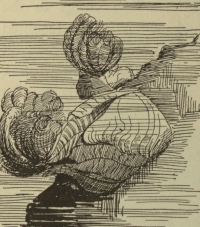
As the eggs get ready to hatch into larvæ, the old barnacle is also growing, and making more shell. Soon it is ready to enlarge the outer shell. So the inside skin cracks apart and falls off. By degrees some barnacles become quite large as fresh shell grows from within.
When the old inside skin falls off, the eggs are set free. Out of them come the larvæ. The larvæ are active, hungry little fellows, who know how to swim as soon as they are loose in the water.
The larva acts as if it liked to be free from the shell prison. It darts about in the sea, and each day its shape changes. It has one eye, a mouth, two feelers like horns, and six legs. It can swim, and can walk over sea-weed.
[Pg 121]
Some parts of this gay little larva will one day turn into tubes to make cement to hold it fast to a stone. Then it will be a stay-at-home barnacle all the rest of its life long.
When the larva becomes a pupa, it drifts about until at last it is time for it to stop travelling and keep still. Then it fixes itself by its head to the place that will always be its home. All it has to do after that, is to fish and eat. As it makes new shell, it will enlarge the old shell. And it will have little eggs, packed in the shape of a wee leaf between the skin and outer shell.
By and by Mr. Barnacle has a hard shell of many plates, his eye has gone down near his stomach. Do you think he can see what he eats? His legs are not used for walking, but to fish with; his mouth is near his feet. The rest of his head has gone off with his feelers, to attend to making cement and shell. What a queer creature he is!
A FISHING PARTY.
Did you ever go fishing? Did you fish with a rod and line? Or, did you sit on a pier and let your line drop into the water from your hand? Or,[Pg 122] did you go out with the boats and see the men throw a net into the water?
There are many ways of fishing, and now I shall tell you of some queer little fishers and their ways. Why did you want to catch fish? Oh, just for fun!
My little fishers fish for food, and they eat their fish without any cooking. Their fish are so small that you cannot see them without the help of a glass that magnifies.

I saw a fishing party to-day. There were twenty fishers in it. They were all dressed in white coats. They all sat on one stone.
“What a big stone!” you cry. You had better say, “Oh, what little fishers!” For, to tell you the truth, I covered the whole party up with one of my hands!
Was this a fairy fishing party? No; it was a barnacle fishing party. I will tell you about it.
The sun shone on the water, the sea was still, and the tide was slowly going out. It was half-low tide. A gray rock lay in the water. The water was yet about two or three inches above the top of the rock.
On this rock were about twenty stemless barnacles, clean, white, and acorn-shaped. They were of the size of small acorns. You must know that barnacles grow. They are of many sizes. Some[Pg 123] are the size of a small glove-button. Others are of the size of a small acorn, or of the end of your little finger.
As I looked at these twenty little fishers, the plates of the shells were opened a little. Out of the top of each shell came a fine little plume, like five or six tiny feathers.
This plume waved up and down in the water. It seemed to open and shut gently, as you would open and shut your hand.
Every now and then this little plume was drawn quite back into the shell. In a minute out it came again and waved as before. What did all this mean?
It meant that the barnacles[Pg 124] were having a fishing party. They were catching their dinner while the tide was over their shells. Mr. Crab gets his dinner at low tide, and hides at high tide. Mr. Barnacle fishes and eats at high tide. At low tide he shuts his shell house and clings to his place. He is waiting for the tide to come up and cover him once more.
When Mr. Barnacle opened and shut this fine plume, it was his net, or his set of lines with which to fish little live creatures from the water. He tangles his prey (or food) up in his fine plumes.
Among the things he catches are tiny crabs, too small for the naked eye to see.
When the plume net is full, he draws it into his shell. Then he empties it into his mouth. After this he puts his plume out of his house once more, to fish for other things. In the meantime, he feeds on what he has taken. He has no pantry in which to store things, as Mr. Crab has.
Near this fishing party on the stone, drifted a log. On the under side of the log were some stem barnacles. They were fishing too. They fished in the same way, and for the same kind of things.
They opened their shells, pushed out a lovely plume, and this pretty thing caught food in its meshes.
Does their net never break and need to be[Pg 125] mended as the fisherman’s net does? No doubt, if it does, a new piece will soon grow. What is his net? It is Mr. Barnacle’s feet. If any of them are lost or hurt others will come, just as Mrs. Crab gets new legs when some are gone. Notice these tiny legs. They look very like a cluster of long fingers or toes. He uses them to fish with. For what else should he use them? He never walks nor swims.
A LAST LOOK AT MR. BARNACLE.
It is well to know all you can about barnacles, for you will see them wherever you go by the seaside.
If you study them, you will not, like the fisherman, believe foolish things about them, and refuse to believe true things.
Will it not be pleasant to think of what you know of their story? When you see an acorn barnacle fast to a stone, you can think of the days when he was young and went sailing about. I wonder if he calls those days “the good old times!”
When you see a stem barnacle swinging in the water, you can think of what a good time he is having, fishing with his pretty feet.
[Pg 126]
The stemless barnacles also have, from their shape, a name which means acorn. You will find the Latin names easy when you are older and study more.
The acorn shells can live out of water for a few hours at a time. When the tide is low, many of them are left high and dry. But if they should be out of water too long, they would die for want of food and water. Perhaps, also, the dry heat of the air kills them.
If you wish to study them for yourselves, take home a stone, shell, or stick, with some of them on it. Put it in a bowl of sea-water. Soon they will open their shells and begin fishing.
Those barnacles which grow fast to living fish, sharks, or whales, bury their heads and tubes in the skins of these animals. I wonder if the whales and sharks feel them and do not like them.
The barnacles that make the most trouble are those which fasten upon the outside of ships. The bottoms of ships are often covered with barnacles. They make the hull of the ship rough and heavy. That hinders its motion through the water.
In such a case the ship must be put into a dry dock. There it is scraped clean. Because of this trouble and waiting, sailors dislike barnacles. They often say that they wish there were none.
[Pg 127]
In some parts of the world there is a large kind of barnacles. People eat these as we eat oysters or mussels.
You need not expect to see the young barnacles swimming about in the water. They are very tiny creatures, of the shape of an apple-seed. If you should see them, I think you would never guess what they are.
For a great while people thought barnacles were not worth much study. They called them “shell fish,” and did not dream what wonders were hidden in their shell-plate cases. At last, when wise men knocked at Mr. Barnacle’s house door, and said, “Come out and tell me your secrets,” they found he was a most interesting little creature.
FLOWERS OF THE SEA.

There are flowers in the sea as well as on the land. Under the waves of the ocean are fields of green sea-grasses and groves of great sea-weeds like trees. Diving-men go down to the sea-bottom and walk about. They often find it hard to move in the tall weeds. The weeds tangle the men’s feet. The divers feel as you would among the brush and[Pg 128] vines of a great wood. There are splendid sea-plants of all colors,—red, pink, white, green, brown, purple, yellow, and orange.
The leaves of these sea-plants are of many shapes. They are round or long; they are flat or curly. Some are cut into fine fingers; many are like fringes; they have spots, dots, or knobs upon them that shine like silver and gold.
The sea has also another kind of flowers. These are animals or fishes that look more like lovely flowers than like any other thing. We call them sea-flowers or animal-flowers. We name some of them after dainty little plants that grow in the woods in spring.
The name “flowers” which we give to these is only a pretty fancy. You must know[Pg 129] that really they are a kind of animal. It is, then, flower-animals that we shall now study for a few lessons.
You have read of animals made upon a ring pattern; these flower-animals are made upon a star pattern.
The pattern on which they are made is very simple (see cut), and yet it is so built upon and changed that the members of this Family are among the most lovely of animals.
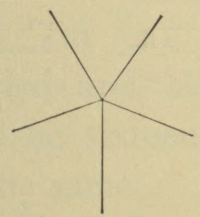
These animal-plants have, from their odd and pretty shapes, such names as the sunflower, the aster, the fern, the crown, the fan, the pen, and so on. I will now tell you about one of them.
Early one day I went from my door to the beach, which was near, and there I saw a lovely object.
The water was very still and clear, and floating in it was something all rose and cream color.
This pretty thing was as large as a very large dinner-plate. It was not flat, but shaped like half an orange, with the rounded side up. It was of a fine rose color, and as clear as jelly. It looked much like pink jelly.
From the centre of the top to the edge went lines of a deeper pink. There were also dots around the[Pg 130] outer edge. This edge seemed to have a soft full ruffle of cream color about it. Looking closer, I saw that the under side was not flat. It was shaped like a bell or an open parasol. It had something which looked like long leaves, and which opened and shut.
But this was not all that I saw. From the darker lines on the upper part of the bell ran out long pink arms. These were almost a yard long. Their edges had full ruffles. They were of a cream color, like soft lace.
These long arms hung down in the water, which spread out their pretty edges. With a soft and gentle motion they waved from side to side.
In my boat I went quietly near this creature. It floated here and there, spread out in all its beauty. I kept near it to watch it. This lovely thing was a jelly-fish.

It was easy to see that the creature was of a star pattern, but it had four, and not five rays. Its plan[Pg 131] was like Figure 1. If these rays are bent down, you will see that they may form the frame of a bell-shape, like Figure 2. The ends of these four rays often run out into arms, like Figure 3. All the soft pink-and-cream jelly-like stuff fills up between the upper part of the rays and gathers into the ruffles along the edge.
This is the plan on which the jelly-fish is built. His frame is built of four rays. The four parts between the rays may be again divided and be eight and not four. Again, there may be sixteen rays instead of eight. But the plan is the same.
THE LIFE OF A JELLY-FISH.
It is from the clear stuff between the rays, the stuff which forms the bell or disk part, that the jelly-fish has its common name.
It has also another name, which means nettle, from the plant called a nettle. The leaves of this plant can prick and sting your skin, and make it burn. The fine, long arms of the jelly-fish can sting in the same way.
The jelly-fish is nearly all water. It is made of flesh as fluid as the white of an egg. If taken from[Pg 132] the water, jelly-fish die in a very short time. They die by drying up. A very large jelly-fish will dry to a thin, small skin.
I do not know of any other living creature so soft, or so nearly all water, as a jelly-fish. And yet these are true animals. They can hear, see, feel, and, no doubt, can also taste as other animals do.
All along the edge of the bell part you can see some dark dots, which are the eyes. Some of the jelly-fish have these little eyes bare; that is, they have no lid or cover over them. These are called bare-eyed jelly-fish. Others have a little hood like a lid over each eye. Also along the bell part are little sacs which take the place of ears. The long arms which droop from the edge of the bell are the feelers. These are used to touch things with. They wave gently to and fro and help the fish to move through the water.
Up in the centre of the under side of the bell is the mouth. It has over it a little fine frill. Even a jelly-fish, you see, does not wish to keep its mouth wide open all the time!
Below the mouth, the jelly-fish has fishing-lines or nets, as the barnacle has. The soft, pretty ruffles move up and down in the water, and catch things to put into the mouth of the jelly-fish.
It would surprise you to know what large and[Pg 133] hard things these soft jelly-fish can soften and use as food. Fish, crabs, shell-fish, are caught and eaten by jelly-fish.
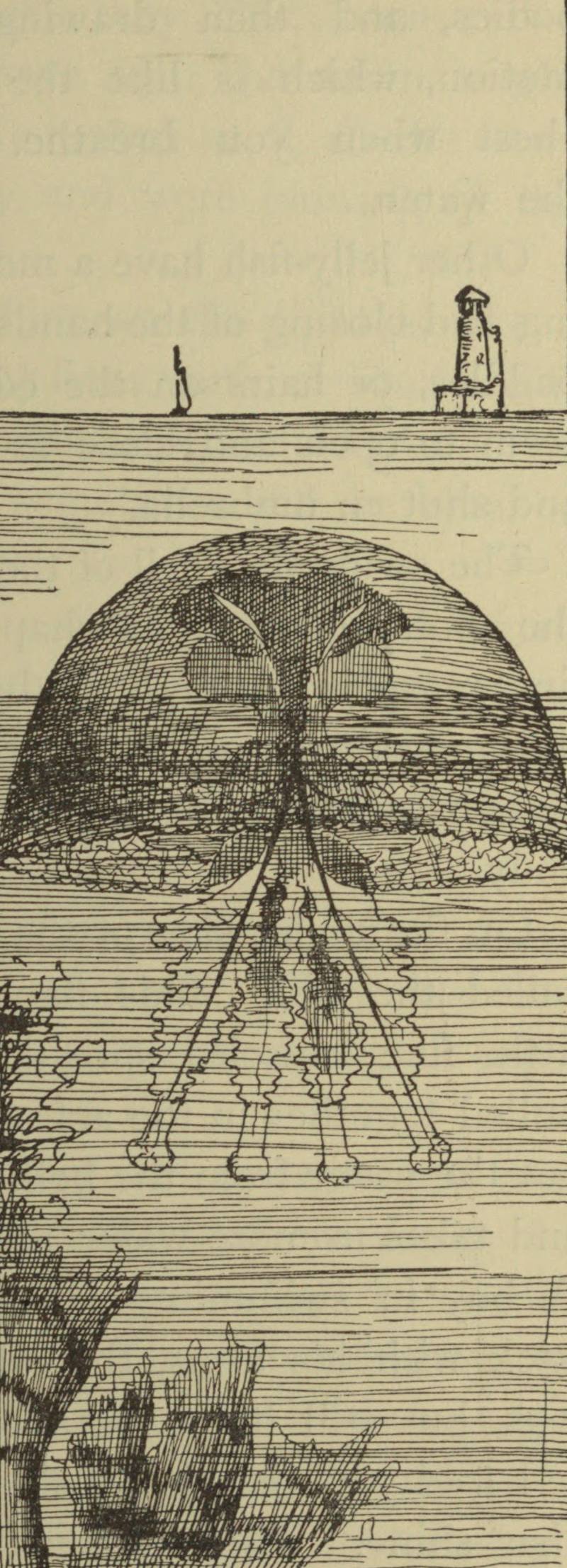
There is something in the jelly-fish which can dissolve these hard things. He often casts out from his mouth-sac the harder and larger shells and bones. He does this as you would put from your mouth nutshells or plum-stones.
How do the jelly-fish move in the water? They have no swimming-feet as Mr. Crab has. They have no fins, as the fish has. Some of them move by spreading out the bell, or round part, of their[Pg 134] bodies, and then drawing it up again. This motion, which is like the rise and fall of your chest when you breathe, drives them through the water.

Other jelly-fish have a motion more like the opening and closing of the hands. Some have little oars, paddles, or hairs on the edge of the disk. Some seem to open and close as you would slowly open and shut an umbrella.
The swimming-bell of the jelly-fish is often called the umbrella from its shape. This bell has little fine muscles through it, by which it can spread out and draw together. You know you have muscles by which you can move the parts of your body.
On the under side of the swimming-bell, is a flap called the veil. This flap turns inward, and the little fine muscles spread over it. This veil is pulled together in the act of swimming, and pushes out the water from the bell. Then the bell spreads and takes in more water, and again it is driven out. A boy in swimming parts and pushes the water back with his arms, the jelly-fish has no arms or legs, but still it moves about easily.
I told you that jelly-fish could sting. They can also shine. They can make a fine bright light, something as glow-worms or fire-flies do, but more[Pg 135] steady. From this power, they have been called Lamps of the Sea. I have seen the ocean bright with them for miles. It looked as if all the stars had fallen from the sky, and were glowing in the water.
When the jelly-fish shine so, the light is like a ball. It is not in straight lines, long, or square. It is round, like fire-balls, or balls of melted iron, or of glass. These balls are sometimes red, or blue, or white, or green, or yellow.
Jelly-fish differ much in size. Some are so small that you can hardly see them; some are as large as a split pea. Then some are the size of a dime, of a dollar, of a plate, and so on, up to the size of a huge wheel.
As they are of many sizes, so they are of many shapes, as I told you at first. They are like balls, fans, bells, bottles, plumes, baskets, cups, flowers.
And now, here is another odd thing to tell you. You know that when Mr. Barnacle is young he swims about. When he is grown up, he settles down to stay in one place. The jelly-fish stays in one place, and grows fast, when he is young, but when he has grown up he swims about wherever he chooses. I wonder which is the better way! Which way would you children like best?
[Pg 136]
Some of the jelly-fishes come from an egg. Some of them come from what is called a bud. Let us look at them from the bud or from the egg. The egg at once fastens to some solid thing on the sea-bottom. It grows into what looks like a plant with stems and branches.
On these branches are little cup-shaped buds. These buds are so many little jelly-fish growing on one stem. This is the larva state. After a time, these buds open, and a young jelly-fish breaks from the slender stem, and at once goes swimming away, as happy as a jelly-fish knows how to be.
[Pg 137]
SEA-STARS.
Now we come to another animal who seems to be made on the star plan. Here you see pictures of him in the water, where he has his home. Is he not a pretty thing?
The jelly-fish has one of his names from his shape, and another name from his power to sting. This fish gets one name from his shape,—star-fish. And he has a long, hard name from his coat. His coat is a thick, tough skin. It has upon it prickles much like those of a hedge-hog. Most of them have five rays, or ten, because each single ray has been made into two, and so on.
All of the star-fish do not keep to the plan of five. The sun-star has twelve rays. He is of a splendid, bright-red color. These animals seem to be made on the star plan; the grown-up sea-stars show this shape most clearly, but it is never perfect; the young ones are two-sided, not star-like.
From their general shape they are called “stars,” from their skins, “rough or hedge-hog coated.” This skin is really their skeleton: they have their bones outside like the crabs and some other creatures.
[Pg 138]

The crab’s skeleton is hard, the sea-star’s is more like a tough skin filled with little plates or spikes of shelly stuff. Sometimes these little plates lock together, sometimes they merely lie near each other, so some of the stars have much softer coats than the others. In the water these coats are tough and bend like leather. When they are dry they are brittle. If you want a dead star-fish to bend, drop it into water.
I will tell you of some kinds of star-fish, and then will tell you how they grow.
In the picture you see a star-fish with[Pg 139] the thin, crooked rays, or arms. He is called a sand-star, because he likes to lie close to the sand on the sea-bottom. He is of a sand color.
The one with the curled arms, like plumes, is called the brittle-star. That is because he breaks so easily. He is a very queer fellow. When things do not please him, he drops all to pieces. It would be a queer thing, if, when you feel cross or afraid, you could throw yourself down and fly to pieces, jerking off your head, your arms, and your legs!
You have heard how crabs can drop off a claw, and then another grows out. You also know that a spider does not mind much about losing a leg or two. These facts cause us to feel sure that these creatures do not suffer pain at the loss of a part of their bodies. If the loss of legs, claws, or rays caused pain, these animals would not be so ready to drop them.
There is no other creature that breaks itself so readily and so entirely as the brittle-star. It will throw off all its rays, and they will float away in many directions, while the little disk is left alone to sink or to float.
When the star-fish loses one or more, or even four rays, others will soon grow. All the animals of this family renew lost parts even more easily than crabs do.
[Pg 140]
It is very hard to get a brittle-star out of the water. As soon as it feels a net or scoop or the upper air about it, or a pail of fresh water rising gently around it, it breaks into many pieces.
On the end of every ray is a little sharp eye. When you frighten Mr. Brittle-Star, off swim his legs, every one by itself, and each has its one eye to look out for it. I never saw anything else so queer; did you?
The strong, prim-looking star-fish, with five points, is called the cross-star. It is the common, or pattern star-fish. There are many other kinds. I will tell you in the next lesson of one very pretty kind. You must go to larger books to learn all that is known about these strange and lovely creatures.
We will look at the model, or cross-star. Turn the animal over. The mouth is in the centre of the under side. Do you not find there is a seam, or groove of the hard skin, all the way down the centre of each ray? From the mouth a nerve runs down to the point of each of the rays.
Along the centres of the under openings in the rays are set very, very many little blunt points. These points are like tiny tubes close together. It is on these that the star-fish can walk or creep on the bottom of the sea, or over rocks. The star-fish seek their food as they crawl slowly about.
[Pg 141]
Star-fish are very greedy. They are always hungry. They make the fishermen much trouble by eating the fish-bait off their hooks. They also devour oysters. When they get into an oyster-bed they are as bad as the drill. When an army of star-fish go to a part of the coast where oysters grow, the oysters are soon killed.
The star-fish are of many bright and pretty colors. They are green, brown, gray, red, pink, or with several colors on the same star.
When they are dead, the flesh, which has much water in it, dries away. The tough shell-like skin is left. You can dry them by pinning them on a board. Leave them for a few days in the sun and wind. If you do not pin out the rays, they may curl up.
They look better kept in alcohol, but that is not a good way for children. I fear the bottles would soon be broken.
A SEA-CHANGE.
The star-fish lay a great number of eggs. Let us see what happens to eggs of one kind. They are not dropped one by one into the water, or strung on threads like chains.
[Pg 142]
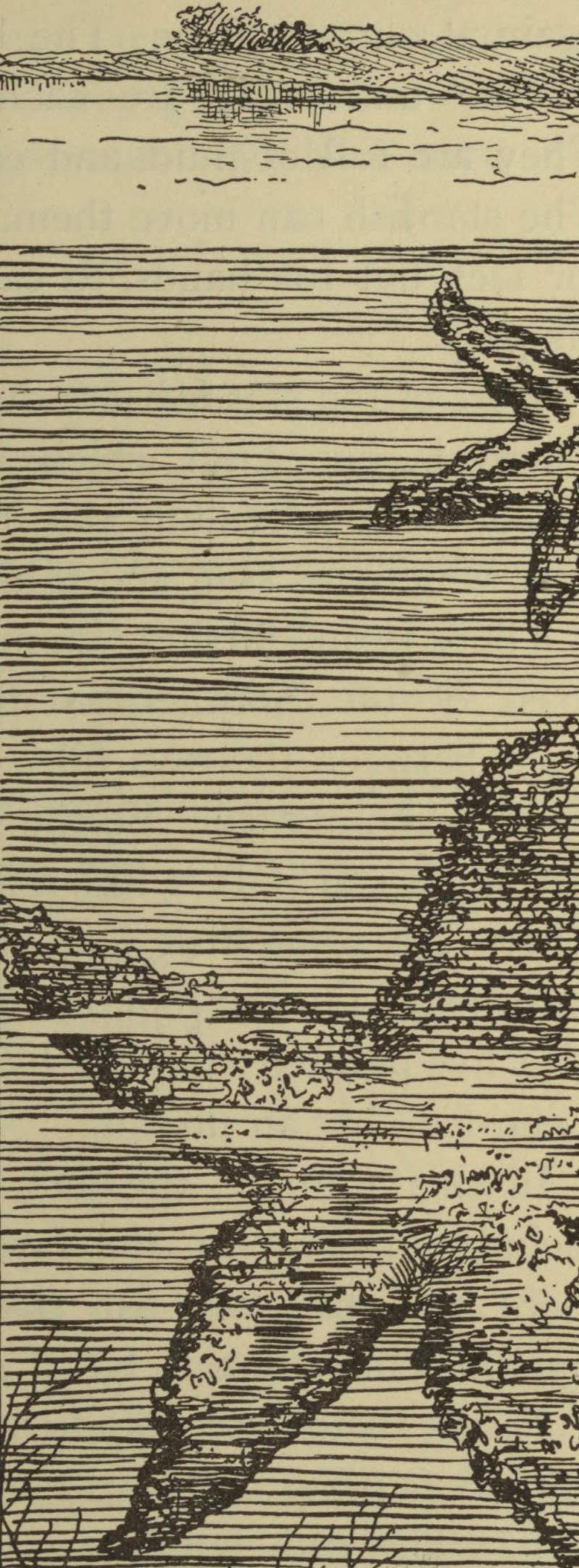
They stick to the under-side of the parent fish, which settles on the sand or rocks, resting on its back, and bends up its five rays, like a basket, to hold and protect the eggs.
You see that in this state the parent can neither walk nor eat. And although star-fish are both greedy and restless, when they have eggs to take care of, they patiently lie quiet for ten days, until the eggs hatch.
In those ten days the parent star-fish cannot eat nor move. But at the end of ten days, the eggs hatch out the larvæ, and they float away. Then the star-fish finds that its work is done, and it bends back and begins to walk, swim, and fish.
Many of the larvæ, when they first come from the egg, have no rays, and do not look one bit like star-fish. They look like wee specks of barrels, with little hairy hoops, and a plume of hairs on one end.
The larva can swim; the hairs help it through the water. Slowly it begins to change its shape and to lose its loop of hairs. All it wants is to swim and to grow. When no larger than a flaxseed it looks like the grown-up star-fish.
A most curious thing is the lily-star egg, which fastens upon a coral, or something firm and hard. Then it takes as fast hold as the barnacle on the rock.
It shoots up a stem, and on the top of the stem[Pg 143] grows a cup like a lily-bell. It does not look like a star-fish, but like a lovely lily. Fine plumes are waving from its cup.
Some kinds of star-fish have larvæ that take other shapes. I cannot tell you about them all. But only the feather-star grows fast to some object for the larval state. In that state they do not look at all like the parent. Finally, like the jelly-fish, they change their shape, get loose, and swim off to see the water-world. Then they are like their parents.
Now let us look[Pg 144] again at our star-fish. The little things like tubes on the under-side are each one set in a grove. They are full of fluid, and each has a tiny sucker. The star-fish can move them. They not only serve for feet, but for hands, to catch, and hold, and kill his prey.
Most of the star-fish are dull and slow of motion. There is one kind which moves quickly. It is called the Snake’s-tail-Star, from the shape of the rays, which are long and thin.
There is one of these animals often found on the coast of the Southern states, which has all the space between the rays filled up with a hard, stony, or shell-like matter. So the shape of this animal is not like a star. It is like a flat box with five sides. There are some little loop-holes quite through this hard box. On the middle of the top is the pattern of a five-pointed star-fish, like a picture! It is not a star-fish, but an urchin.
In this Radiate, the disk spreads out, so as to include, or shut in, the rays. On the one hand, there are some star-fish that have the disk very small. They seem to be all rays and no disk.
People who have studied star-fish divide them into six families. I have told you about all but the fifth. The fifth family are of such a queer shape that they are called cucumbers—Sea-Cucumbers.[Pg 145] The Chinese like to eat them, and ships are sent out to fish for them. They grow in the shallows, near the islands in tropic seas. We have some also on our coasts.
THE STAR-FISH WITH AN OVERCOAT.
There is a very pretty star-fish called the Sea-Egg, or Sea-Urchin. This creature has not five points or rays; it is in the shape of a ball, somewhat flattened.

Do you say, “Can this belong to the Star-fish Family, when it has no rays?” Well, let us see. Let Figure 1 represent our Ray pattern. Bend the rays up, and the plan looks like Figure 2. Then bend them until the tips touch, and you have the form of Figure 3. The cover of this star-fish, called the sea-urchin, is not tough and skin-like; it is hard and shell-like.
[Pg 146]
If you look at it, you will see that it has up and down it lines of knobs and dots set in double rows. You will find five double lines of large knobs, and as many lines of small dots between the larger ones.
Do not think that you can see these marks as soon as you find a sea-urchin. By no means! The sea-urchin wears a fine thick overcoat, which hides his shell.
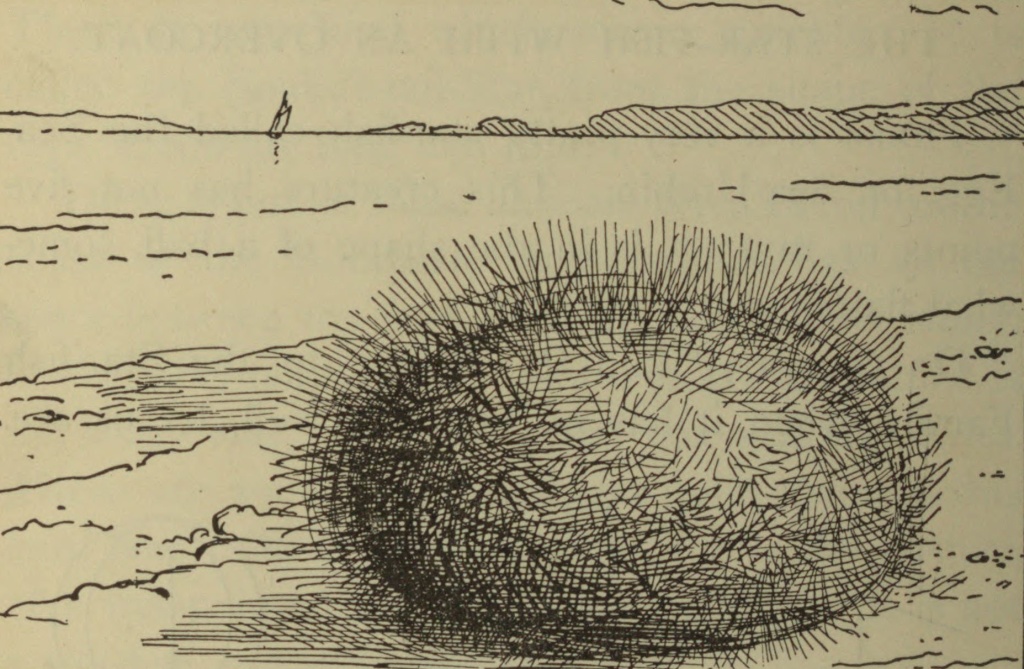
I knew a boy who found a number of sea-eggs lying on the beach. He cried out, “Oh! look at all the chestnut burrs in the water!” The sea-egg when it is alive looks much like a chestnut burr, ripe, but not open. It is covered all over with[Pg 147] thorns or prickles like the burr, and the water gives it the dark brown color.
Now let us look into this matter. You have read that a cross-star-fish has along the under edges of its rays many little tubes full of something like water. He can move them, and upon them he walks.

The sea-urchin has hard, sharp spines, which cover all the shell, and look like a rough coat. In the pictures you see the urchin with his shell bare, with his shell half bare, and with his full overcoat of quills. When the shell is bare, you will see upon it little lines of points or knobs. These are very pretty, but they are for use, rather than for beauty.
[Pg 148]
On every tiny knob is placed a spine, and the urchin can turn and move his spines, in all directions, just as easily as you can move your arm at the shoulder-joint.
When the urchin is alive, the quills stand out all about him. After he is dead, the quills drop off.
Between the rows of knobs are five double rows of holes, like pin-pricks. Out of these grow such little suckers as I told you the star-fish had.
In some countries the sea-urchins are small—not much larger than a dime. In warmer seas the urchins grow large, even as large as a large orange. People often use these larger ones for food.
The sea-urchin walks on his spines, as the cross-star-fish does on his. But as the quills of the urchin are all around him, like a ball-cover, his walk is a roll! By the little suckers he can cling to the rocks, and he can climb up their sides.
Turn over the bare urchin shell, and you will see that while at the top it has no opening larger than a pin-prick, on the under side there is a hole where the curved rays do not come entirely together. You see the urchin must have this open place for his fish-lines, and to put food into his ever-hungry mouth.
[Pg 149]
Since the sea-urchin eats so much, he must grow! Does he?
Yes, the sea-urchin grows, and it cannot cast its shell as a crab can. It has not a soft skin as you have, yet his shell is never too tight. How can the shell expand as the urchin grows?
The shell is made up of a great many little plates, or scales. As the urchin within grows and needs more room, these little scale-plates grow larger all around.
Here is a strange thing: these wee plates are set like bricks in a dome. You know the urchin is made on the five-ray pattern bent like a flattened ball.
About the body of the urchin, within the shell, is wrapped a soft, pretty, silk-like mantle. This mantle lines the shell. It takes lime from the sea-water and builds it into more shell along the five edges of these wee plates. It also adds new plates.
So, as the urchin keeps growing all the time, its mantle is building upon the plates all the time. The house or coat, whichever you choose to call it, grows with the growth of its owner. I think your mother would be glad if she could find you a coat to grow with the growth of your body.
The shell part of the urchin is gray or greenish gray. The quills are often red, brown, pink, or[Pg 150] purple. When a number of these urchins are fast upon a rock, they look like a bed of lovely fringed flowers.
The urchins are able to bore holes even in the hard limestone rock. They bore these holes to live in, and, as they grow, they make the holes larger, but not the openings. So, after a time, they are shut into a prison which they have dug for themselves. They do not do this on our coast.
On the coast of Spain you will find the rocks covered with these urchins, fixed in holes. No doubt they feel that stone walls are safe walls. If they had wished to get away, and go and come freely, I think they could have made their doorways as large as themselves.
There is much more to be learned about sea-urchins. You will do well to study them when you can. In fact, the longest life is not long enough in which to learn even what is to be learned of very simple and common things. There is danger that when we have learned a little we shall become proud, and that we shall not take the trouble to learn the very much more which we do not know.
[Pg 151]
THE FLYING FLOWERS.
You have just read about some of the Radiate Family. From their beauty they have been called Flowers of the Sea. We will now hear about some insects which might be called Flying Flowers.
I knew a little boy who, the first time that he noticed butterflies, cried out, “Oh, see all those flowers flying!” That was a pretty idea. It well described the butterflies, as you will see when you come to read about them.[20]
There is another family of insects which also deserves the name of Flying Flowers. Their shape, colors, and motions are very lovely. These insects are the Dragon-Flies.
I am sorry that such beautiful creatures have had harsh names given to them. They are called Dragon-Flies, Horse-Stingers, Darning-Needles, Spindles, and so on. These names have nothing true in them. These pretty insects never harm any one.
The French people call them Little Ladies. Now, that is a nicer name. It is given to them because they are graceful and pretty, and also neat and delicate, in their looks and motions.
[Pg 152]
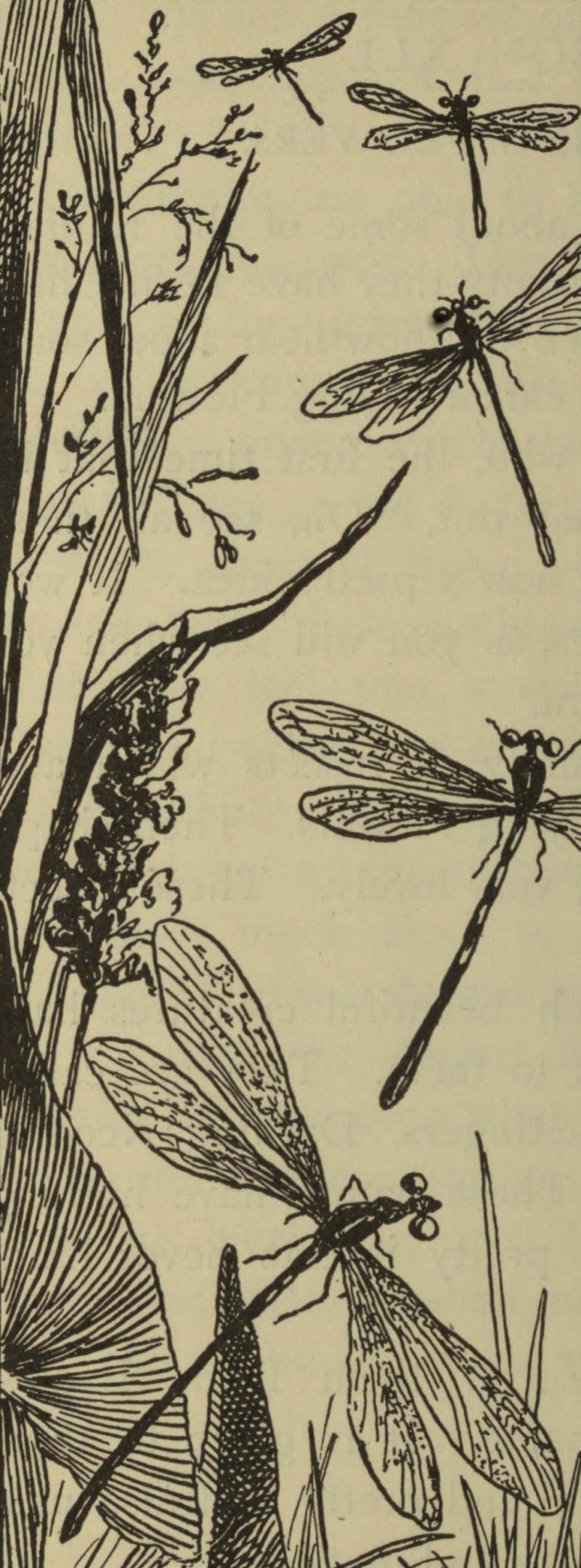
I knew a man who called these insects Air-Jewels. That was because they are almost always on the wing, and their eyes and bodies flash and shine like precious gems.
I have known silly people to start and scream when one of these dragon-flies came darting by. That was foolish; they might as well scream at a rose or a violet. There is no need of running away from one of them. The great trouble is that they are so swift and shy, you cannot easily catch one if you wish to examine it.
The dragon-flies are cousins of the[Pg 153] termites, the may-flies, and the lace-wing flies. They have four large, fine, lace-like wings, divided into a great many spaces or meshes.
The two pairs of wings are nearly or quite equal in size. The head is large. The body is long and light. They are very active in their motions, and are very seldom at rest. They fly so swiftly that you can scarcely see their thin wings, but only the flash of their bright-colored bodies.
Dragon-flies like damp or wet places. You will find them above lakes and ponds. They fly over marshy places or by the edges of quiet streams.
Go out to some still, silver-like pond, where the tall trees stand in a ring about the water. The ferns, the tall yellow spikes of the St. John’s-wort, and the blue clubs of the arrow-plant make a wreath around the sandy margin. There you will see hundreds of gay dragon-flies darting up and down. They swing in the sunbeams, as if glad to be alive.
In their great beauty the dragon-flies are as pretty as the butterflies. Like them, they love the sunshine. They are the children of the summer time. The hotter the weather, the happier the dragon-flies seem to be.
Let us look for a little time at a dragon-fly. It belongs to the class of the ring-made creatures. Its body is made in rings, and its feet and legs are[Pg 154] jointed. The body is very long and slim. Some kinds of dragon-flies have the body rather flat, but usually it is round, is slimmest in the middle, and thickens a little both at the tail and where it joins the breast.
The wings of the dragon-fly are horny and of iris or golden hues. Sometimes the body is a vivid blue or bright green. Sometimes it is banded or spotted with yellow or scarlet.
The wide wings look like delicate lace spread on a fine frame. A little child who found one of these wings, brought it to me, saying, “I dot a dood piece of lace!”
The head of the dragon-fly is large, and has on each side what you would call a great eye. But like that of the house-fly, this eye is made up of many eyes set so as to seem to be one. I hardly dare tell you how many there are—over twelve thousand! Through these wonderful eyes the light plays and flashes like fire. Between these big eyes three little simple eyes are set in a band across the head.
The dragon-fly has a queer mouth. The jaws are hidden under two thin, skin-like lips. These move up and down as it eats. It does not suck food, like the butterflies and house-flies, but eats after the manner of the beetle.
[Pg 155]
Thus, you see, the dragon-fly belongs to the great Division of the Eaters, not of the Drinkers. Instead of feeding on nectar, as we would think so lovely a thing should, it eats insects.
All its life long, from the egg, it is always greedy, because it is always hungry. It spends all its time hunting for food. Who could count how many small insects a dragon-fly, eats in his short lifetime?
[20] See Seaside and Wayside, No. 3.
UNDER THE WATER.
Now let us hear the story of the dragon-fly from its beginning. While it is an egg, a larva, and a pupa, it lives under the water. Only when about to burst from the pupa-case, and at last get its wings, does it leave the water and seek the upper air.
In all its early stages the dragon-fly lives in cool, still shallows, among green and graceful water-plants. There the sunshine glows all about it, as it darts over the bottom of the pond, hunting for food.
The mother dragon-fly, as she flits over the water, drops her eggs upon it. They sink to the bottom. She may put them into plant stems.[Pg 156] Their cases are waterproof. If the eggs are not eaten up by beetles and other fellow-citizens under water, they are quite safe, and soon the larvæ hatch out.

Most insects move quickly in the larva state, and are dull or quite asleep in the pupa-case. This is not the way with the dragon-fly. He is busy and strong all his life. The egg settled upon the pond bottom is quiet; the larva moves about, but is rather slow and lazy. The pupa dashes here and there, and frightens all the little animals in the pond. At last the perfect insect rises on the wing. It darts about with almost the swiftness of light.
[Pg 157]
The larva of the dragon-fly is gray. It has six legs. It is always hungry, and feeds on small water-animals, as beetles, grubs, shrimps, leeches, and their young.
This larva does not run after its food, but lies waiting for it. On the bottom of the pond, hidden in the shadow of a leaf, root, or stone, or seated on stems or leaves that are under water, the larva waits patiently for its prey to come by.
Did you ever see a person with a net for catching insects? This net is a fine bag set on a little hoop. The hoop is fastened upon a long handle. Sometimes the handle has joints, and will fold up. As insects dart by, the person with the net brings it down over them with a quick motion.
The dragon-fly larva has something much like this with which to catch its food. The lower jaw is fastened by a hinge to a little jointed rod. The rod, and the jaw-plate upon the end of it, when not in use, are folded down upon the head of the insect.
The plate has fine teeth upon its edge. When the prey comes by, the larva snaps out its rod, with the plate, as if they both were on a spring, and so catches the things that are swimming along a little way off. They do not see their foe, and do not know that he can reach so far with his sweep net.
The teeth on the edge of the plate shut up, and[Pg 158] then the rod folds back, and puts the food into the hungry larva’s throat. I suppose the little creatures that swim along feel quite happy and safe, and then, all at once, out springs this weapon, and they are gone.
But this little plague of the pond is not quite safe himself. There are some other creatures down under the water that eat him. All nature is a kind of game of “tit for tat,” you see.
The larva of the dragon-fly breathes air. He has no lungs as you have, but gills as a fish has. How does he get air?
Through his body goes a long tube. The tube ends in a horny point at the tail. This point is made of five very fine spikes. These spikes and this tube are able to take from the water some of the air that is in it. Thus he gets air much as a fish does.[21]
This spike on the tail of the larva has a very strange use. It shoots out the water which it has taken in, as you would shoot water from a squirt-gun. It shoots the water out with such power that it drives the larva along in the water.
Did you ever see a steamboat driven through the water by a screw or wheel at the stern, or hind part? What do you think that the man who first[Pg 159] made such a boat said? He said that he took his idea of how it should be made by seeing this queer larva move in the water.
When this creature seizes food, he likes to strike it from below. He rises under it in the stroke, as the shark does. Dragon-fly larvæ are very bold. They can eat large and hard insects.
When the larva changes to a pupa, it becomes more lively, fierce, and hungry than ever. It does not change its form at this time as much as most insects do.
The dragon-fly pupa has six legs, and each foot has strong hooks on it. Its color is pale brown, clear and shining, and its case is horny. Some rings of the body have horny spikes upon them. Upon the case of the chest is a pattern like wings.
These pupæ dash about the bottom of the pond, swimming or running, and eat almost everything that lives there. The body and head of the pupa are thicker than those of the grown-up dragon-fly. They are made for seizing and killing prey.
When it is nearly time for the pupa to come out as a dragon-fly, the case grows clearer, like glass. The large, beautiful eyes grow brighter and brighter, and the pupa leaves the deeper part and gets near the edge of the pond.
[21] See Seaside and Wayside, No. 3. Lessons on Fish.
[Pg 160]
A HAPPY CHANGE.

When the close of the pupa state draws near, the coming dragon-fly loses its fierce appetite. It seems to feel tired and heavy. It breathes slowly, as if it could not get air enough. The body has changed inside the horny case, and the time is near when it will leave the water for air, and walking for flying.
Once the larva wanted nothing better than to chase bugs about under water. Now, all at once, it longs for the free air and for the sun. It needs no one to tell it what to do. In some way it knows exactly how it should act.
This tired pupa now seeks the stem of some tall reed or grass that grows in the water. Slowly it crawls up the stem. The hooks on the feet take fast hold as it goes, and it keeps on until it is nearly a yard above water.
The hooks, though very small, are so sharp and hard that they can go into wood. When the pupa is as high up as he wants to be he drives the hooks into the stem. Thus it will hold firm even when it twists and struggles hard.
The pupa likes best to find two reeds or stems[Pg 161] near, so that it can take hold of both and swing between the two. Then, like a child in a swing, it begins to sway to and fro. Now, as it sways, a strange thing happens. The hard pupa-case splits open upon the back, and look, inside the case, we see the perfect insect, with its wings!
The pupa-case is firmly held by its hooked feet, while the new insect twists and pulls, and so gets free; and little by little its head, legs, wings, and long body come forth, and finally hang only by the last ring of the body.
Then you would think it was dead. For after it stretches out first one leg and then the other, it hangs by its last ring, stiff and still. But it is only resting. After about fifteen minutes it awakes. Taking hold firm with[Pg 162] its feet upon a stem or leaf, it lets go its hold upon the pupa-case. That is left hanging by its hooks in its place.
Here is now a dragon-fly, with large head, with two great cluster eyes, six legs, four wings, and long, bright-hued body! And now, at last, it can breathe freely through all those tubes and air-holes you have been told about.
Still the insect does not look like the full-made dragon-fly. The colors are dull, and the wings are folded up. The body is soft, damp, and too short. The big eyes are dim.
As if half asleep it still clings to the stem, not far from the case, which is the old shape of itself. Hanging to the reeds by the pond you will often find these old coffins, if you look for them.
The new insect is drawing in the sunshine and fresh air. It stands still and breathes hard, filling its new body with pure, dry air. Now and then its wings quiver.
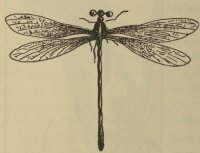
[Pg 163]
As they quiver they spread out, fold after fold, as silken banners wave out upon the air. Then at last they are spread out wide, in all their beauty. The dragon-fly has reached its last and highest state. It can sail away where it pleases on its new wings.
As the wings grow larger, the eyes of the dragon-fly grow brave and bright; its body dries. Then it gleams like a jewel. Its fresh colors come out clearly. It feels strong and active.
Then, all at once, it uses its new wings. It rises into the air and flashes here and there, just as hungry and ten times swifter than ever before.
The flight of the dragon-fly is called hawking, for it is like the motion of that strong bird, the hawk. If it gets caught in a place where its wide wings cannot turn, it can fly backwards and get off safely. In a place where the wings might be injured by striking against leaves or branches, it flies out in this way.
When dragon-flies are dead, the great beauty of their bodies passes away. They fade and grow dull, as when they first came from the pupa-case. The scarlet, yellow, blue, or green turns to a dull drab. So you cannot keep them as well as you can keep beetles. It is life that gives the dragon-fly its splendid beauty.
[Pg 164]
THE DRAGON-FLY AND HIS COUSINS.
The dragon-fly eats almost every kind of insects which you have thus far read about. Beetles, spiders, flies, centipedes, fresh-water shrimps, and polliwogs are its food.
The dragon-fly is a larva for a year. It is a perfect dragon-fly only a part of one summer. You will find the most dragon-flies in July or August. When the frost comes, they die.
Dragon-flies are very strong; they are fond of chasing other insects. They seem to catch and tear them for the mere pleasure of pulling them to pieces. They also fight with each other, and Mr. and Mrs. Dragon-fly have some hard battles.
The dragon-fly does not have a long lip, or mask, set on a rod, as the larva had. They fly so swiftly that they do not need such help in getting food.
Few insects are so easy on the wing as this, and few have such beauty of wing. Yet I think, after all, that the chief beauty of the dragon-fly is in its eyes. These are like two great flaming jewels.
The eyes are beautiful, for this clear, glowing light in them; the body, for vivid color; the wings, for their lace-like texture. Each of the wings has a[Pg 165] dark spot on the front edge. Often, in flying, this spot and the line of bright color of the body, almost like a streak of fire, are all that can be seen of the insect.
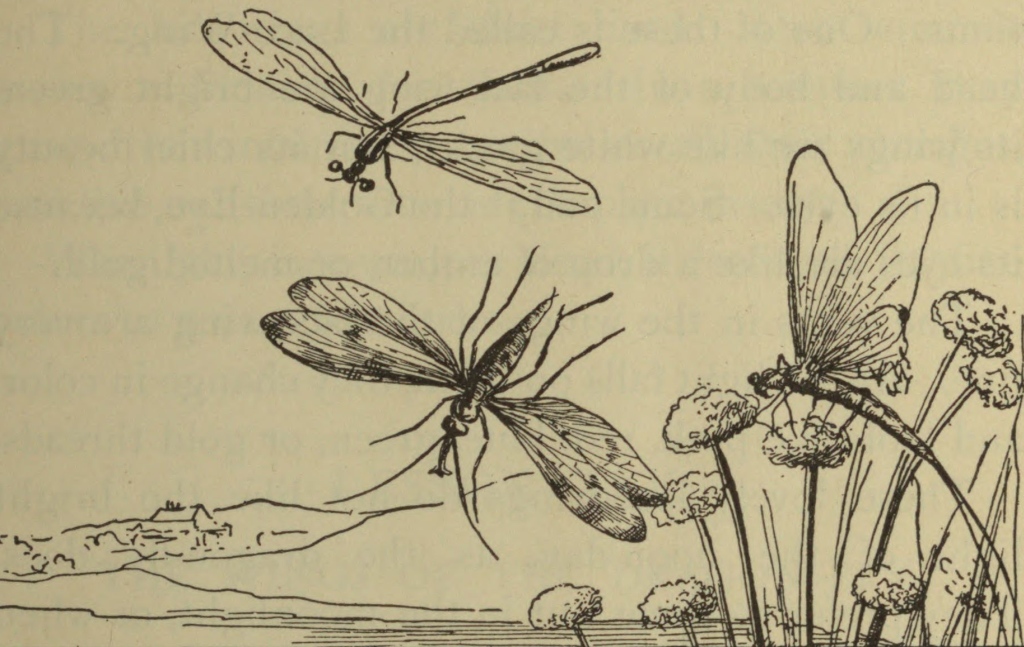
There are several kinds of dragon-flies. These are different in color and size, and in the shape of their bodies. One, with a very long, thin, dark body, is called the Darning-Needle. One, with a thicker body, is called the Ringed-Club. Its body is largest at the tail end. This one is dressed in black and gold, and is large and strong.
A smaller kind of dragon-fly, which has no spots on the wings, is called the Little Lady. This is[Pg 166] among the prettiest of all; some of them are bright red; some a clear light blue. They look more like creatures in some dream about fairies, than like real live insects, for they flit here and there like streaks of gay-colored light, and you can scarcely see the wings on which they fly.
The dragon-fly has some very handsome relations. One of these is called the Lace-Wing. The head and body of the lace-wing are bright green, its wings are like white gauze; but its chief beauty is in its eyes. Some call it the Golden-Eye, because its eyes are like a drop of amber, or melted gold.
The veins in the wings of the lace-wing are very fine. As the light falls on them, they change in color, and look like pink, red, blue, green, or gold threads.
These lovely lace-wings do not like the bright light of the noon-day, as the dragon-fly does. They prefer to come out in the moonlight, or when the sun is setting.
The lace-wing is not a water lover, as the dragon-fly is. It lays its eggs on leaves, and every egg is held upon a little silken stem. The stem is much like the silk which the spider spins. These eggs are laid in groups.
When the young lace-wings come out of the eggs, they feed on the little aphis. You remember the aphis makes the honey that ants are so fond of.
[Pg 167]
In two weeks these larvæ change to pupæ. To do this the lace-wing larva spins a nice silk ball, in which it goes to bed for a nap while it is a pupa.
In this, you see, it is not at all like the young dragon-fly, which hunts and runs about while it is a pupa. The ball of the sleeping lace-wing is about the size and shape of a wild pea, or vetch seed.
The lace-wings are short lived. One summer makes a lifetime for them. In a summer they grow from infancy to age, make all their changes, and live out their time as complete insects.
When the lace-wing is dead, it loses all its fine colors in a very few hours.
THE WINGS OF THE DRAGON-FLY.
We can find no better example than the dragon-fly, of the way in which insects behave when they leave the pupa-case.
You know that this case is horny or tough, and always seems smaller than the grown-up insect; so the insect must be very closely packed in.
No person could pack a new insect back into the case it has just left.
While the dragon-fly pupa is under water, the[Pg 168] case is kept tough, and yet soft enough to bend. But when the pupa crawls up the stem of the plant into the air, the case soon dries and becomes brittle.
As the fly struggles within, the dry case will easily split. The little wet coat, which covers the body while it is in the case, makes it more easy to slip out of the shell when it cracks open. You know if you have on your finger a ring which is too tight, you can pull it off if you wet your finger.
The wet coat of the fly in the case keeps the wings from being hurt by their close folding. After they are dry and spread out, they are easy to break. Then it is very easy to hurt or spoil them.
The fly seems to know this, and is careful of its wings. In the act of unfolding, the fly holds its wings from touching any object, even its own body.
When the dragon-fly gets free from the case, it knows just how to spread its lovely wings into perfect shape. It stands quite still, and far enough from stems or leaves to keep its wide wings safe.
It does not move its wings, but lets the air do the work, while it holds its bent body away from the wings. The quiver you see through it, now and then, is a motion of the body; and I will soon tell you what it means.
When the fly first comes from the case, its wings are soft, and will bend as easily as wet paper.[Pg 169] After they are dry, they are like thin plates of glass. These wings have very many nerves through them. Their frame is like a fine net-work, and, as it is touched by the air, it spreads slowly to its full size. If, at this drying-time, the wings are hurt, they will never come to their right shape.
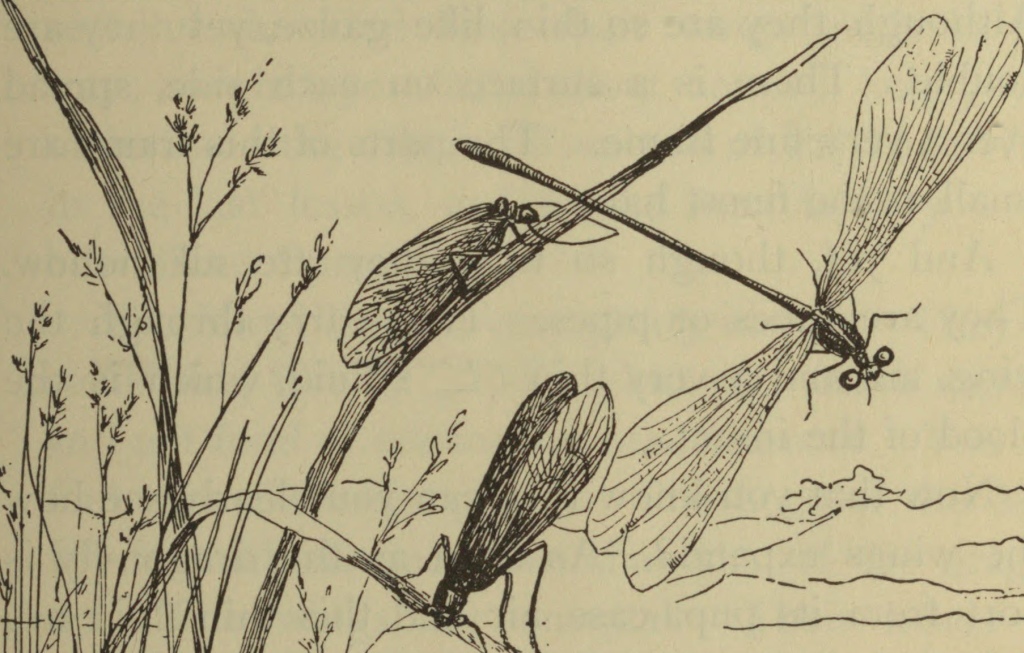
If any one should try to help a dragon-fly out of its case its wings would be ruined and never take their right shape. Human hands are too clumsy for such work.
When first the pupa comes from the case, the wings and body are of a dull, faded color. But as it stands in the sun and air, you can see it change from minute to minute.
[Pg 170]

Fold after fold of the wings shakes out; ring after ring of the body stretches to its proper length; the joints of the legs come to their right shape and firmness. From all the body of the insect a mist seems to pass away; and the colors of the fly come out, and red, blue, green, gold, shine in beauty.
Now let us look closely at these fine wide wings. Although they are so thin, like gauze, yet they are double. There is a surface on each side, spread over a very fine frame. The parts of this frame are small as the finest hairs.
And yet, though so tiny, they are all hollow. They are tubes or pipes. They carry through the wing, air and a very thin white fluid, which is the blood of the insect.
Now that you know this, can you clearly see how the wings expand? As soon as the dragon-fly is born from its pupa-case, air and this thin fluid are driven through these fine tubes. As they fill, they stretch out, and the thin surface which covers them spreads with them.
If you notice the fly as it is thus getting its shape, you will see that quiver which I spoke of. That motion is the pumping of air and fluid through its tubes; and, no doubt, by this action the fly spreads out its wings and its body. By such a motion the blow-fly spreads out its big head.
[Pg 171]
The dragon-fly spends about fifteen minutes in getting into shape. Sometimes half an hour is needed. After that, the fly rests for an hour or two, before it tries its wings in the air. Very likely it wishes to give its wings time to get quite firm and hard.
Butterflies, Lace-Wings, May-Flies, and other insects of the kind have their wings made in this way; so what you learn about one will help you to understand the others. You read of the Lace-Wing in the last lesson, and in the next book you will hear about Butterflies.
The May-Flies are very pretty insects. They are something like dragon-flies, but very much smaller, and not fond of tearing up other insects. You will find them in moist places. The body of the May-Fly is much slimmer even than that of the dragon-fly. The wings are unequal. Their heads are smaller. May-Flies have two fore legs, nearly as long as the body, held almost straight out as they fly. On their tails they have three long stiff hairs, twice as long as the body. These hairs spread out, fan-shape.
These insects are often called May-Flies, because they usually come in May. But they have another name, which means the “child of an hour.” This name is given them because they seldom live longer[Pg 172] than one day, and often only for an hour or two. In the egg, larva, and pupa they live about two years; but, once born with wings, they soon die.
And how do they spend that short life? They do not eat, for they have no mouths. As they are not hungry, they do not hunt. They spend their whole time in flying. Their flight is a sort of dance in the air; they rise and fall, and spin about.
Great numbers of them come out together, spin about, and drop their eggs in the water. But soon they flutter down, dead, among the grasses. That is[Pg 173] the story of the pretty May-Fly. I have been on a large island on a day when May-Flies had come out: the air was full of their shining silver shapes—they lit on people’s clothes, and seemed to cover them with a gauze veil.
Would you not like to seek out in their homes, and then read and study about, the very many strange and wonderful insects that are in the world?
I. THE ANT.
1. Describe an insect.
2. How are the wings of hook-winged insects fastened together in flight?
3. Describe an ant.
4. Describe queen ants and worker ants.
5. What becomes of the queen ant’s wings?
6. Tell me how an ant-hill is begun.
7. Describe an ant-hill.
8. Tell how nurse ants care for baby ants.
9. What can you say of soldier ants?
10. How do the ants make slaves?
11. What insect is called the “ant’s cow”?
12. Tell me about the ants and their cow.
13. How does the ant dress and cleanse its body?
14. What do you know about the farmer ants?
15. What kinds of food do ants eat?
[Pg 174]
16. How do ants eat?
17. Tell me how ants bury their dead.
18. What do you think about termites, or white ants, being of the same order as other ants?
19. What do you know about parasol ants?
20. How do ants move from one hill to another?
21. Describe the march of an ant army.
22. What do you know about ant acid?
23. What is the opening into an ant-hill called?
24. Have ant-hills more than one gate?
25. What do you mean by a queen ant?
26. How do ants treat each other while they are at work?
27. What becomes of ants during winter in cold countries?
28. Of what use are ants?
29. How can you study ants for yourselves?
30. How do ants carry things?
II. THE EARTH-WORM.
1. To what family of creatures does the earth-worm belong?
2. What can you say about a ring-made creature?
3. How do the rings in a worm’s body increase in number?
4. Has a worm any eyes, or ears, or nose?
5. Tell me about a worm’s mouth.
6. What kind of food does he eat?
[Pg 175]
7. How does he eat his food?
8. What has he inside his body to help grind his food?
9. Tell me about the worm’s veins.
10. Is a worm “alike at both ends”?
11. What has he at each end?
12. If a worm is cut in two will both parts live?
13. What has the worm instead of feet?
14. What makes the worm’s body so dark?
15. Why is it so hard to pull a worm out of its hole?
16. Tell me how a worm makes its hole.
17. Why does the worm fill itself with earth?
18. What are worm-casts?
19. How do worms help to build the world?
20. What kind of weather do worms like best?
21. How does a worm close up the door of its hole?
22. What becomes of worms in very hot, dry weather?
23. When can you find worms outside their holes?
24. Of what use are worms?
25. Can you tell me about seaside worms?
26. What kinds of houses do tube-worms make?
27. Can earth-worms feel?
28. Do they harm crops or grass?
29. Is there any worm which has teeth?
[Pg 176]
III. THE FLY.
1. How many wings has a fly?
2. What has a fly instead of the second pair of wings?
3. Tell me about a fly’s eyes.
4. Describe a fly’s mouth.
5. Does a fly chew or suck its food?
6. What care does the mother-fly take of her eggs or her young?
7. Do flies have queens or live in swarms, as bees do?
8. Where do flies place their eggs?
9. What can you tell me of the changes from the egg to the full-grown fly?
10. How does the fly come from the pupa-case?
11. What things do flies eat?
12. How is it that a fly can run up a pane of glass?
13. How can a fly walk on a ceiling?
14. Will you describe the fly’s feet?
15. How does the fly make its buzzing sound?
16. What is a box-fly?
17. Tell me of some of the queer ways of flies.
18. What do flies do when cold weather comes on?
19. What do we mean by a swarm of flies?
20. Of what use are flies?
21. What harm do flies do?
22. Tell me of some of the fly’s enemies.
23. Is a Spanish fly a true fly?
[Pg 177]
24. At what part of a fly’s life is it like a worm?
25. What is a fly in amber?
26. Tell me the names of some kinds of flies.
27. Why do people dislike flies?
IV. THE BEETLE.
1. Into what two classes are insects divided because of their way of taking food?
2. To what family of insects does a lady-bird belong?
3. With what is a beetle’s body covered?
4. In what is a beetle like a crab?
5. Describe a beetle’s wing-covers.
6. Where are the beetle’s flying wings?
7. What does the beetle do with his wing-covers when he flies?
8. Describe a beetle.
9. What can you say of Mr. Beetle’s colors?
10. Which is the largest family of insects?
11. Why have people studied beetles so much?
12. What changes does the beetle make before he is full-grown?
13. How much time do some beetles spend as eggs, larvæ, and pupæ?
14. Where are the eggs of beetles laid?
15. Describe a beetle larva.
16. How does this “white worm,” or larva, behave?
17. Does any larva ever have wings?
18. How is the pupa packed in the pupa-case?
[Pg 178]
19. Where will you be likely to find beetle larvæ and pupæ to study?
20. What does larva mean?
21. What does pupa mean?
22. Tell me how insects breathe.
23. How do beetles injure plants?
24. Describe a rose beetle.
25. What can you tell me about giant beetles?
26. In what country does the prince of beetles live?
27. How do beetles make a noise or tune?
28. Tell me how a sexton beetle buries a mouse or a bird.
29. Why do they do this?
30. How does the pill beetle make a place for her eggs?
31. Of what use are beetles?
32. Who can tell me about a stag beetle?
33. Do all stag beetles have horns?
34. Tell me about the short-coat beetles.
35. Give me the history of the water beetles.
36. What about the beetles that eat furs and clothes?
37. What do beetles eat?
V. THE BARNACLE.
1. What did the old fisherman say of the number of barnacles?
2. Do horse-hairs ever become worms?
[Pg 179]
3. What was the old fable about a bird coming from a barnacle?
4. What two kinds of barnacles are there?
5. What does an acorn barnacle look like?
6. At what part of a barnacle’s life does he sail about?
7. When does he fasten to one place for life?
8. Describe a stem barnacle.
9. What does the Latin name of the barnacle family mean?
10. What harm can barnacles do to ships?
11. How do barnacles get their food?
12. Describe a barnacle fishing party.
13. What does a barnacle moult as he grows?
14. How do the shell plates of a barnacle become larger?
15. Are barnacles ever eaten?
16. How long can barnacles live out of water?
17. What does a barnacle eat?
18. What is Mr. Barnacle’s fishing-net?
19. What holds a barnacle fast to a rock?
20. At what part of his life is a barnacle like a crab?
21. Where is Mr. Barnacle’s eye?
22. Where is the head part of a stem barnacle?
23. Where are the barnacles’ eggs before they get loose in the water?
24. What can you say of the size of barnacles?
25. What color are barnacles?
[Pg 180]
26. Tell me what changes a barnacle makes during his life.
27. Describe a barnacle when in the larva state.
28. When we mean more than one larva, what do we say?
29. When we mean more than one pupa, what do we say?
30. What sound do we give the æ in these words? (An e sound.)
VI. JELLY-FISH.
1. What are some of the names given to jelly-fish?
2. Why are they called jelly-fish?
3. Why are they called nettles?
4. Why are they given the names of flowers?
5. Can a jelly-fish live out of water?
6. At what part of its life does a jelly-fish grow fast in one place?
7. What do jelly-fish eat?
8. How do they get their food?
9. What are the fishing-lines of a jelly-fish?
10. How does a jelly-fish move through the water?
11. Where are its eyes?
12. Where is the mouth of a jelly-fish?
13. Where are its ears?
14. Why have jelly-fish been called sea-lamps?
15. What can you say of jelly-fish?
[Pg 181]
16. Tell me of the shape and color of some one jelly-fish.
17. On what plan is the body of a jelly-fish made?
18. To what family do the jelly-fish belong?
19. Which of you can draw the plan of the radiates on the blackboard?
20. Has the jelly-fish much water in its body?
21. Can you tell me of what shapes jelly-fish are?
22. What are some of the names which they get from their shapes?
23. What do you know about jelly-fish before they swim about?
24. What are the long arms of the jelly-fish called?
25. How many rays are there in the jelly-fish pattern?
26. How do the eyes of jelly-fish differ?
27. Did you ever see a jelly-fish in the ocean?
28. What does the light of jelly-fishes look like in the water?
VII. THE STAR-FISH.
1. To what family does the star-fish belong?
2. How many rays have most star-fish?
3. How many rays has the sun-star?
4. What can you tell me about the brittle-star?
5. How do the brittle-stars break into pieces?
6. What kind of coat or skin has the star-fish?
[Pg 182]
7. Where is its mouth?
8. Do star-fishes swim or crawl?
9. What do they eat?
10. What colors have star-fish?
11. How does the cross-star-fish hatch its eggs?
12. What does the star-fish look like when it leaves the egg?
13. Which one star-fish grows fast for the larva state?
14. Tell me about the quills on the under side of the star-fish.
15. How many kinds of star-fish can you describe?
16. How many families of star-fish are there?
17. What is a sea-cucumber?
18. Draw on the blackboard the sea-egg pattern.
19. What is a sea-egg or sea-urchin?
20. To what family does it belong?
21. Tell me about the urchin’s overcoat.
22. Describe its quills and suckers.
23. Tell me about the size and color of urchins.
24. How does the urchin’s shell increase in size?
25. Where is its mouth?
26. Can urchins bore holes in rock? Tell me about that.
27. How does the urchin walk and climb?
28. Are urchins and sea-cucumbers ever eaten?
29. Describe an urchin shell when the quills are gone.
[Pg 183]
VIII. THE DRAGON-FLY.
1. What insects have we called flying flowers?
2. What are some of the names given to dragon-flies?
3. Can a dragon-fly do you any harm?
4. What cousins has the dragon-fly?
5. Describe a dragon-fly.
6. What kind of places and weather do dragon-flies like?
7. What do they eat?
8. What has the flight of dragon-flies been called?
9. Tell me about the dragon-fly’s wonderful eyes.
10. Is the dragon-fly an eater or a drinker?
11. Where does the dragon-fly live while egg, larva, and pupa?
12. How do the eggs get into the water?
13. Tell me about the dragon-fly pupa.
14. Tell me about the queer mouth of the larva.
15. Tell me how he catches his food.
16. How does the larva get air while he lives under water?
17. Where did the pattern of a stern wheel, or screw boat, come from?
18. How does the pupa-case change before the dragon-fly comes out?
19. Tell me how the pupa leaves the water when it is to change its state.
[Pg 184]
20. What can you say about the hooks on its feet?
21. In what way does the pupa get free of its case?
22. Tell me about the wings of the dragon-fly.
23. What care does it take of its wings?
24. How long does the dragon-fly live in the larva state?
25. How long does it live in the perfect state?
26. What can you say of the way the dragon-fly hunts insects?
27. What dragon-fly is called “The Little Lady”?
28. Tell me about a lace-wing fly.
29. Where are the lace-wing’s eggs laid?
30. What do lace-wing larva eat?
31. How long do lace-wings live?
32. Do dragon-flies and lace-wings keep their colors when dead?
33. Tell me how the new dragon-fly expands its wings.
34. Why will the wings bend when they first come from the case?
35. What can you tell me about May-Flies?
36. How long do they live in the perfect state?
37. Do they eat? How do they spend their short lives?
Transcriber’s note
Inconsistencies in hyphenation have been standardized. The following printer errors have been changed.
| CHANGED | FROM | TO |
| Page 170: | “bor from its pupa-case” | “born from its pupa-case” |